CHCDIS002 Follow established person- centred behaviour supports
VerifiedAdded on 2023/01/18
|57
|10031
|58
AI Summary
Contribute Materials
Your contribution can guide someone’s learning journey. Share your
documents today.
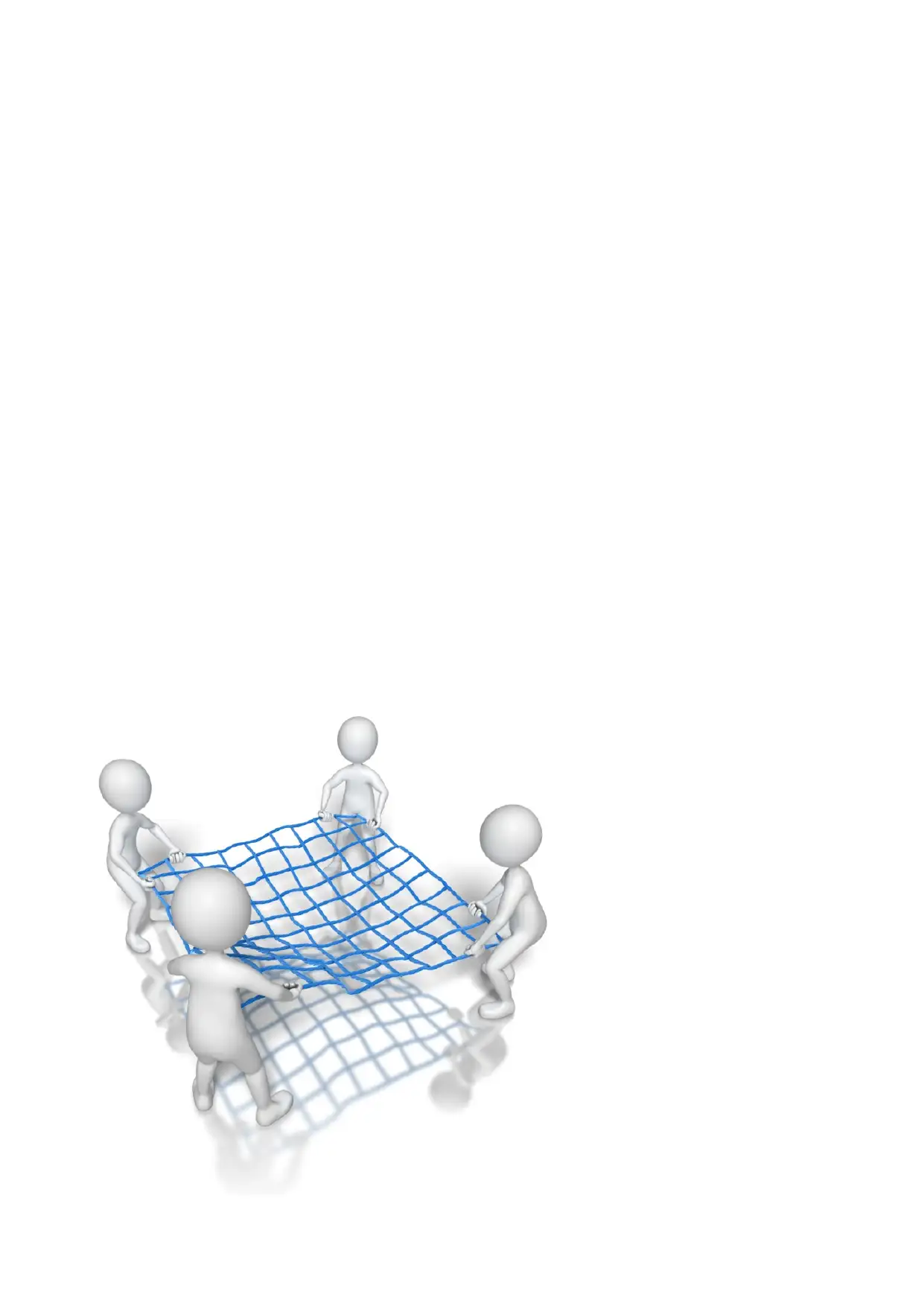
Secure Best Marks with AI Grader
Need help grading? Try our AI Grader for instant feedback on your assignments.
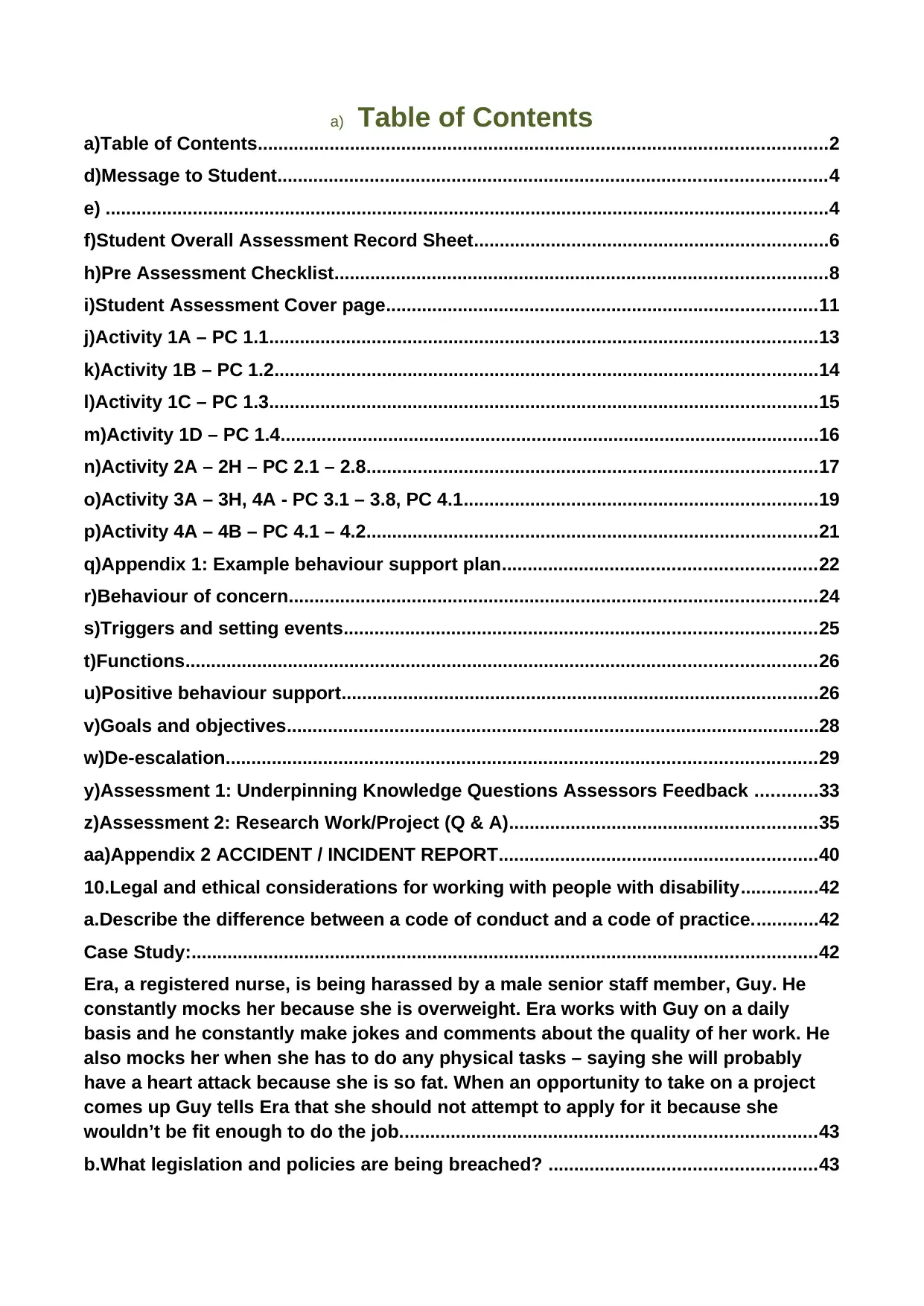
a) Table of Contents
a)Table of Contents...............................................................................................................2
d)Message to Student...........................................................................................................4
e) .............................................................................................................................................4
f)Student Overall Assessment Record Sheet.....................................................................6
h)Pre Assessment Checklist................................................................................................8
i)Student Assessment Cover page....................................................................................11
j)Activity 1A – PC 1.1...........................................................................................................13
k)Activity 1B – PC 1.2..........................................................................................................14
l)Activity 1C – PC 1.3...........................................................................................................15
m)Activity 1D – PC 1.4.........................................................................................................16
n)Activity 2A – 2H – PC 2.1 – 2.8........................................................................................17
o)Activity 3A – 3H, 4A - PC 3.1 – 3.8, PC 4.1.....................................................................19
p)Activity 4A – 4B – PC 4.1 – 4.2........................................................................................21
q)Appendix 1: Example behaviour support plan.............................................................22
r)Behaviour of concern.......................................................................................................24
s)Triggers and setting events............................................................................................25
t)Functions...........................................................................................................................26
u)Positive behaviour support.............................................................................................26
v)Goals and objectives........................................................................................................28
w)De-escalation...................................................................................................................29
y)Assessment 1: Underpinning Knowledge Questions Assessors Feedback ............33
z)Assessment 2: Research Work/Project (Q & A)............................................................35
aa)Appendix 2 ACCIDENT / INCIDENT REPORT..............................................................40
10.Legal and ethical considerations for working with people with disability...............42
a.Describe the difference between a code of conduct and a code of practice.............42
Case Study:..........................................................................................................................42
Era, a registered nurse, is being harassed by a male senior staff member, Guy. He
constantly mocks her because she is overweight. Era works with Guy on a daily
basis and he constantly make jokes and comments about the quality of her work. He
also mocks her when she has to do any physical tasks – saying she will probably
have a heart attack because she is so fat. When an opportunity to take on a project
comes up Guy tells Era that she should not attempt to apply for it because she
wouldn’t be fit enough to do the job.................................................................................43
b.What legislation and policies are being breached? ....................................................43
a)Table of Contents...............................................................................................................2
d)Message to Student...........................................................................................................4
e) .............................................................................................................................................4
f)Student Overall Assessment Record Sheet.....................................................................6
h)Pre Assessment Checklist................................................................................................8
i)Student Assessment Cover page....................................................................................11
j)Activity 1A – PC 1.1...........................................................................................................13
k)Activity 1B – PC 1.2..........................................................................................................14
l)Activity 1C – PC 1.3...........................................................................................................15
m)Activity 1D – PC 1.4.........................................................................................................16
n)Activity 2A – 2H – PC 2.1 – 2.8........................................................................................17
o)Activity 3A – 3H, 4A - PC 3.1 – 3.8, PC 4.1.....................................................................19
p)Activity 4A – 4B – PC 4.1 – 4.2........................................................................................21
q)Appendix 1: Example behaviour support plan.............................................................22
r)Behaviour of concern.......................................................................................................24
s)Triggers and setting events............................................................................................25
t)Functions...........................................................................................................................26
u)Positive behaviour support.............................................................................................26
v)Goals and objectives........................................................................................................28
w)De-escalation...................................................................................................................29
y)Assessment 1: Underpinning Knowledge Questions Assessors Feedback ............33
z)Assessment 2: Research Work/Project (Q & A)............................................................35
aa)Appendix 2 ACCIDENT / INCIDENT REPORT..............................................................40
10.Legal and ethical considerations for working with people with disability...............42
a.Describe the difference between a code of conduct and a code of practice.............42
Case Study:..........................................................................................................................42
Era, a registered nurse, is being harassed by a male senior staff member, Guy. He
constantly mocks her because she is overweight. Era works with Guy on a daily
basis and he constantly make jokes and comments about the quality of her work. He
also mocks her when she has to do any physical tasks – saying she will probably
have a heart attack because she is so fat. When an opportunity to take on a project
comes up Guy tells Era that she should not attempt to apply for it because she
wouldn’t be fit enough to do the job.................................................................................43
b.What legislation and policies are being breached? ....................................................43
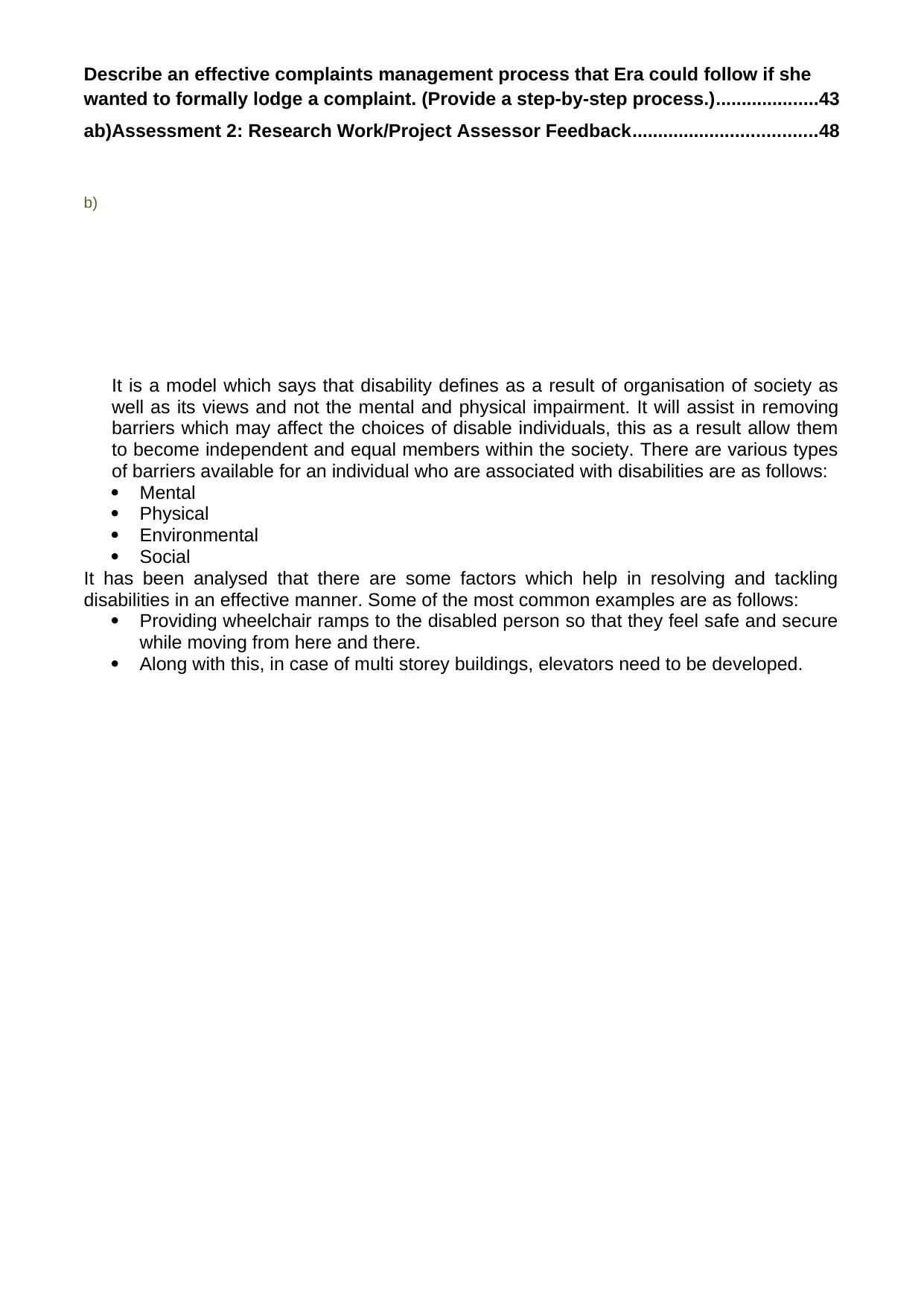
Describe an effective complaints management process that Era could follow if she
wanted to formally lodge a complaint. (Provide a step-by-step process.)....................43
ab)Assessment 2: Research Work/Project Assessor Feedback....................................48
b)
It is a model which says that disability defines as a result of organisation of society as
well as its views and not the mental and physical impairment. It will assist in removing
barriers which may affect the choices of disable individuals, this as a result allow them
to become independent and equal members within the society. There are various types
of barriers available for an individual who are associated with disabilities are as follows:
Mental
Physical
Environmental
Social
It has been analysed that there are some factors which help in resolving and tackling
disabilities in an effective manner. Some of the most common examples are as follows:
Providing wheelchair ramps to the disabled person so that they feel safe and secure
while moving from here and there.
Along with this, in case of multi storey buildings, elevators need to be developed.
wanted to formally lodge a complaint. (Provide a step-by-step process.)....................43
ab)Assessment 2: Research Work/Project Assessor Feedback....................................48
b)
It is a model which says that disability defines as a result of organisation of society as
well as its views and not the mental and physical impairment. It will assist in removing
barriers which may affect the choices of disable individuals, this as a result allow them
to become independent and equal members within the society. There are various types
of barriers available for an individual who are associated with disabilities are as follows:
Mental
Physical
Environmental
Social
It has been analysed that there are some factors which help in resolving and tackling
disabilities in an effective manner. Some of the most common examples are as follows:
Providing wheelchair ramps to the disabled person so that they feel safe and secure
while moving from here and there.
Along with this, in case of multi storey buildings, elevators need to be developed.
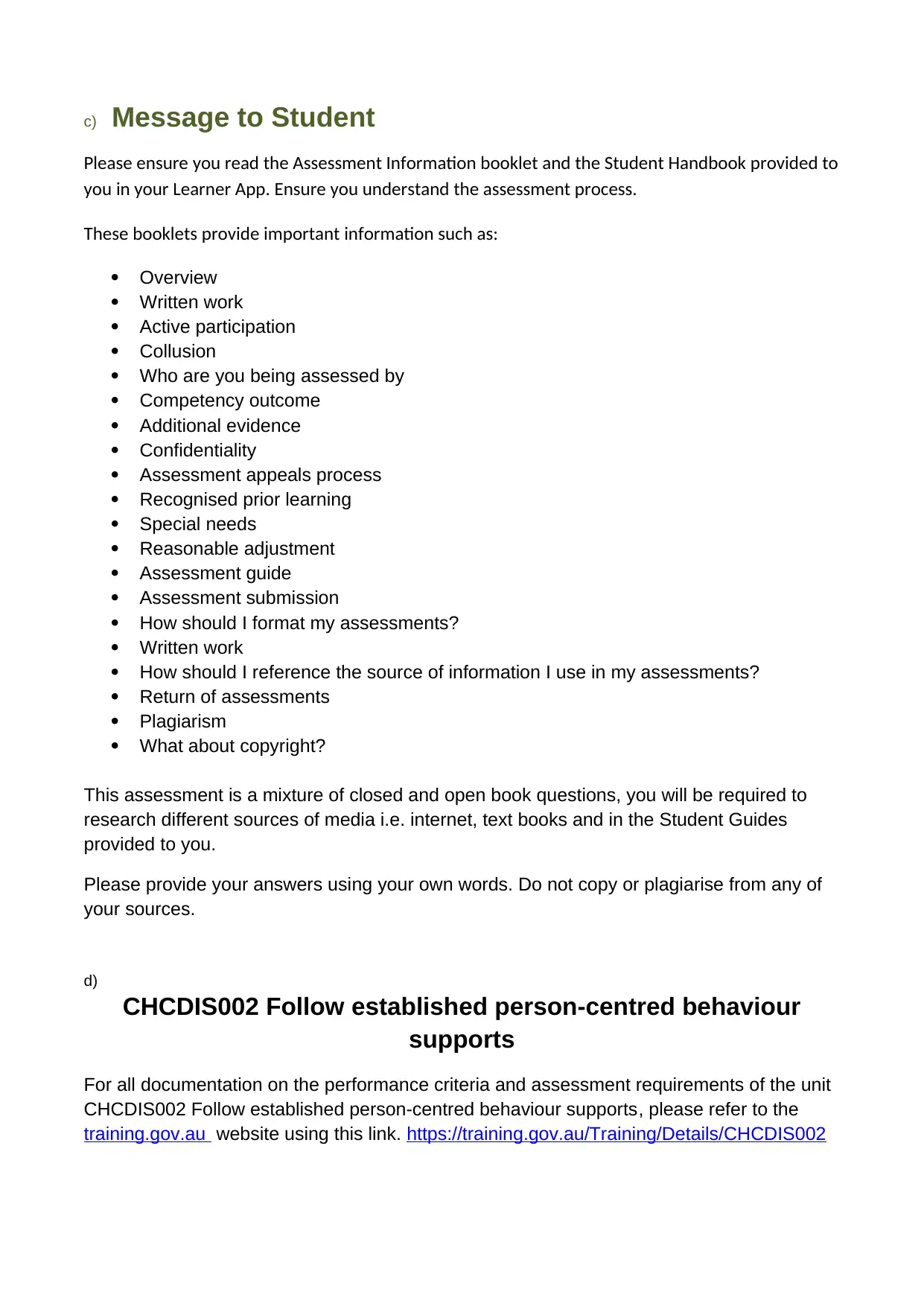
c) Message to Student
Please ensure you read the Assessment Information booklet and the Student Handbook provided to
you in your Learner App. Ensure you understand the assessment process.
These booklets provide important information such as:
Overview
Written work
Active participation
Collusion
Who are you being assessed by
Competency outcome
Additional evidence
Confidentiality
Assessment appeals process
Recognised prior learning
Special needs
Reasonable adjustment
Assessment guide
Assessment submission
How should I format my assessments?
Written work
How should I reference the source of information I use in my assessments?
Return of assessments
Plagiarism
What about copyright?
This assessment is a mixture of closed and open book questions, you will be required to
research different sources of media i.e. internet, text books and in the Student Guides
provided to you.
Please provide your answers using your own words. Do not copy or plagiarise from any of
your sources.
d)
CHCDIS002 Follow established person-centred behaviour
supports
For all documentation on the performance criteria and assessment requirements of the unit
CHCDIS002 Follow established person-centred behaviour supports, please refer to the
training.gov.au website using this link. https://training.gov.au/Training/Details/CHCDIS002
Please ensure you read the Assessment Information booklet and the Student Handbook provided to
you in your Learner App. Ensure you understand the assessment process.
These booklets provide important information such as:
Overview
Written work
Active participation
Collusion
Who are you being assessed by
Competency outcome
Additional evidence
Confidentiality
Assessment appeals process
Recognised prior learning
Special needs
Reasonable adjustment
Assessment guide
Assessment submission
How should I format my assessments?
Written work
How should I reference the source of information I use in my assessments?
Return of assessments
Plagiarism
What about copyright?
This assessment is a mixture of closed and open book questions, you will be required to
research different sources of media i.e. internet, text books and in the Student Guides
provided to you.
Please provide your answers using your own words. Do not copy or plagiarise from any of
your sources.
d)
CHCDIS002 Follow established person-centred behaviour
supports
For all documentation on the performance criteria and assessment requirements of the unit
CHCDIS002 Follow established person-centred behaviour supports, please refer to the
training.gov.au website using this link. https://training.gov.au/Training/Details/CHCDIS002
Secure Best Marks with AI Grader
Need help grading? Try our AI Grader for instant feedback on your assignments.
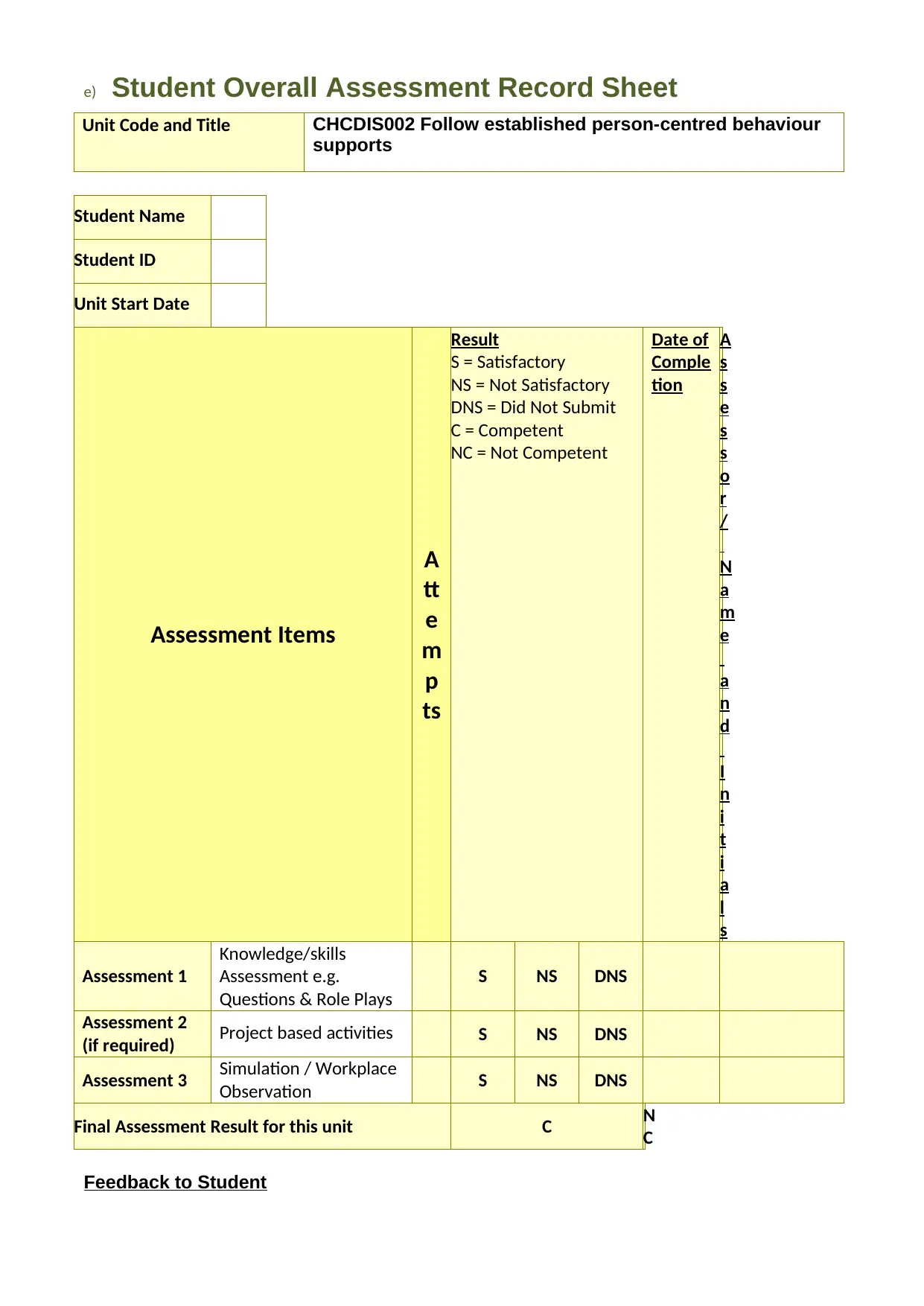
e) Student Overall Assessment Record Sheet
Unit Code and Title CHCDIS002 Follow established person-centred behaviour
supports
Student Name
Student ID
Unit Start Date
Assessment Items
A
tt
e
m
p
ts
Result
S = Satisfactory
NS = Not Satisfactory
DNS = Did Not Submit
C = Competent
NC = Not Competent
Date of
Comple
tion
A
s
s
e
s
s
o
r
/
N
a
m
e
a
n
d
I
n
i
t
i
a
l
s
Assessment 1
Knowledge/skills
Assessment e.g.
Questions & Role Plays
S NS DNS
Assessment 2
(if required) Project based activities S NS DNS
Assessment 3 Simulation / Workplace
Observation S NS DNS
Final Assessment Result for this unit C N
C
Feedback to Student
Unit Code and Title CHCDIS002 Follow established person-centred behaviour
supports
Student Name
Student ID
Unit Start Date
Assessment Items
A
tt
e
m
p
ts
Result
S = Satisfactory
NS = Not Satisfactory
DNS = Did Not Submit
C = Competent
NC = Not Competent
Date of
Comple
tion
A
s
s
e
s
s
o
r
/
N
a
m
e
a
n
d
I
n
i
t
i
a
l
s
Assessment 1
Knowledge/skills
Assessment e.g.
Questions & Role Plays
S NS DNS
Assessment 2
(if required) Project based activities S NS DNS
Assessment 3 Simulation / Workplace
Observation S NS DNS
Final Assessment Result for this unit C N
C
Feedback to Student
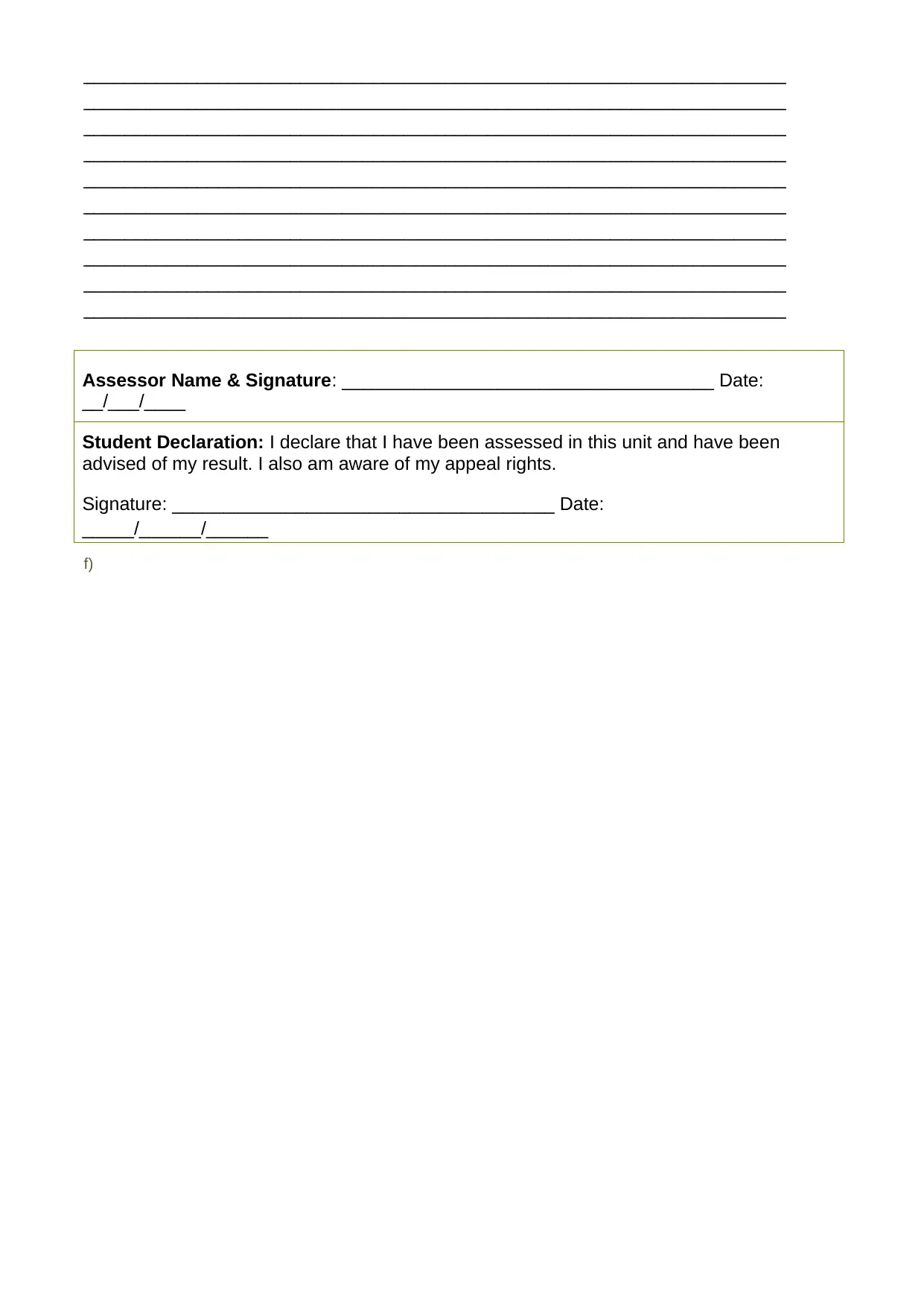
____________________________________________________________________
____________________________________________________________________
____________________________________________________________________
____________________________________________________________________
____________________________________________________________________
____________________________________________________________________
____________________________________________________________________
____________________________________________________________________
____________________________________________________________________
____________________________________________________________________
Assessor Name & Signature: ____________________________________ Date:
__/___/____
Student Declaration: I declare that I have been assessed in this unit and have been
advised of my result. I also am aware of my appeal rights.
Signature: _____________________________________ Date:
_____/______/______
f)
____________________________________________________________________
____________________________________________________________________
____________________________________________________________________
____________________________________________________________________
____________________________________________________________________
____________________________________________________________________
____________________________________________________________________
____________________________________________________________________
____________________________________________________________________
Assessor Name & Signature: ____________________________________ Date:
__/___/____
Student Declaration: I declare that I have been assessed in this unit and have been
advised of my result. I also am aware of my appeal rights.
Signature: _____________________________________ Date:
_____/______/______
f)
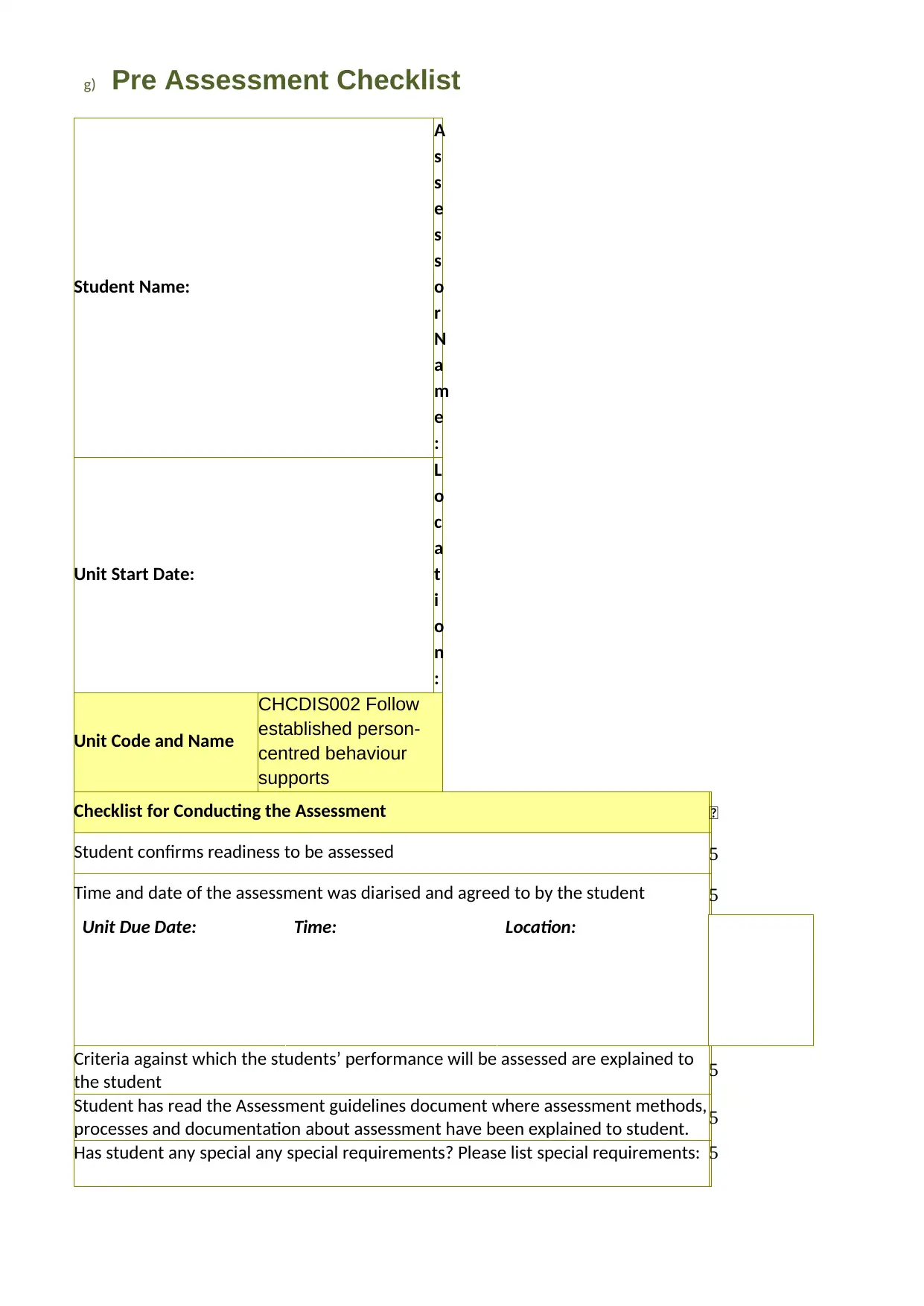
g) Pre Assessment Checklist
Student Name:
A
s
s
e
s
s
o
r
N
a
m
e
:
Unit Start Date:
L
o
c
a
t
i
o
n
:
Unit Code and Name
CHCDIS002 Follow
established person-
centred behaviour
supports
Checklist for Conducting the Assessment
Student confirms readiness to be assessed
Time and date of the assessment was diarised and agreed to by the student
Unit Due Date: Time: Location:
Criteria against which the students’ performance will be assessed are explained to
the student
Student has read the Assessment guidelines document where assessment methods,
processes and documentation about assessment have been explained to student.
Has student any special any special requirements? Please list special requirements:
Student Name:
A
s
s
e
s
s
o
r
N
a
m
e
:
Unit Start Date:
L
o
c
a
t
i
o
n
:
Unit Code and Name
CHCDIS002 Follow
established person-
centred behaviour
supports
Checklist for Conducting the Assessment
Student confirms readiness to be assessed
Time and date of the assessment was diarised and agreed to by the student
Unit Due Date: Time: Location:
Criteria against which the students’ performance will be assessed are explained to
the student
Student has read the Assessment guidelines document where assessment methods,
processes and documentation about assessment have been explained to student.
Has student any special any special requirements? Please list special requirements:
Paraphrase This Document
Need a fresh take? Get an instant paraphrase of this document with our AI Paraphraser
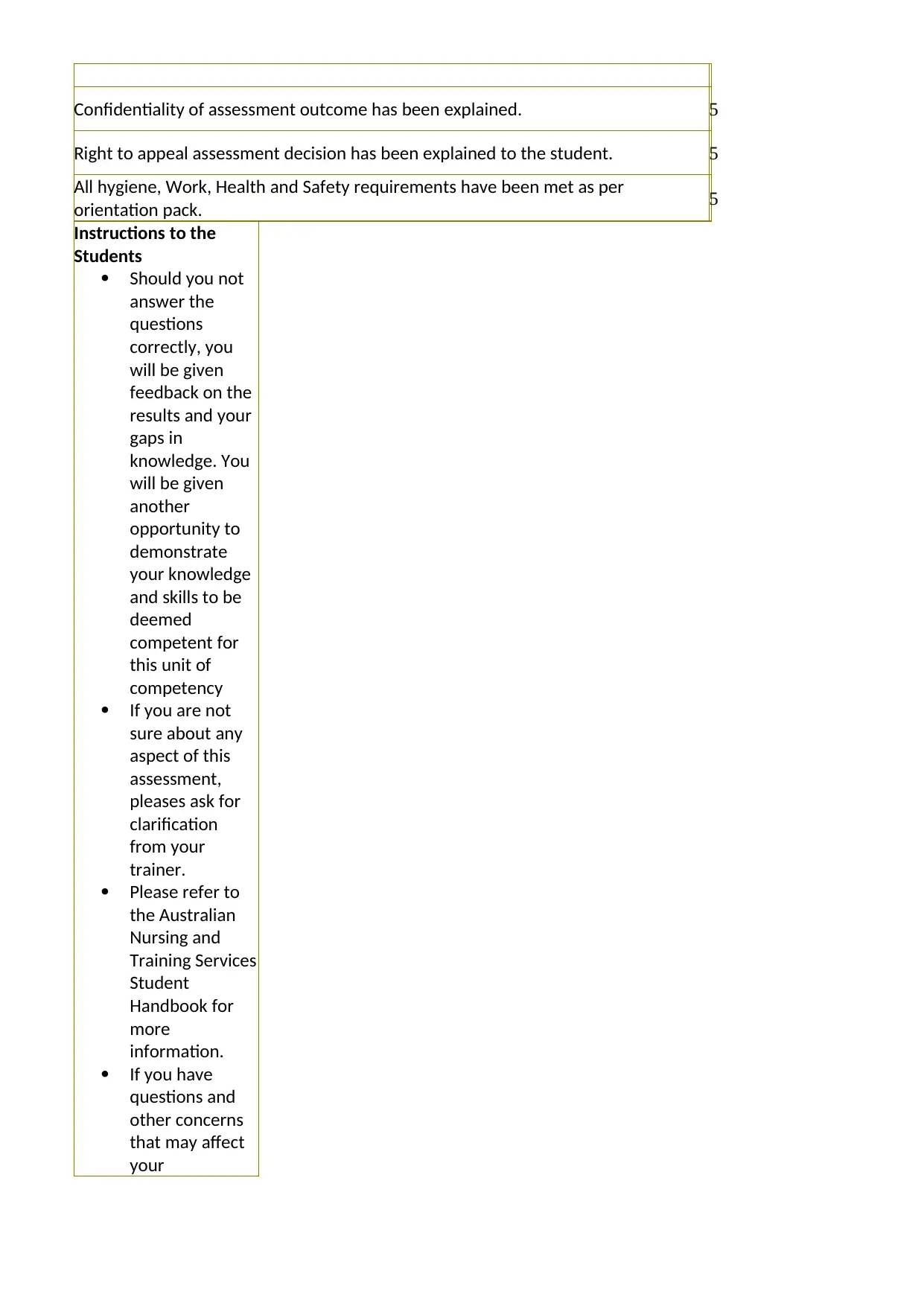
Confidentiality of assessment outcome has been explained.
Right to appeal assessment decision has been explained to the student.
All hygiene, Work, Health and Safety requirements have been met as per
orientation pack.
Instructions to the
Students
Should you not
answer the
questions
correctly, you
will be given
feedback on the
results and your
gaps in
knowledge. You
will be given
another
opportunity to
demonstrate
your knowledge
and skills to be
deemed
competent for
this unit of
competency
If you are not
sure about any
aspect of this
assessment,
pleases ask for
clarification
from your
trainer.
Please refer to
the Australian
Nursing and
Training Services
Student
Handbook for
more
information.
If you have
questions and
other concerns
that may affect
your
Right to appeal assessment decision has been explained to the student.
All hygiene, Work, Health and Safety requirements have been met as per
orientation pack.
Instructions to the
Students
Should you not
answer the
questions
correctly, you
will be given
feedback on the
results and your
gaps in
knowledge. You
will be given
another
opportunity to
demonstrate
your knowledge
and skills to be
deemed
competent for
this unit of
competency
If you are not
sure about any
aspect of this
assessment,
pleases ask for
clarification
from your
trainer.
Please refer to
the Australian
Nursing and
Training Services
Student
Handbook for
more
information.
If you have
questions and
other concerns
that may affect
your
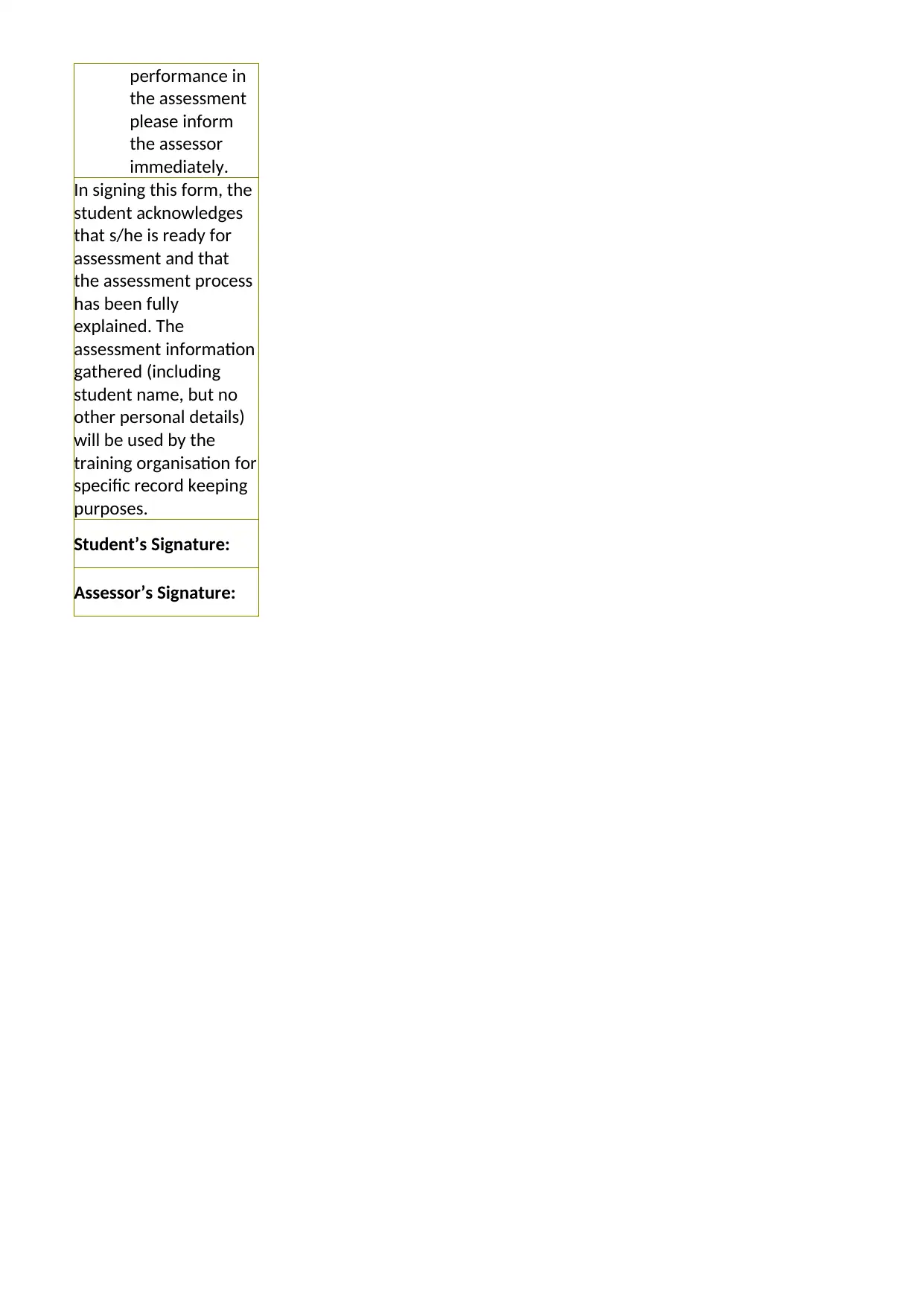
performance in
the assessment
please inform
the assessor
immediately.
In signing this form, the
student acknowledges
that s/he is ready for
assessment and that
the assessment process
has been fully
explained. The
assessment information
gathered (including
student name, but no
other personal details)
will be used by the
training organisation for
specific record keeping
purposes.
Student’s Signature:
Assessor’s Signature:
the assessment
please inform
the assessor
immediately.
In signing this form, the
student acknowledges
that s/he is ready for
assessment and that
the assessment process
has been fully
explained. The
assessment information
gathered (including
student name, but no
other personal details)
will be used by the
training organisation for
specific record keeping
purposes.
Student’s Signature:
Assessor’s Signature:

Secure Best Marks with AI Grader
Need help grading? Try our AI Grader for instant feedback on your assignments.
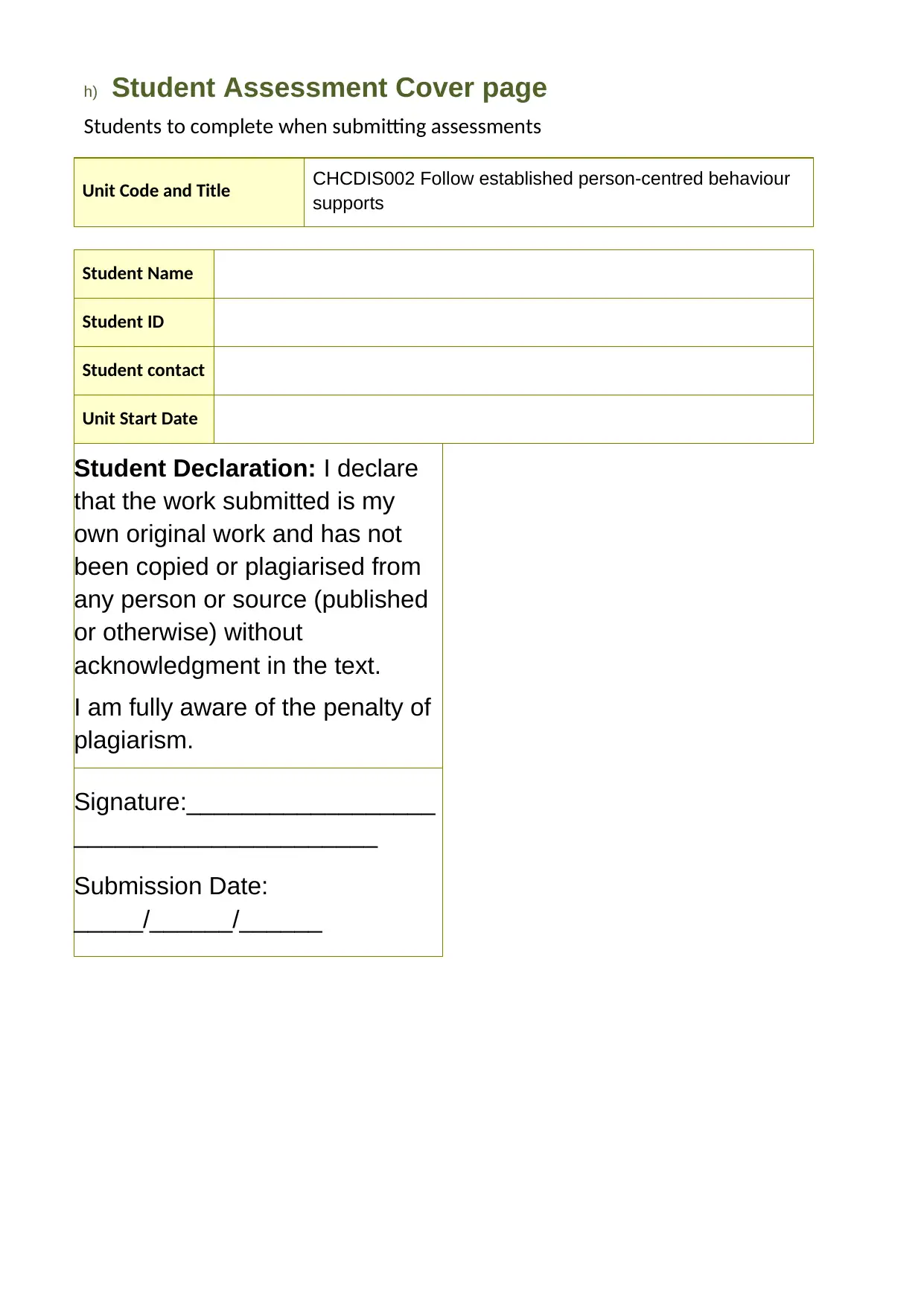
h) Student Assessment Cover page
Students to complete when submitting assessments
Unit Code and Title CHCDIS002 Follow established person-centred behaviour
supports
Student Name
Student ID
Student contact
Unit Start Date
Student Declaration: I declare
that the work submitted is my
own original work and has not
been copied or plagiarised from
any person or source (published
or otherwise) without
acknowledgment in the text.
I am fully aware of the penalty of
plagiarism.
Signature:__________________
______________________
Submission Date:
_____/______/______
Students to complete when submitting assessments
Unit Code and Title CHCDIS002 Follow established person-centred behaviour
supports
Student Name
Student ID
Student contact
Unit Start Date
Student Declaration: I declare
that the work submitted is my
own original work and has not
been copied or plagiarised from
any person or source (published
or otherwise) without
acknowledgment in the text.
I am fully aware of the penalty of
plagiarism.
Signature:__________________
______________________
Submission Date:
_____/______/______

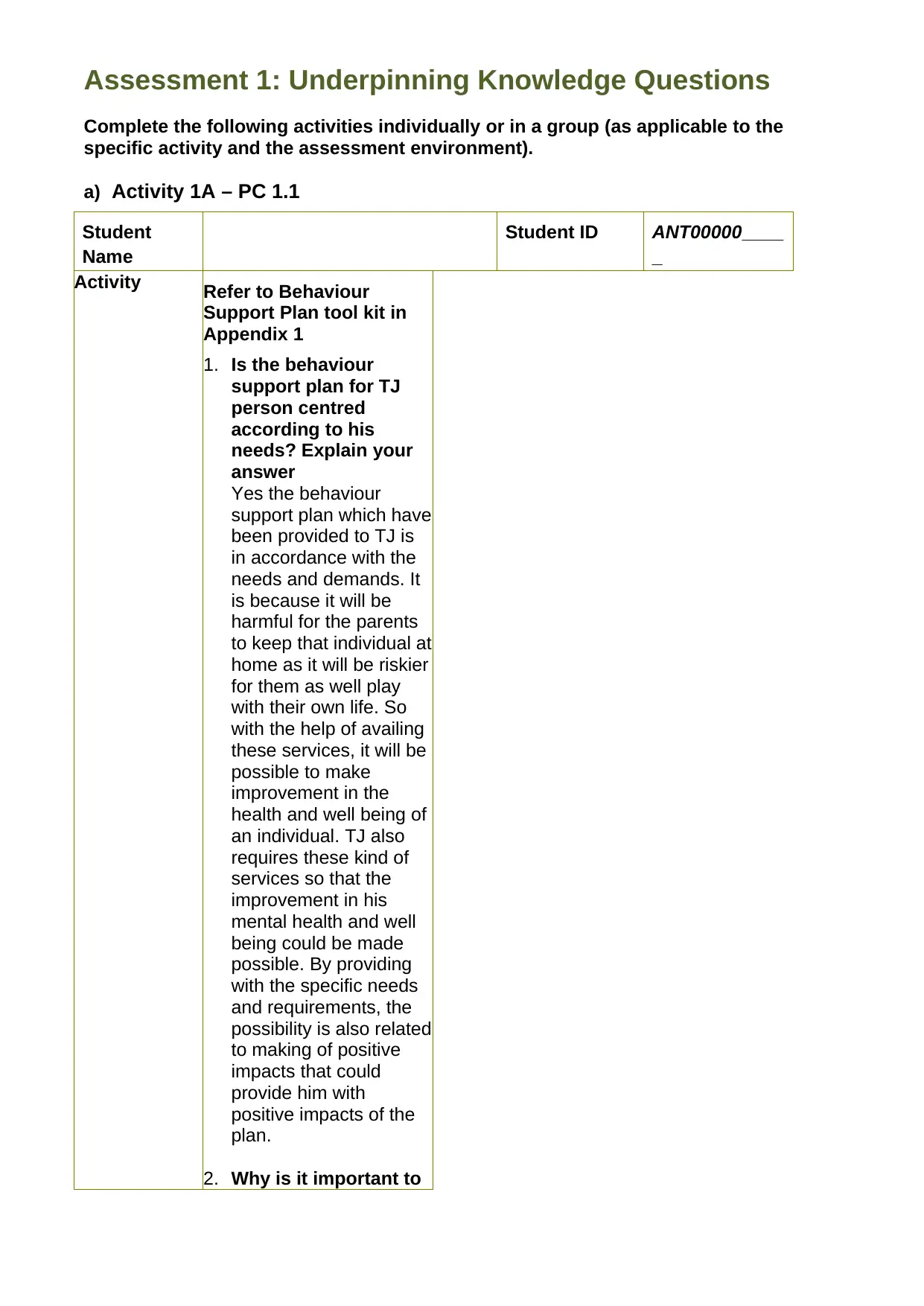
Assessment 1: Underpinning Knowledge Questions
Complete the following activities individually or in a group (as applicable to the
specific activity and the assessment environment).
a) Activity 1A – PC 1.1
Student
Name
Student ID ANT00000____
_
Activity Refer to Behaviour
Support Plan tool kit in
Appendix 1
1. Is the behaviour
support plan for TJ
person centred
according to his
needs? Explain your
answer
Yes the behaviour
support plan which have
been provided to TJ is
in accordance with the
needs and demands. It
is because it will be
harmful for the parents
to keep that individual at
home as it will be riskier
for them as well play
with their own life. So
with the help of availing
these services, it will be
possible to make
improvement in the
health and well being of
an individual. TJ also
requires these kind of
services so that the
improvement in his
mental health and well
being could be made
possible. By providing
with the specific needs
and requirements, the
possibility is also related
to making of positive
impacts that could
provide him with
positive impacts of the
plan.
2. Why is it important to
Complete the following activities individually or in a group (as applicable to the
specific activity and the assessment environment).
a) Activity 1A – PC 1.1
Student
Name
Student ID ANT00000____
_
Activity Refer to Behaviour
Support Plan tool kit in
Appendix 1
1. Is the behaviour
support plan for TJ
person centred
according to his
needs? Explain your
answer
Yes the behaviour
support plan which have
been provided to TJ is
in accordance with the
needs and demands. It
is because it will be
harmful for the parents
to keep that individual at
home as it will be riskier
for them as well play
with their own life. So
with the help of availing
these services, it will be
possible to make
improvement in the
health and well being of
an individual. TJ also
requires these kind of
services so that the
improvement in his
mental health and well
being could be made
possible. By providing
with the specific needs
and requirements, the
possibility is also related
to making of positive
impacts that could
provide him with
positive impacts of the
plan.
2. Why is it important to
Paraphrase This Document
Need a fresh take? Get an instant paraphrase of this document with our AI Paraphraser
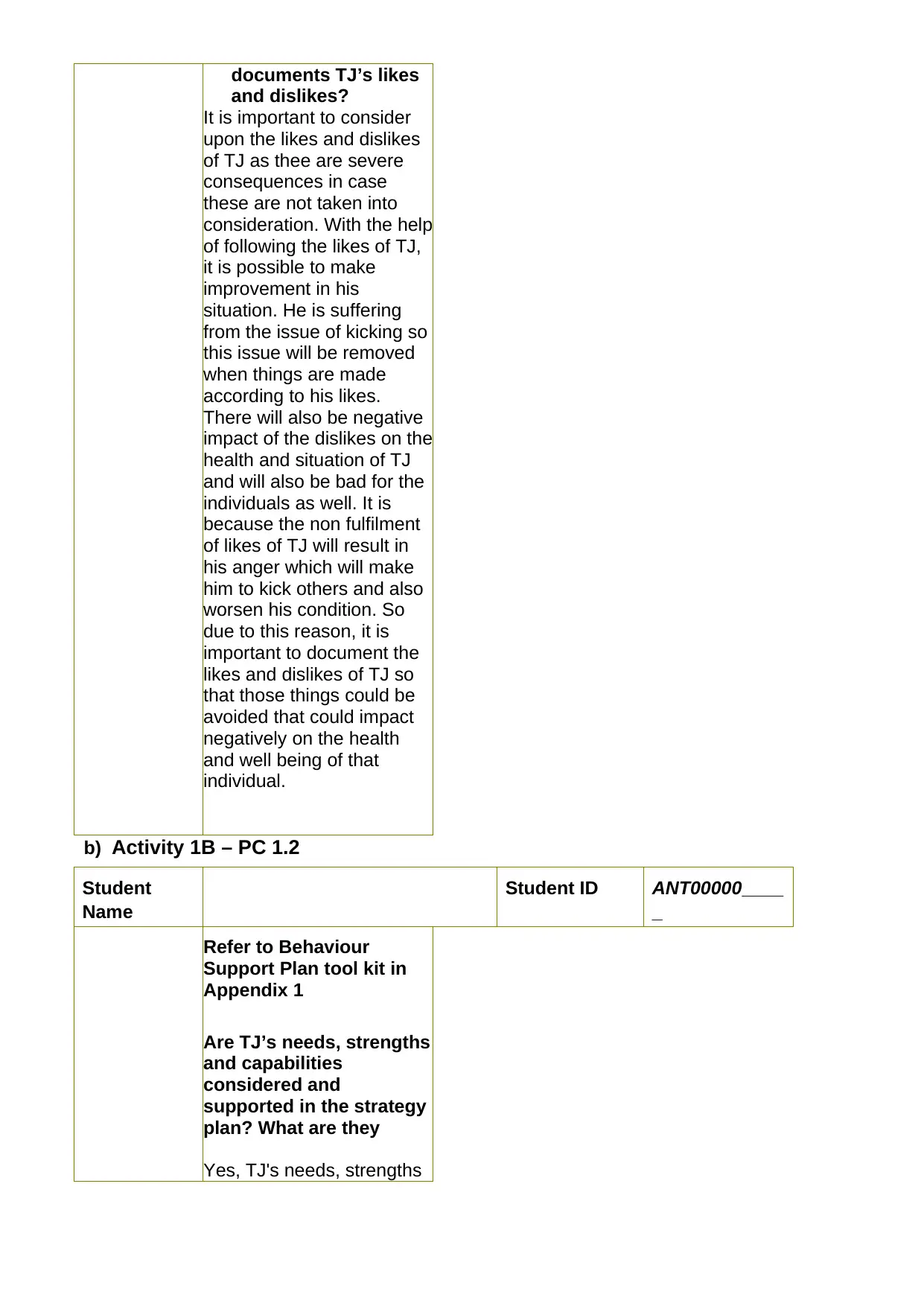
documents TJ’s likes
and dislikes?
It is important to consider
upon the likes and dislikes
of TJ as thee are severe
consequences in case
these are not taken into
consideration. With the help
of following the likes of TJ,
it is possible to make
improvement in his
situation. He is suffering
from the issue of kicking so
this issue will be removed
when things are made
according to his likes.
There will also be negative
impact of the dislikes on the
health and situation of TJ
and will also be bad for the
individuals as well. It is
because the non fulfilment
of likes of TJ will result in
his anger which will make
him to kick others and also
worsen his condition. So
due to this reason, it is
important to document the
likes and dislikes of TJ so
that those things could be
avoided that could impact
negatively on the health
and well being of that
individual.
b) Activity 1B – PC 1.2
Student
Name
Student ID ANT00000____
_
Refer to Behaviour
Support Plan tool kit in
Appendix 1
Are TJ’s needs, strengths
and capabilities
considered and
supported in the strategy
plan? What are they
Yes, TJ's needs, strengths
and dislikes?
It is important to consider
upon the likes and dislikes
of TJ as thee are severe
consequences in case
these are not taken into
consideration. With the help
of following the likes of TJ,
it is possible to make
improvement in his
situation. He is suffering
from the issue of kicking so
this issue will be removed
when things are made
according to his likes.
There will also be negative
impact of the dislikes on the
health and situation of TJ
and will also be bad for the
individuals as well. It is
because the non fulfilment
of likes of TJ will result in
his anger which will make
him to kick others and also
worsen his condition. So
due to this reason, it is
important to document the
likes and dislikes of TJ so
that those things could be
avoided that could impact
negatively on the health
and well being of that
individual.
b) Activity 1B – PC 1.2
Student
Name
Student ID ANT00000____
_
Refer to Behaviour
Support Plan tool kit in
Appendix 1
Are TJ’s needs, strengths
and capabilities
considered and
supported in the strategy
plan? What are they
Yes, TJ's needs, strengths
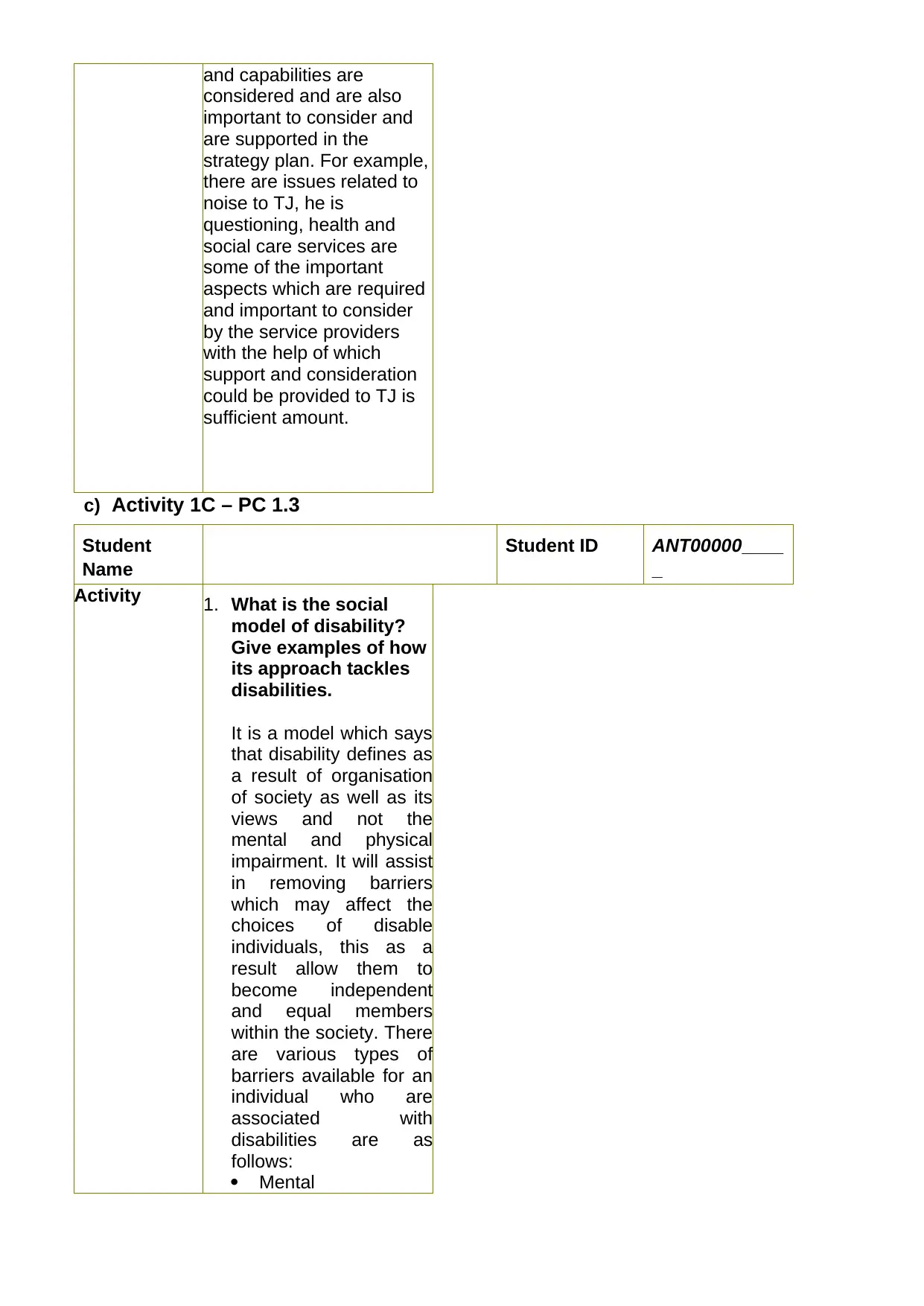
and capabilities are
considered and are also
important to consider and
are supported in the
strategy plan. For example,
there are issues related to
noise to TJ, he is
questioning, health and
social care services are
some of the important
aspects which are required
and important to consider
by the service providers
with the help of which
support and consideration
could be provided to TJ is
sufficient amount.
c) Activity 1C – PC 1.3
Student
Name
Student ID ANT00000____
_
Activity 1. What is the social
model of disability?
Give examples of how
its approach tackles
disabilities.
It is a model which says
that disability defines as
a result of organisation
of society as well as its
views and not the
mental and physical
impairment. It will assist
in removing barriers
which may affect the
choices of disable
individuals, this as a
result allow them to
become independent
and equal members
within the society. There
are various types of
barriers available for an
individual who are
associated with
disabilities are as
follows:
Mental
considered and are also
important to consider and
are supported in the
strategy plan. For example,
there are issues related to
noise to TJ, he is
questioning, health and
social care services are
some of the important
aspects which are required
and important to consider
by the service providers
with the help of which
support and consideration
could be provided to TJ is
sufficient amount.
c) Activity 1C – PC 1.3
Student
Name
Student ID ANT00000____
_
Activity 1. What is the social
model of disability?
Give examples of how
its approach tackles
disabilities.
It is a model which says
that disability defines as
a result of organisation
of society as well as its
views and not the
mental and physical
impairment. It will assist
in removing barriers
which may affect the
choices of disable
individuals, this as a
result allow them to
become independent
and equal members
within the society. There
are various types of
barriers available for an
individual who are
associated with
disabilities are as
follows:
Mental
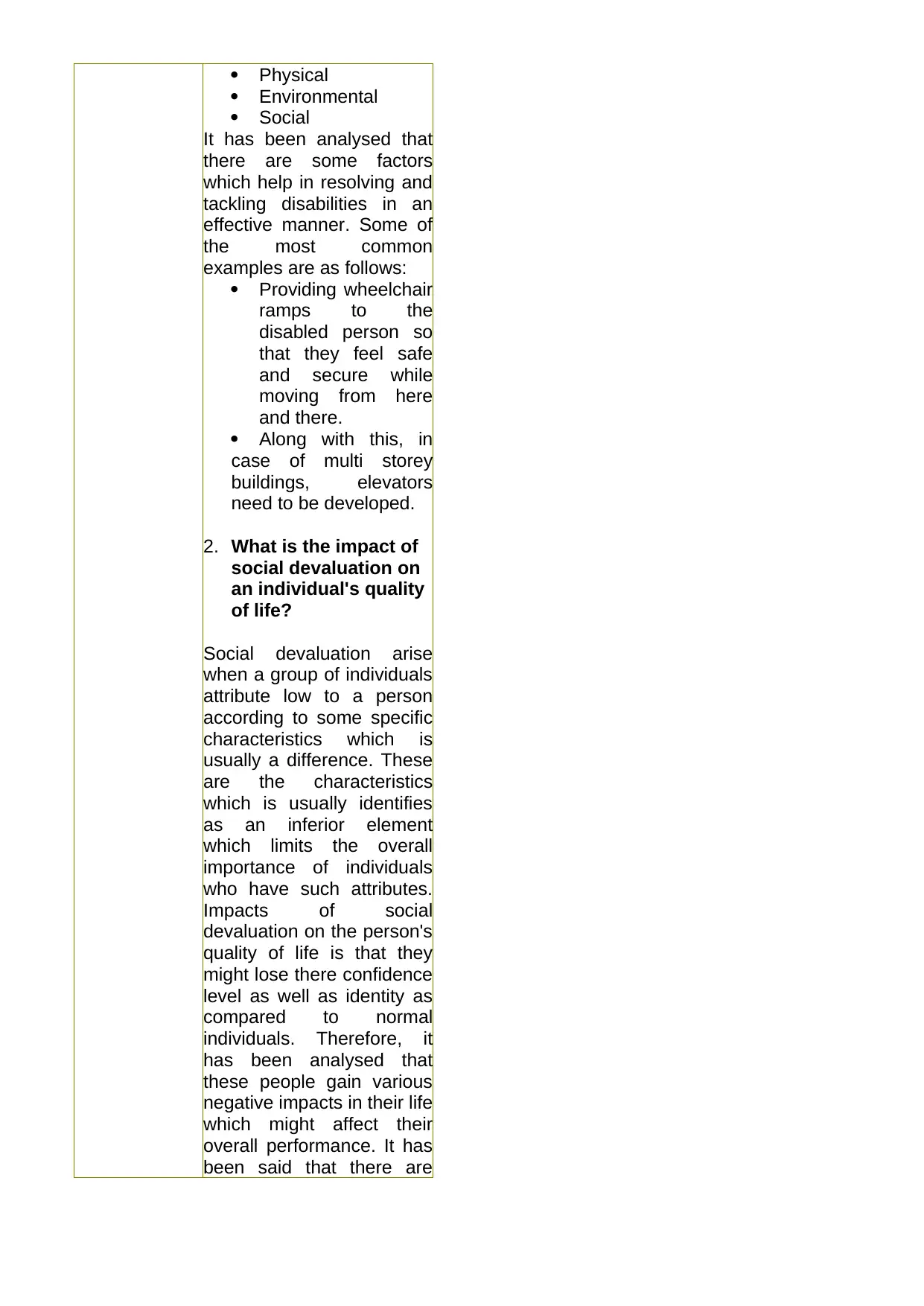
Physical
Environmental
Social
It has been analysed that
there are some factors
which help in resolving and
tackling disabilities in an
effective manner. Some of
the most common
examples are as follows:
Providing wheelchair
ramps to the
disabled person so
that they feel safe
and secure while
moving from here
and there.
Along with this, in
case of multi storey
buildings, elevators
need to be developed.
2. What is the impact of
social devaluation on
an individual's quality
of life?
Social devaluation arise
when a group of individuals
attribute low to a person
according to some specific
characteristics which is
usually a difference. These
are the characteristics
which is usually identifies
as an inferior element
which limits the overall
importance of individuals
who have such attributes.
Impacts of social
devaluation on the person's
quality of life is that they
might lose there confidence
level as well as identity as
compared to normal
individuals. Therefore, it
has been analysed that
these people gain various
negative impacts in their life
which might affect their
overall performance. It has
been said that there are
Environmental
Social
It has been analysed that
there are some factors
which help in resolving and
tackling disabilities in an
effective manner. Some of
the most common
examples are as follows:
Providing wheelchair
ramps to the
disabled person so
that they feel safe
and secure while
moving from here
and there.
Along with this, in
case of multi storey
buildings, elevators
need to be developed.
2. What is the impact of
social devaluation on
an individual's quality
of life?
Social devaluation arise
when a group of individuals
attribute low to a person
according to some specific
characteristics which is
usually a difference. These
are the characteristics
which is usually identifies
as an inferior element
which limits the overall
importance of individuals
who have such attributes.
Impacts of social
devaluation on the person's
quality of life is that they
might lose there confidence
level as well as identity as
compared to normal
individuals. Therefore, it
has been analysed that
these people gain various
negative impacts in their life
which might affect their
overall performance. It has
been said that there are
Secure Best Marks with AI Grader
Need help grading? Try our AI Grader for instant feedback on your assignments.
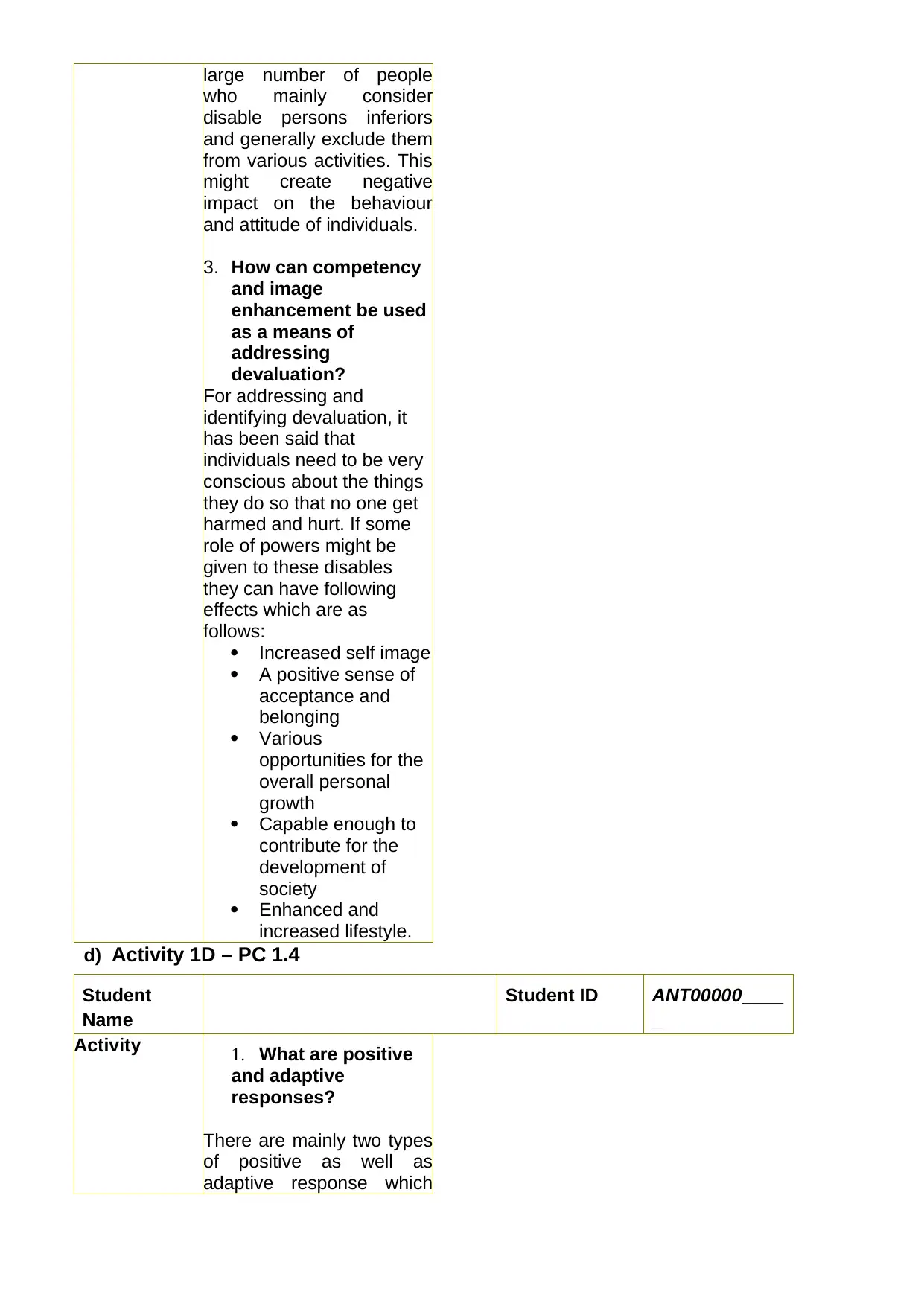
large number of people
who mainly consider
disable persons inferiors
and generally exclude them
from various activities. This
might create negative
impact on the behaviour
and attitude of individuals.
3. How can competency
and image
enhancement be used
as a means of
addressing
devaluation?
For addressing and
identifying devaluation, it
has been said that
individuals need to be very
conscious about the things
they do so that no one get
harmed and hurt. If some
role of powers might be
given to these disables
they can have following
effects which are as
follows:
Increased self image
A positive sense of
acceptance and
belonging
Various
opportunities for the
overall personal
growth
Capable enough to
contribute for the
development of
society
Enhanced and
increased lifestyle.
d) Activity 1D – PC 1.4
Student
Name
Student ID ANT00000____
_
Activity 1. What are positive
and adaptive
responses?
There are mainly two types
of positive as well as
adaptive response which
who mainly consider
disable persons inferiors
and generally exclude them
from various activities. This
might create negative
impact on the behaviour
and attitude of individuals.
3. How can competency
and image
enhancement be used
as a means of
addressing
devaluation?
For addressing and
identifying devaluation, it
has been said that
individuals need to be very
conscious about the things
they do so that no one get
harmed and hurt. If some
role of powers might be
given to these disables
they can have following
effects which are as
follows:
Increased self image
A positive sense of
acceptance and
belonging
Various
opportunities for the
overall personal
growth
Capable enough to
contribute for the
development of
society
Enhanced and
increased lifestyle.
d) Activity 1D – PC 1.4
Student
Name
Student ID ANT00000____
_
Activity 1. What are positive
and adaptive
responses?
There are mainly two types
of positive as well as
adaptive response which
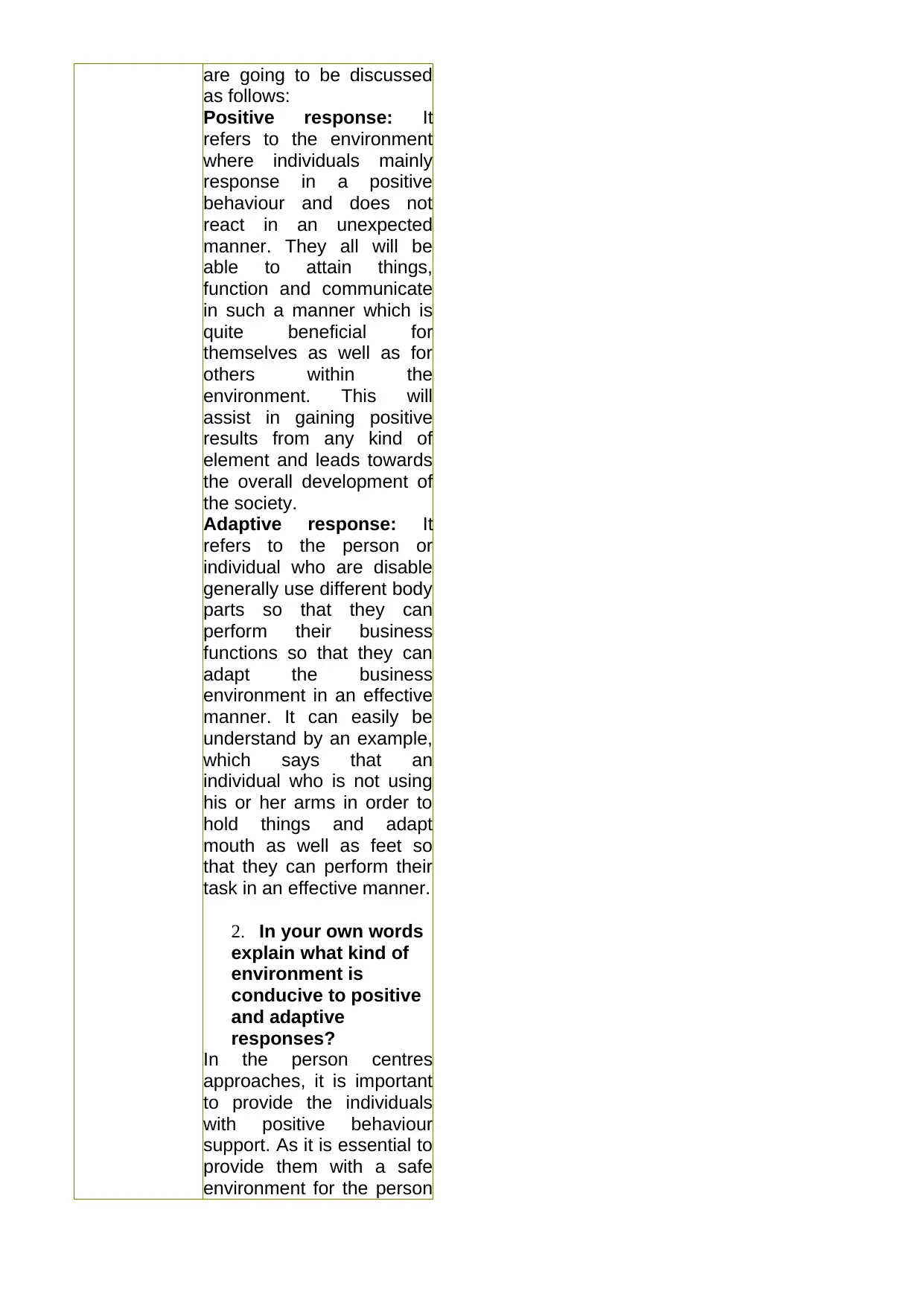
are going to be discussed
as follows:
Positive response: It
refers to the environment
where individuals mainly
response in a positive
behaviour and does not
react in an unexpected
manner. They all will be
able to attain things,
function and communicate
in such a manner which is
quite beneficial for
themselves as well as for
others within the
environment. This will
assist in gaining positive
results from any kind of
element and leads towards
the overall development of
the society.
Adaptive response: It
refers to the person or
individual who are disable
generally use different body
parts so that they can
perform their business
functions so that they can
adapt the business
environment in an effective
manner. It can easily be
understand by an example,
which says that an
individual who is not using
his or her arms in order to
hold things and adapt
mouth as well as feet so
that they can perform their
task in an effective manner.
2. In your own words
explain what kind of
environment is
conducive to positive
and adaptive
responses?
In the person centres
approaches, it is important
to provide the individuals
with positive behaviour
support. As it is essential to
provide them with a safe
environment for the person
as follows:
Positive response: It
refers to the environment
where individuals mainly
response in a positive
behaviour and does not
react in an unexpected
manner. They all will be
able to attain things,
function and communicate
in such a manner which is
quite beneficial for
themselves as well as for
others within the
environment. This will
assist in gaining positive
results from any kind of
element and leads towards
the overall development of
the society.
Adaptive response: It
refers to the person or
individual who are disable
generally use different body
parts so that they can
perform their business
functions so that they can
adapt the business
environment in an effective
manner. It can easily be
understand by an example,
which says that an
individual who is not using
his or her arms in order to
hold things and adapt
mouth as well as feet so
that they can perform their
task in an effective manner.
2. In your own words
explain what kind of
environment is
conducive to positive
and adaptive
responses?
In the person centres
approaches, it is important
to provide the individuals
with positive behaviour
support. As it is essential to
provide them with a safe
environment for the person
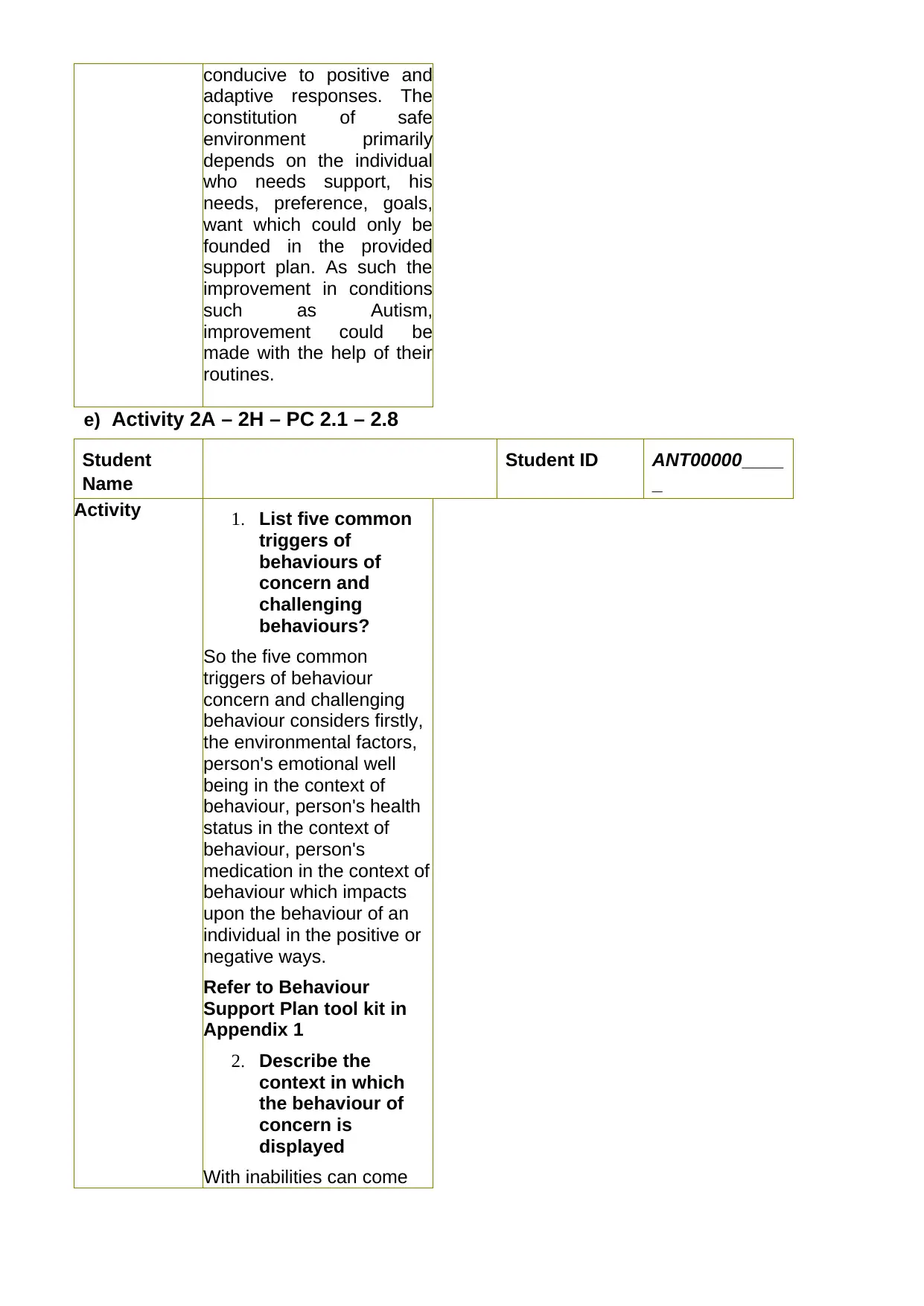
conducive to positive and
adaptive responses. The
constitution of safe
environment primarily
depends on the individual
who needs support, his
needs, preference, goals,
want which could only be
founded in the provided
support plan. As such the
improvement in conditions
such as Autism,
improvement could be
made with the help of their
routines.
e) Activity 2A – 2H – PC 2.1 – 2.8
Student
Name
Student ID ANT00000____
_
Activity 1. List five common
triggers of
behaviours of
concern and
challenging
behaviours?
So the five common
triggers of behaviour
concern and challenging
behaviour considers firstly,
the environmental factors,
person's emotional well
being in the context of
behaviour, person's health
status in the context of
behaviour, person's
medication in the context of
behaviour which impacts
upon the behaviour of an
individual in the positive or
negative ways.
Refer to Behaviour
Support Plan tool kit in
Appendix 1
2. Describe the
context in which
the behaviour of
concern is
displayed
With inabilities can come
adaptive responses. The
constitution of safe
environment primarily
depends on the individual
who needs support, his
needs, preference, goals,
want which could only be
founded in the provided
support plan. As such the
improvement in conditions
such as Autism,
improvement could be
made with the help of their
routines.
e) Activity 2A – 2H – PC 2.1 – 2.8
Student
Name
Student ID ANT00000____
_
Activity 1. List five common
triggers of
behaviours of
concern and
challenging
behaviours?
So the five common
triggers of behaviour
concern and challenging
behaviour considers firstly,
the environmental factors,
person's emotional well
being in the context of
behaviour, person's health
status in the context of
behaviour, person's
medication in the context of
behaviour which impacts
upon the behaviour of an
individual in the positive or
negative ways.
Refer to Behaviour
Support Plan tool kit in
Appendix 1
2. Describe the
context in which
the behaviour of
concern is
displayed
With inabilities can come
Paraphrase This Document
Need a fresh take? Get an instant paraphrase of this document with our AI Paraphraser
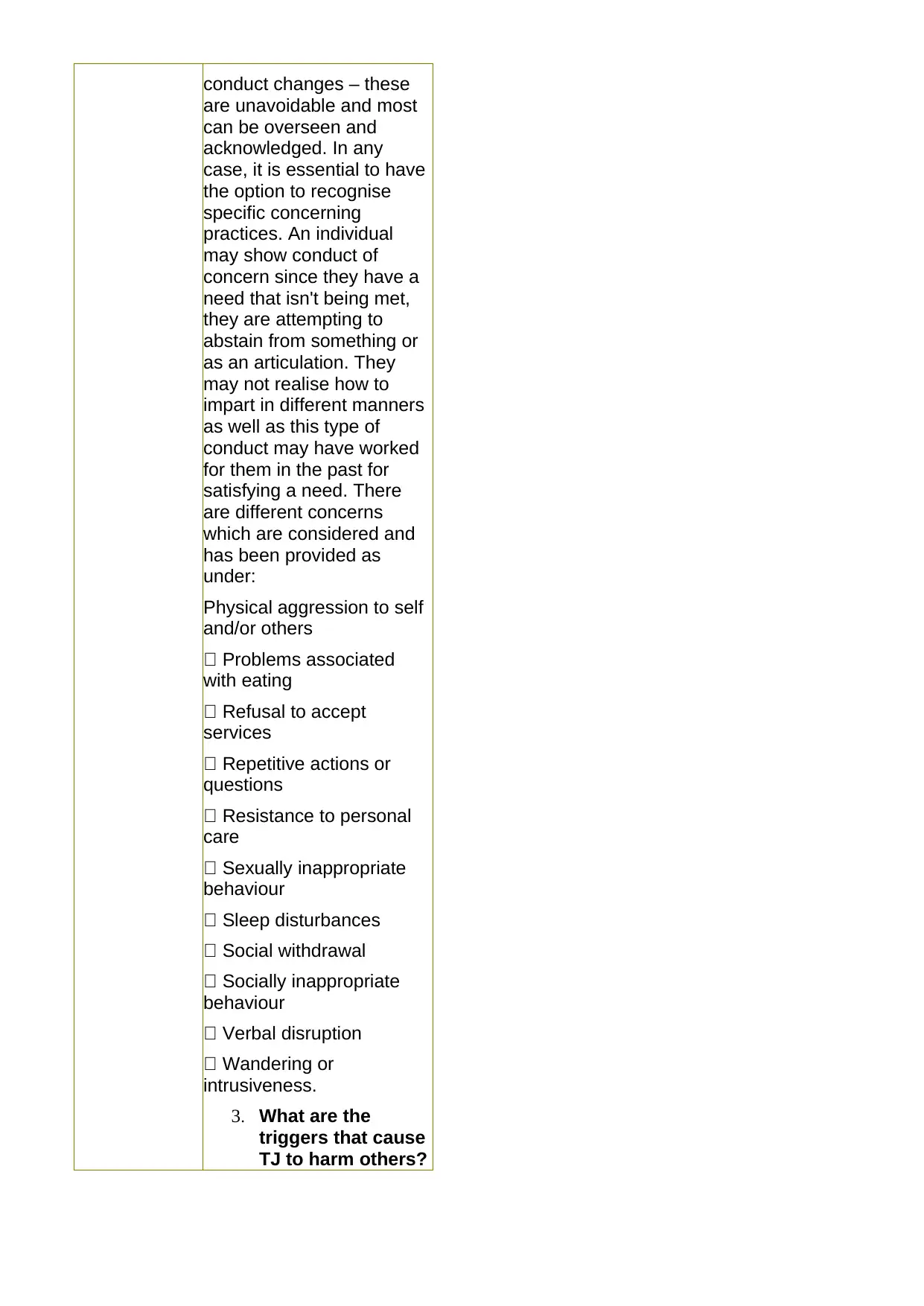
conduct changes – these
are unavoidable and most
can be overseen and
acknowledged. In any
case, it is essential to have
the option to recognise
specific concerning
practices. An individual
may show conduct of
concern since they have a
need that isn't being met,
they are attempting to
abstain from something or
as an articulation. They
may not realise how to
impart in different manners
as well as this type of
conduct may have worked
for them in the past for
satisfying a need. There
are different concerns
which are considered and
has been provided as
under:
Physical aggression to self
and/or others
Problems associated
with eating
Refusal to accept
services
Repetitive actions or
questions
Resistance to personal
care
Sexually inappropriate
behaviour
Sleep disturbances
Social withdrawal
Socially inappropriate
behaviour
Verbal disruption
Wandering or
intrusiveness.
3. What are the
triggers that cause
TJ to harm others?
are unavoidable and most
can be overseen and
acknowledged. In any
case, it is essential to have
the option to recognise
specific concerning
practices. An individual
may show conduct of
concern since they have a
need that isn't being met,
they are attempting to
abstain from something or
as an articulation. They
may not realise how to
impart in different manners
as well as this type of
conduct may have worked
for them in the past for
satisfying a need. There
are different concerns
which are considered and
has been provided as
under:
Physical aggression to self
and/or others
Problems associated
with eating
Refusal to accept
services
Repetitive actions or
questions
Resistance to personal
care
Sexually inappropriate
behaviour
Sleep disturbances
Social withdrawal
Socially inappropriate
behaviour
Verbal disruption
Wandering or
intrusiveness.
3. What are the
triggers that cause
TJ to harm others?
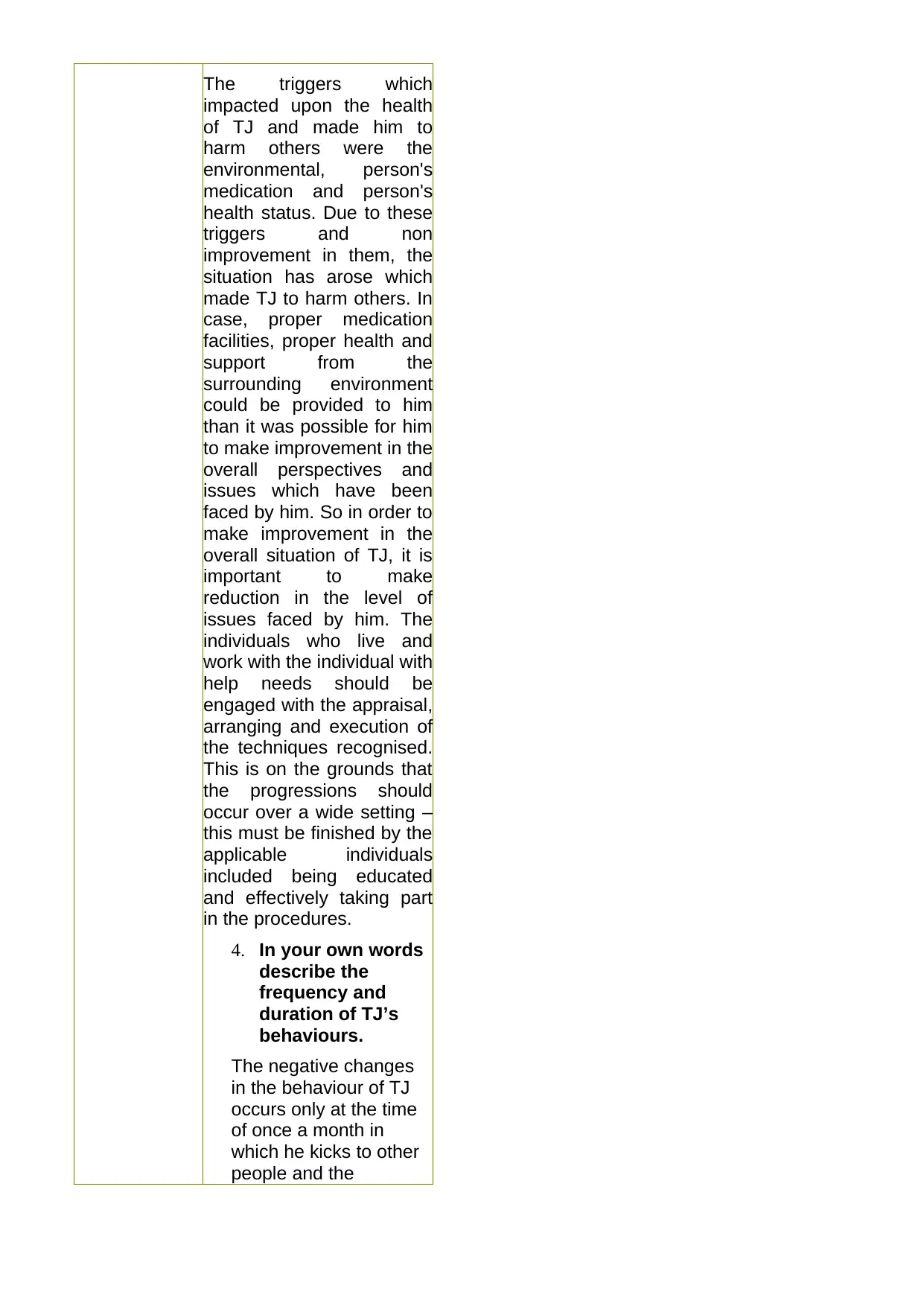
The triggers which
impacted upon the health
of TJ and made him to
harm others were the
environmental, person's
medication and person's
health status. Due to these
triggers and non
improvement in them, the
situation has arose which
made TJ to harm others. In
case, proper medication
facilities, proper health and
support from the
surrounding environment
could be provided to him
than it was possible for him
to make improvement in the
overall perspectives and
issues which have been
faced by him. So in order to
make improvement in the
overall situation of TJ, it is
important to make
reduction in the level of
issues faced by him. The
individuals who live and
work with the individual with
help needs should be
engaged with the appraisal,
arranging and execution of
the techniques recognised.
This is on the grounds that
the progressions should
occur over a wide setting –
this must be finished by the
applicable individuals
included being educated
and effectively taking part
in the procedures.
4. In your own words
describe the
frequency and
duration of TJ’s
behaviours.
The negative changes
in the behaviour of TJ
occurs only at the time
of once a month in
which he kicks to other
people and the
impacted upon the health
of TJ and made him to
harm others were the
environmental, person's
medication and person's
health status. Due to these
triggers and non
improvement in them, the
situation has arose which
made TJ to harm others. In
case, proper medication
facilities, proper health and
support from the
surrounding environment
could be provided to him
than it was possible for him
to make improvement in the
overall perspectives and
issues which have been
faced by him. So in order to
make improvement in the
overall situation of TJ, it is
important to make
reduction in the level of
issues faced by him. The
individuals who live and
work with the individual with
help needs should be
engaged with the appraisal,
arranging and execution of
the techniques recognised.
This is on the grounds that
the progressions should
occur over a wide setting –
this must be finished by the
applicable individuals
included being educated
and effectively taking part
in the procedures.
4. In your own words
describe the
frequency and
duration of TJ’s
behaviours.
The negative changes
in the behaviour of TJ
occurs only at the time
of once a month in
which he kicks to other
people and the
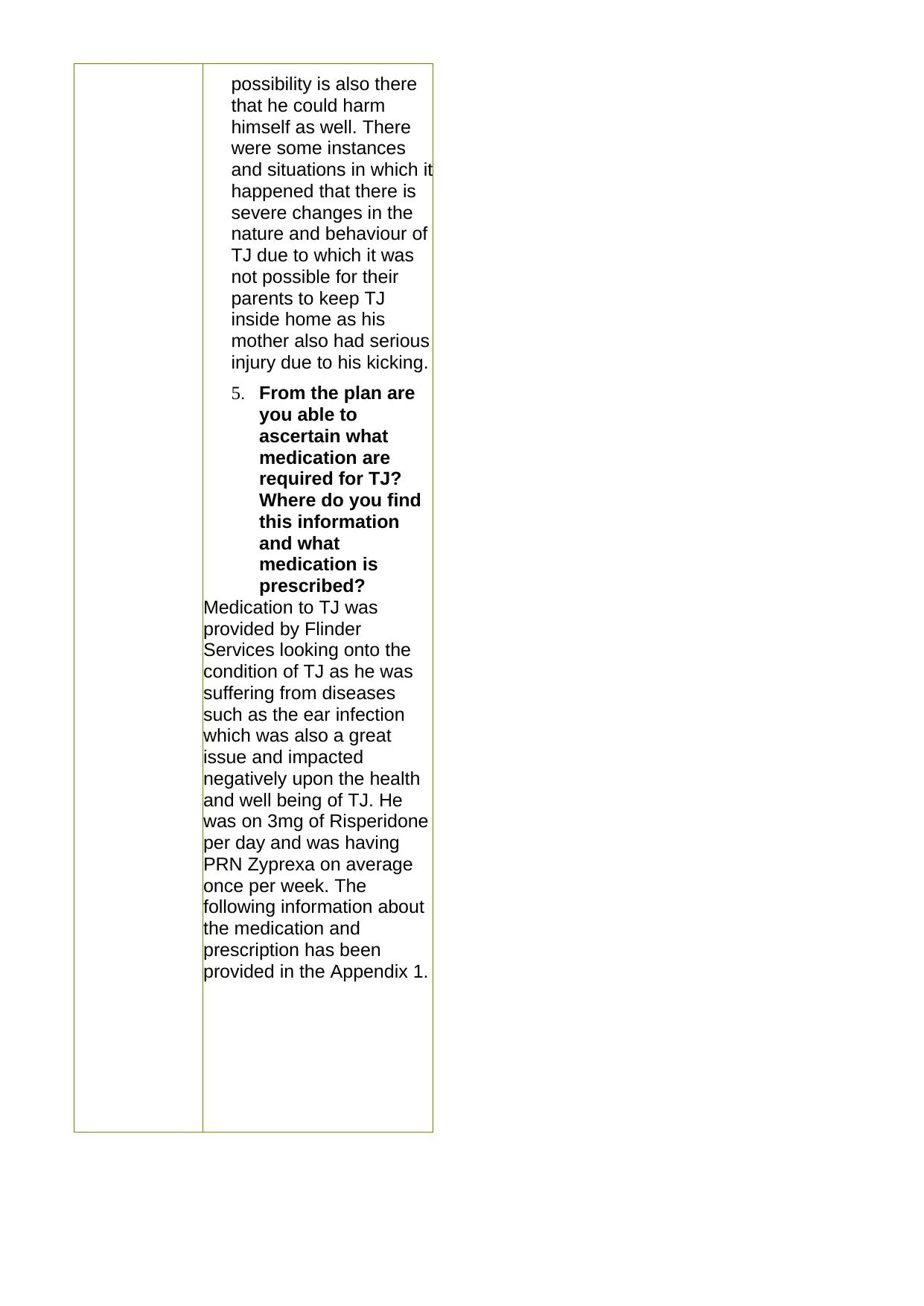
possibility is also there
that he could harm
himself as well. There
were some instances
and situations in which it
happened that there is
severe changes in the
nature and behaviour of
TJ due to which it was
not possible for their
parents to keep TJ
inside home as his
mother also had serious
injury due to his kicking.
5. From the plan are
you able to
ascertain what
medication are
required for TJ?
Where do you find
this information
and what
medication is
prescribed?
Medication to TJ was
provided by Flinder
Services looking onto the
condition of TJ as he was
suffering from diseases
such as the ear infection
which was also a great
issue and impacted
negatively upon the health
and well being of TJ. He
was on 3mg of Risperidone
per day and was having
PRN Zyprexa on average
once per week. The
following information about
the medication and
prescription has been
provided in the Appendix 1.
that he could harm
himself as well. There
were some instances
and situations in which it
happened that there is
severe changes in the
nature and behaviour of
TJ due to which it was
not possible for their
parents to keep TJ
inside home as his
mother also had serious
injury due to his kicking.
5. From the plan are
you able to
ascertain what
medication are
required for TJ?
Where do you find
this information
and what
medication is
prescribed?
Medication to TJ was
provided by Flinder
Services looking onto the
condition of TJ as he was
suffering from diseases
such as the ear infection
which was also a great
issue and impacted
negatively upon the health
and well being of TJ. He
was on 3mg of Risperidone
per day and was having
PRN Zyprexa on average
once per week. The
following information about
the medication and
prescription has been
provided in the Appendix 1.
Secure Best Marks with AI Grader
Need help grading? Try our AI Grader for instant feedback on your assignments.
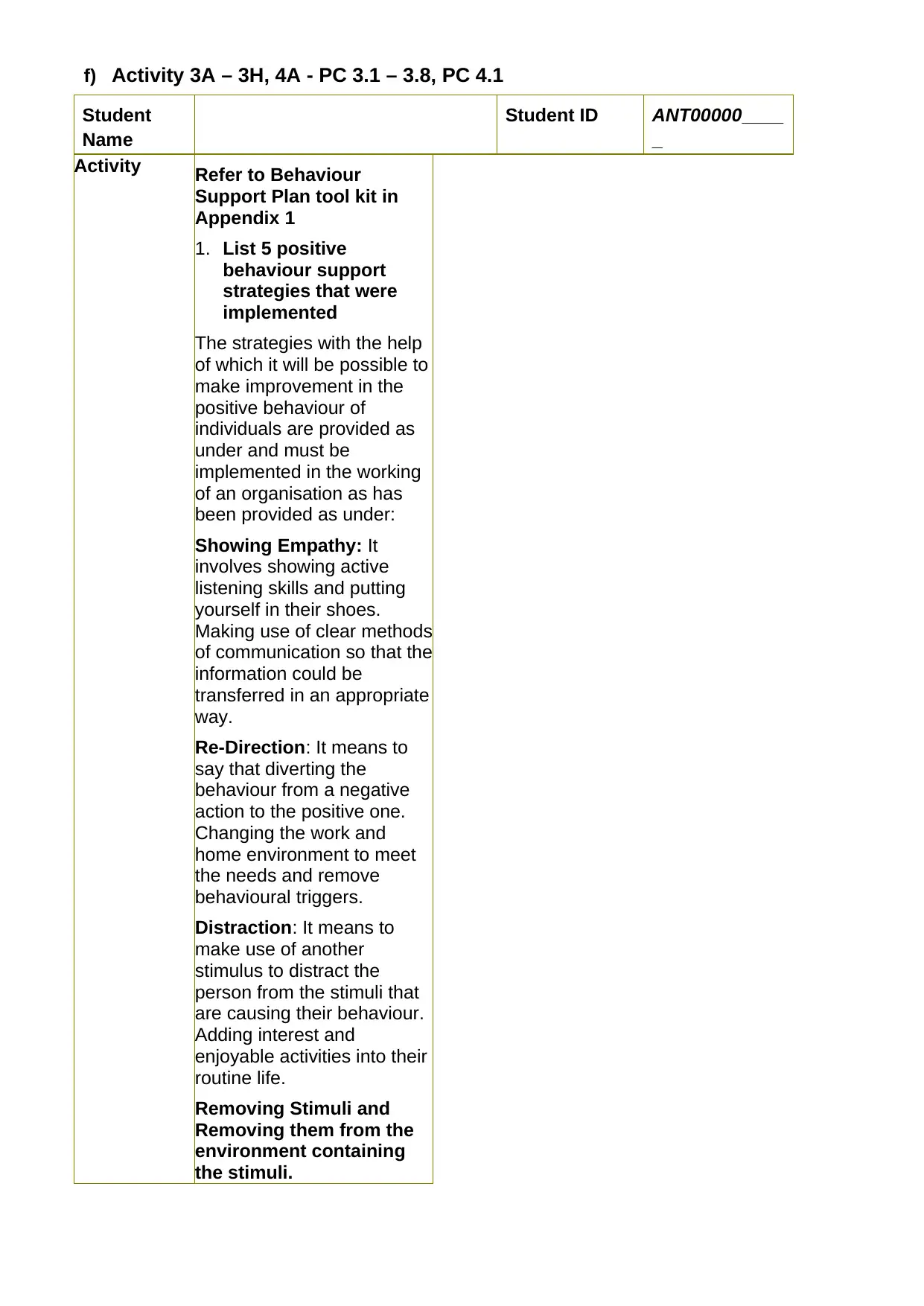
f) Activity 3A – 3H, 4A - PC 3.1 – 3.8, PC 4.1
Student
Name
Student ID ANT00000____
_
Activity Refer to Behaviour
Support Plan tool kit in
Appendix 1
1. List 5 positive
behaviour support
strategies that were
implemented
The strategies with the help
of which it will be possible to
make improvement in the
positive behaviour of
individuals are provided as
under and must be
implemented in the working
of an organisation as has
been provided as under:
Showing Empathy: It
involves showing active
listening skills and putting
yourself in their shoes.
Making use of clear methods
of communication so that the
information could be
transferred in an appropriate
way.
Re-Direction: It means to
say that diverting the
behaviour from a negative
action to the positive one.
Changing the work and
home environment to meet
the needs and remove
behavioural triggers.
Distraction: It means to
make use of another
stimulus to distract the
person from the stimuli that
are causing their behaviour.
Adding interest and
enjoyable activities into their
routine life.
Removing Stimuli and
Removing them from the
environment containing
the stimuli.
Student
Name
Student ID ANT00000____
_
Activity Refer to Behaviour
Support Plan tool kit in
Appendix 1
1. List 5 positive
behaviour support
strategies that were
implemented
The strategies with the help
of which it will be possible to
make improvement in the
positive behaviour of
individuals are provided as
under and must be
implemented in the working
of an organisation as has
been provided as under:
Showing Empathy: It
involves showing active
listening skills and putting
yourself in their shoes.
Making use of clear methods
of communication so that the
information could be
transferred in an appropriate
way.
Re-Direction: It means to
say that diverting the
behaviour from a negative
action to the positive one.
Changing the work and
home environment to meet
the needs and remove
behavioural triggers.
Distraction: It means to
make use of another
stimulus to distract the
person from the stimuli that
are causing their behaviour.
Adding interest and
enjoyable activities into their
routine life.
Removing Stimuli and
Removing them from the
environment containing
the stimuli.
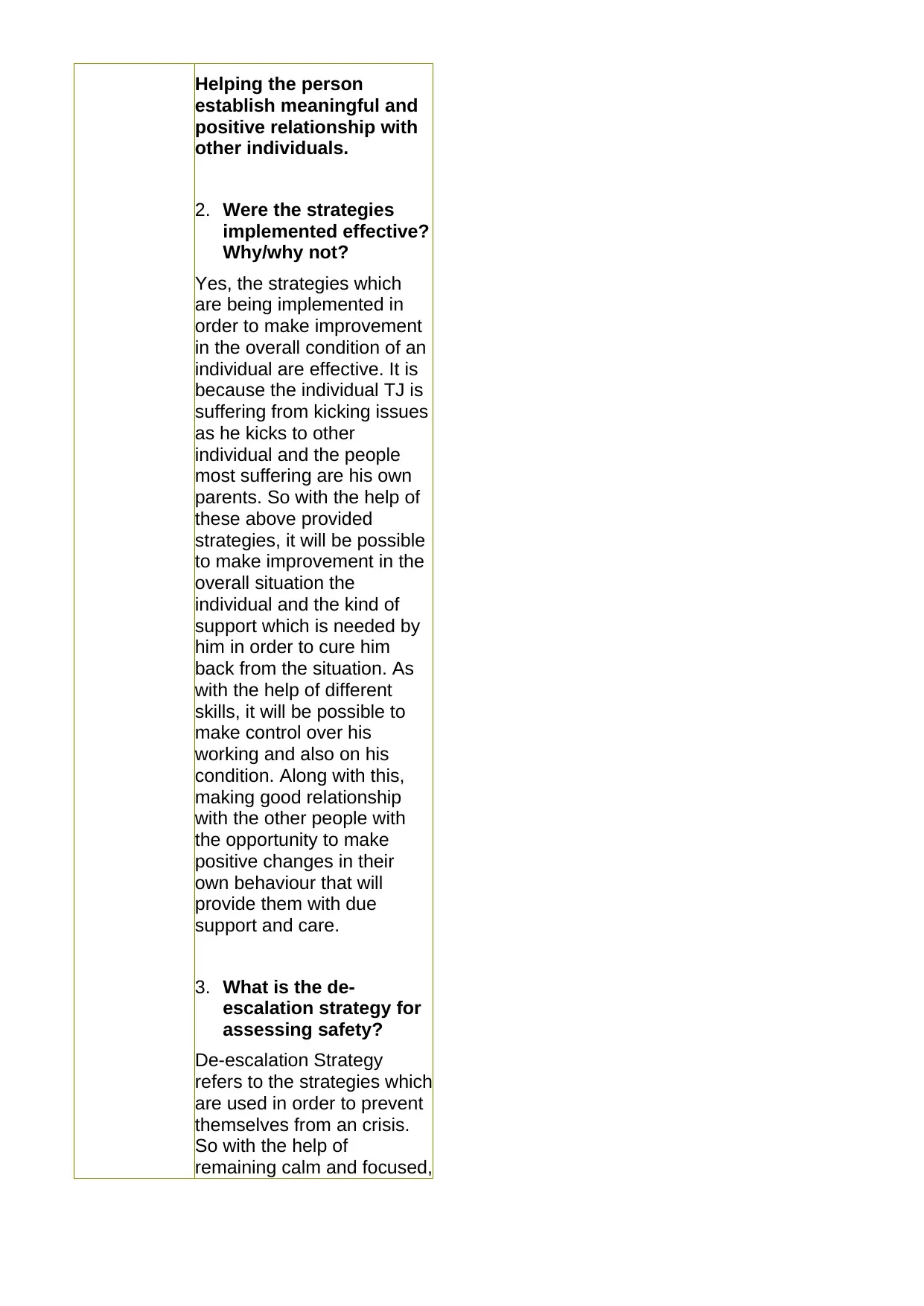
Helping the person
establish meaningful and
positive relationship with
other individuals.
2. Were the strategies
implemented effective?
Why/why not?
Yes, the strategies which
are being implemented in
order to make improvement
in the overall condition of an
individual are effective. It is
because the individual TJ is
suffering from kicking issues
as he kicks to other
individual and the people
most suffering are his own
parents. So with the help of
these above provided
strategies, it will be possible
to make improvement in the
overall situation the
individual and the kind of
support which is needed by
him in order to cure him
back from the situation. As
with the help of different
skills, it will be possible to
make control over his
working and also on his
condition. Along with this,
making good relationship
with the other people with
the opportunity to make
positive changes in their
own behaviour that will
provide them with due
support and care.
3. What is the de-
escalation strategy for
assessing safety?
De-escalation Strategy
refers to the strategies which
are used in order to prevent
themselves from an crisis.
So with the help of
remaining calm and focused,
establish meaningful and
positive relationship with
other individuals.
2. Were the strategies
implemented effective?
Why/why not?
Yes, the strategies which
are being implemented in
order to make improvement
in the overall condition of an
individual are effective. It is
because the individual TJ is
suffering from kicking issues
as he kicks to other
individual and the people
most suffering are his own
parents. So with the help of
these above provided
strategies, it will be possible
to make improvement in the
overall situation the
individual and the kind of
support which is needed by
him in order to cure him
back from the situation. As
with the help of different
skills, it will be possible to
make control over his
working and also on his
condition. Along with this,
making good relationship
with the other people with
the opportunity to make
positive changes in their
own behaviour that will
provide them with due
support and care.
3. What is the de-
escalation strategy for
assessing safety?
De-escalation Strategy
refers to the strategies which
are used in order to prevent
themselves from an crisis.
So with the help of
remaining calm and focused,
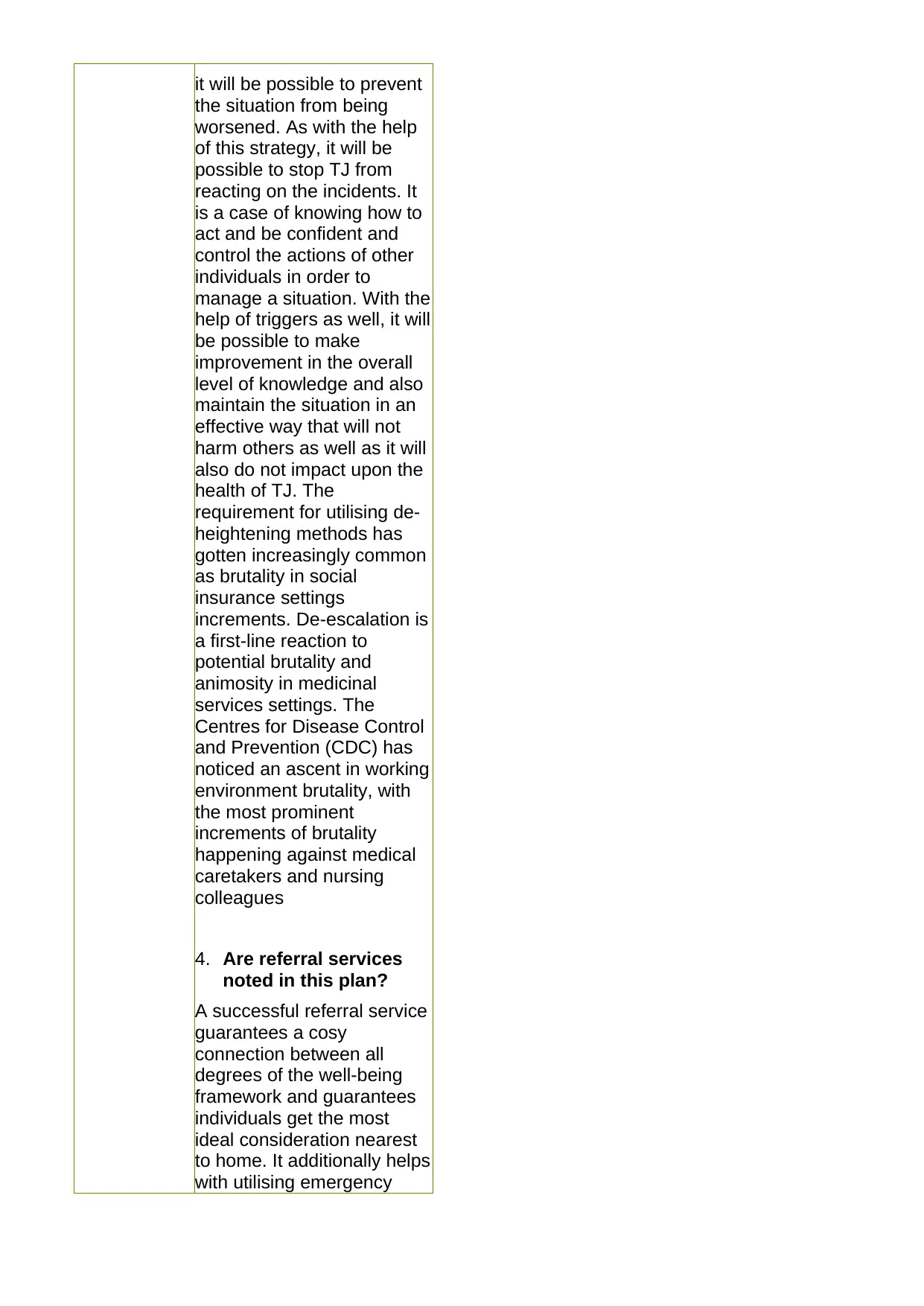
it will be possible to prevent
the situation from being
worsened. As with the help
of this strategy, it will be
possible to stop TJ from
reacting on the incidents. It
is a case of knowing how to
act and be confident and
control the actions of other
individuals in order to
manage a situation. With the
help of triggers as well, it will
be possible to make
improvement in the overall
level of knowledge and also
maintain the situation in an
effective way that will not
harm others as well as it will
also do not impact upon the
health of TJ. The
requirement for utilising de-
heightening methods has
gotten increasingly common
as brutality in social
insurance settings
increments. De-escalation is
a first-line reaction to
potential brutality and
animosity in medicinal
services settings. The
Centres for Disease Control
and Prevention (CDC) has
noticed an ascent in working
environment brutality, with
the most prominent
increments of brutality
happening against medical
caretakers and nursing
colleagues
4. Are referral services
noted in this plan?
A successful referral service
guarantees a cosy
connection between all
degrees of the well-being
framework and guarantees
individuals get the most
ideal consideration nearest
to home. It additionally helps
with utilising emergency
the situation from being
worsened. As with the help
of this strategy, it will be
possible to stop TJ from
reacting on the incidents. It
is a case of knowing how to
act and be confident and
control the actions of other
individuals in order to
manage a situation. With the
help of triggers as well, it will
be possible to make
improvement in the overall
level of knowledge and also
maintain the situation in an
effective way that will not
harm others as well as it will
also do not impact upon the
health of TJ. The
requirement for utilising de-
heightening methods has
gotten increasingly common
as brutality in social
insurance settings
increments. De-escalation is
a first-line reaction to
potential brutality and
animosity in medicinal
services settings. The
Centres for Disease Control
and Prevention (CDC) has
noticed an ascent in working
environment brutality, with
the most prominent
increments of brutality
happening against medical
caretakers and nursing
colleagues
4. Are referral services
noted in this plan?
A successful referral service
guarantees a cosy
connection between all
degrees of the well-being
framework and guarantees
individuals get the most
ideal consideration nearest
to home. It additionally helps
with utilising emergency
Paraphrase This Document
Need a fresh take? Get an instant paraphrase of this document with our AI Paraphraser
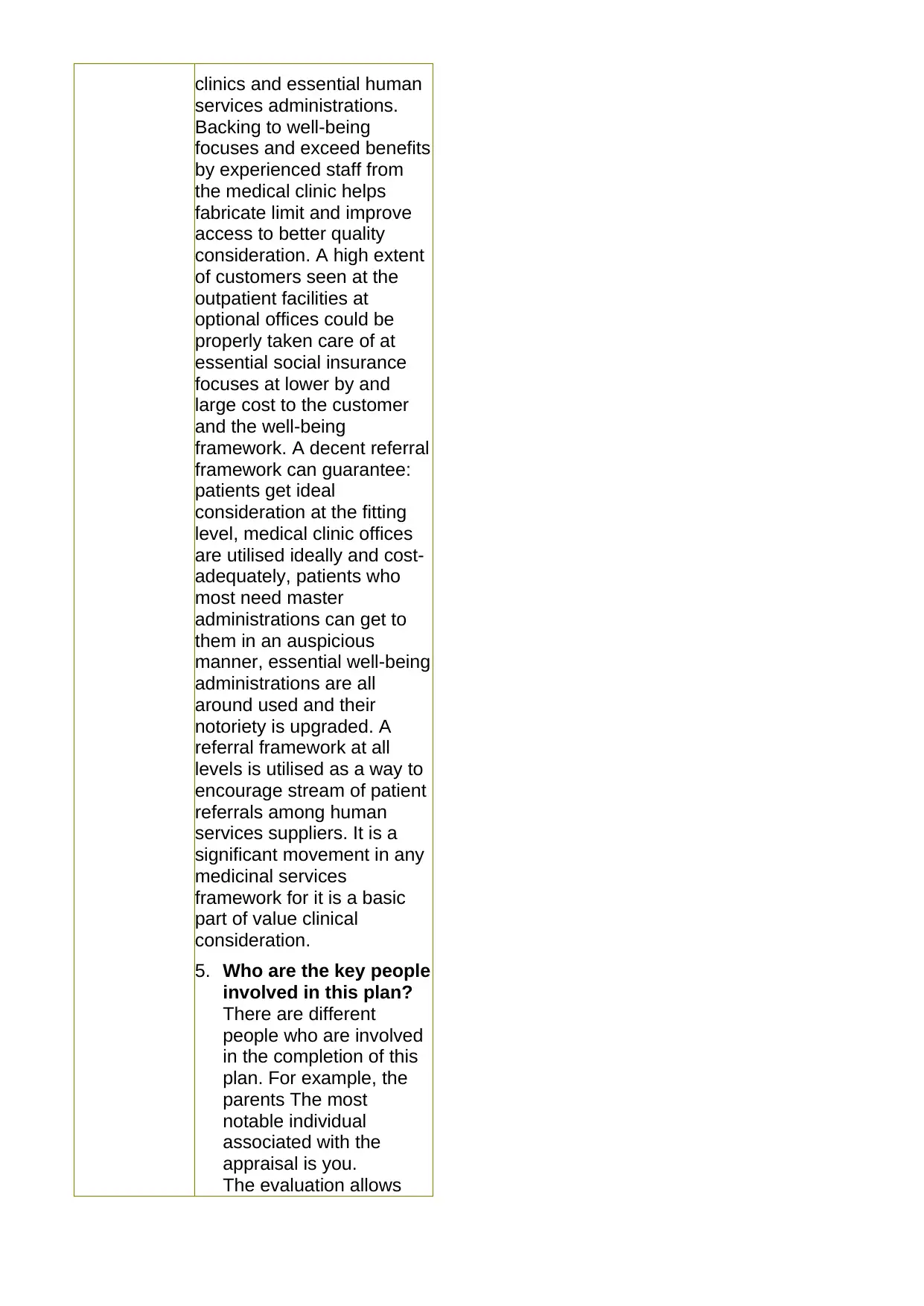
clinics and essential human
services administrations.
Backing to well-being
focuses and exceed benefits
by experienced staff from
the medical clinic helps
fabricate limit and improve
access to better quality
consideration. A high extent
of customers seen at the
outpatient facilities at
optional offices could be
properly taken care of at
essential social insurance
focuses at lower by and
large cost to the customer
and the well-being
framework. A decent referral
framework can guarantee:
patients get ideal
consideration at the fitting
level, medical clinic offices
are utilised ideally and cost-
adequately, patients who
most need master
administrations can get to
them in an auspicious
manner, essential well-being
administrations are all
around used and their
notoriety is upgraded. A
referral framework at all
levels is utilised as a way to
encourage stream of patient
referrals among human
services suppliers. It is a
significant movement in any
medicinal services
framework for it is a basic
part of value clinical
consideration.
5. Who are the key people
involved in this plan?
There are different
people who are involved
in the completion of this
plan. For example, the
parents The most
notable individual
associated with the
appraisal is you.
The evaluation allows
services administrations.
Backing to well-being
focuses and exceed benefits
by experienced staff from
the medical clinic helps
fabricate limit and improve
access to better quality
consideration. A high extent
of customers seen at the
outpatient facilities at
optional offices could be
properly taken care of at
essential social insurance
focuses at lower by and
large cost to the customer
and the well-being
framework. A decent referral
framework can guarantee:
patients get ideal
consideration at the fitting
level, medical clinic offices
are utilised ideally and cost-
adequately, patients who
most need master
administrations can get to
them in an auspicious
manner, essential well-being
administrations are all
around used and their
notoriety is upgraded. A
referral framework at all
levels is utilised as a way to
encourage stream of patient
referrals among human
services suppliers. It is a
significant movement in any
medicinal services
framework for it is a basic
part of value clinical
consideration.
5. Who are the key people
involved in this plan?
There are different
people who are involved
in the completion of this
plan. For example, the
parents The most
notable individual
associated with the
appraisal is you.
The evaluation allows
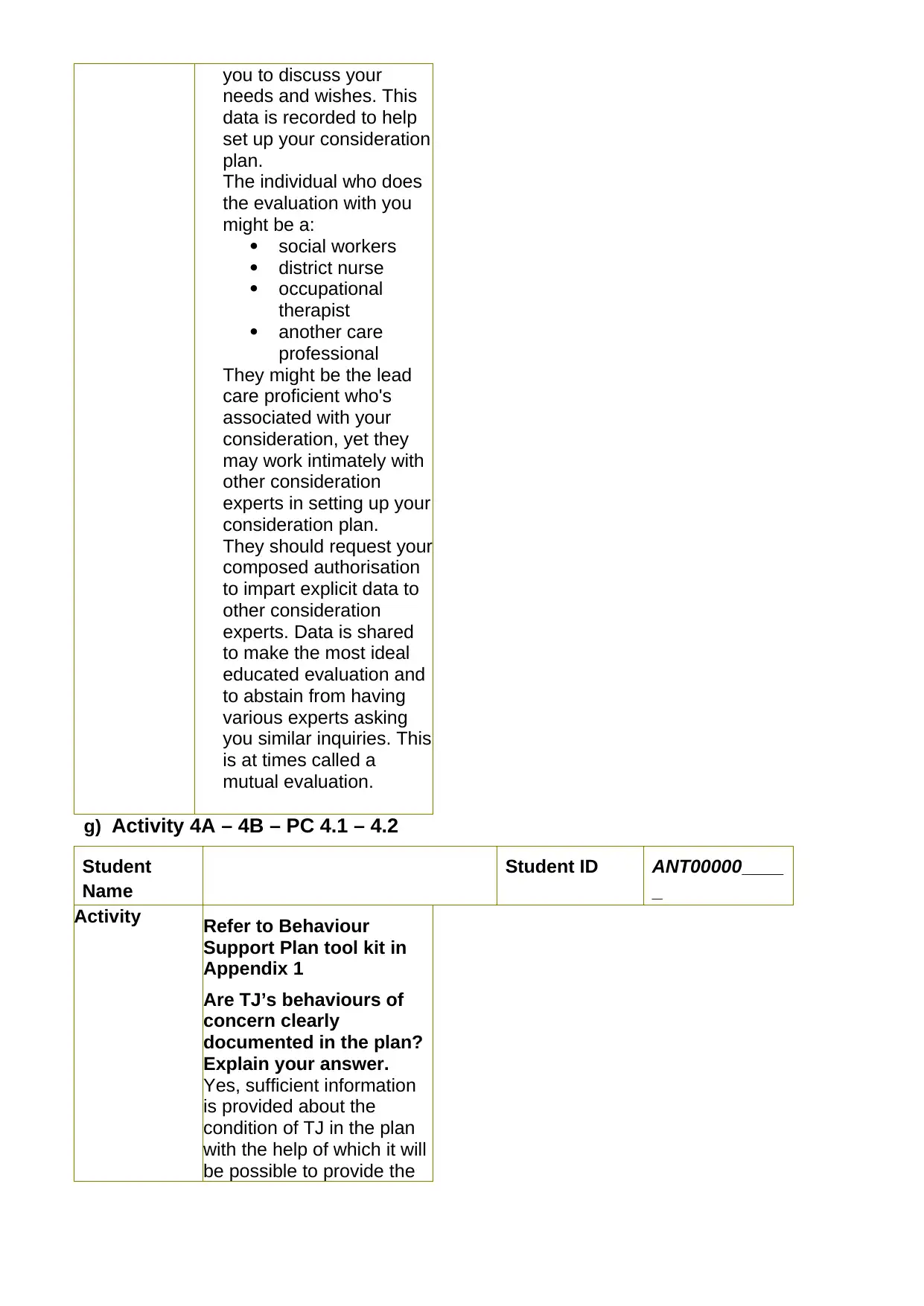
you to discuss your
needs and wishes. This
data is recorded to help
set up your consideration
plan.
The individual who does
the evaluation with you
might be a:
social workers
district nurse
occupational
therapist
another care
professional
They might be the lead
care proficient who's
associated with your
consideration, yet they
may work intimately with
other consideration
experts in setting up your
consideration plan.
They should request your
composed authorisation
to impart explicit data to
other consideration
experts. Data is shared
to make the most ideal
educated evaluation and
to abstain from having
various experts asking
you similar inquiries. This
is at times called a
mutual evaluation.
g) Activity 4A – 4B – PC 4.1 – 4.2
Student
Name
Student ID ANT00000____
_
Activity Refer to Behaviour
Support Plan tool kit in
Appendix 1
Are TJ’s behaviours of
concern clearly
documented in the plan?
Explain your answer.
Yes, sufficient information
is provided about the
condition of TJ in the plan
with the help of which it will
be possible to provide the
needs and wishes. This
data is recorded to help
set up your consideration
plan.
The individual who does
the evaluation with you
might be a:
social workers
district nurse
occupational
therapist
another care
professional
They might be the lead
care proficient who's
associated with your
consideration, yet they
may work intimately with
other consideration
experts in setting up your
consideration plan.
They should request your
composed authorisation
to impart explicit data to
other consideration
experts. Data is shared
to make the most ideal
educated evaluation and
to abstain from having
various experts asking
you similar inquiries. This
is at times called a
mutual evaluation.
g) Activity 4A – 4B – PC 4.1 – 4.2
Student
Name
Student ID ANT00000____
_
Activity Refer to Behaviour
Support Plan tool kit in
Appendix 1
Are TJ’s behaviours of
concern clearly
documented in the plan?
Explain your answer.
Yes, sufficient information
is provided about the
condition of TJ in the plan
with the help of which it will
be possible to provide the
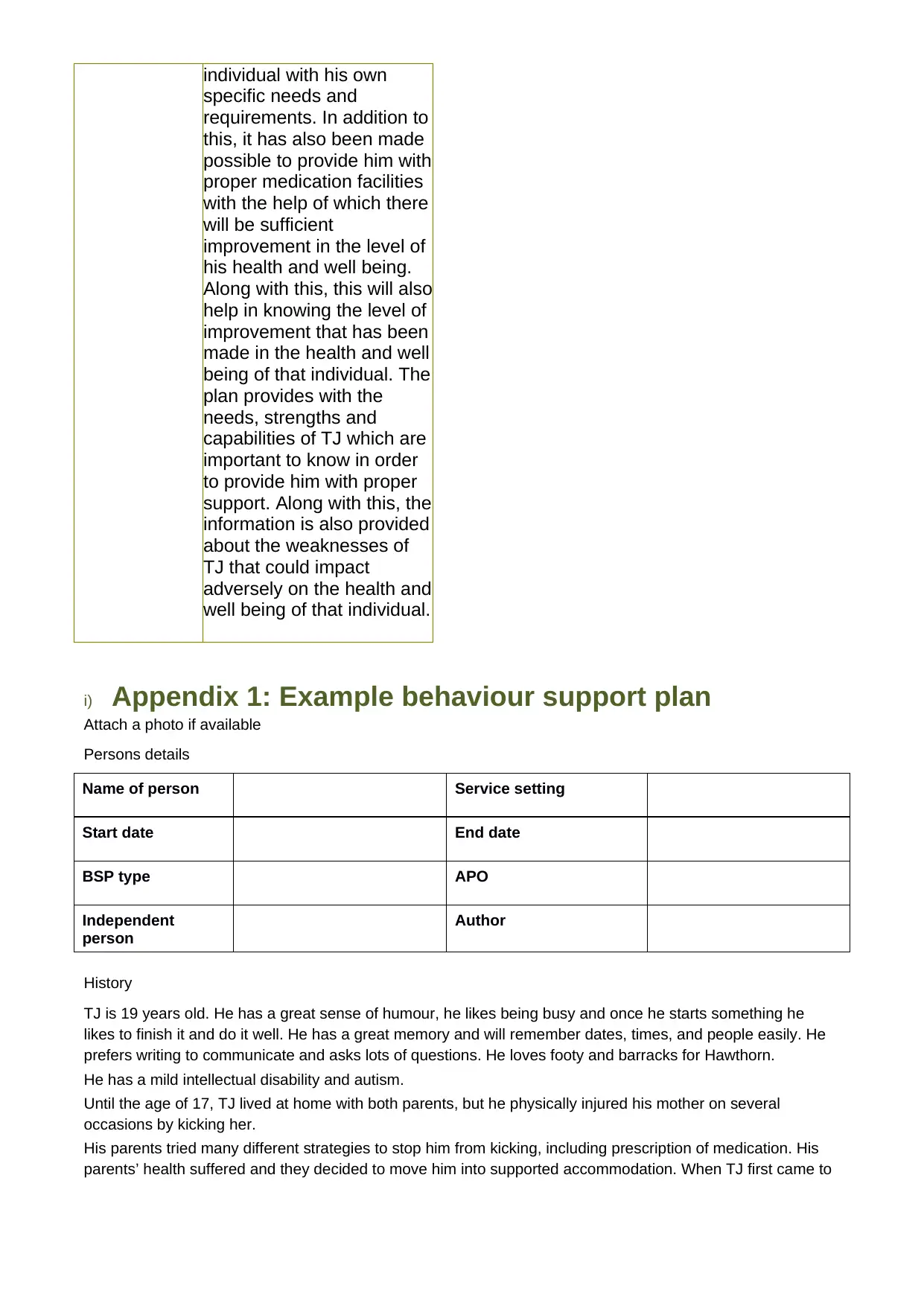
individual with his own
specific needs and
requirements. In addition to
this, it has also been made
possible to provide him with
proper medication facilities
with the help of which there
will be sufficient
improvement in the level of
his health and well being.
Along with this, this will also
help in knowing the level of
improvement that has been
made in the health and well
being of that individual. The
plan provides with the
needs, strengths and
capabilities of TJ which are
important to know in order
to provide him with proper
support. Along with this, the
information is also provided
about the weaknesses of
TJ that could impact
adversely on the health and
well being of that individual.
i) Appendix 1: Example behaviour support plan
Attach a photo if available
Persons details
Name of person Service setting
Start date End date
BSP type APO
Independent
person
Author
History
TJ is 19 years old. He has a great sense of humour, he likes being busy and once he starts something he
likes to finish it and do it well. He has a great memory and will remember dates, times, and people easily. He
prefers writing to communicate and asks lots of questions. He loves footy and barracks for Hawthorn.
He has a mild intellectual disability and autism.
Until the age of 17, TJ lived at home with both parents, but he physically injured his mother on several
occasions by kicking her.
His parents tried many different strategies to stop him from kicking, including prescription of medication. His
parents’ health suffered and they decided to move him into supported accommodation. When TJ first came to
specific needs and
requirements. In addition to
this, it has also been made
possible to provide him with
proper medication facilities
with the help of which there
will be sufficient
improvement in the level of
his health and well being.
Along with this, this will also
help in knowing the level of
improvement that has been
made in the health and well
being of that individual. The
plan provides with the
needs, strengths and
capabilities of TJ which are
important to know in order
to provide him with proper
support. Along with this, the
information is also provided
about the weaknesses of
TJ that could impact
adversely on the health and
well being of that individual.
i) Appendix 1: Example behaviour support plan
Attach a photo if available
Persons details
Name of person Service setting
Start date End date
BSP type APO
Independent
person
Author
History
TJ is 19 years old. He has a great sense of humour, he likes being busy and once he starts something he
likes to finish it and do it well. He has a great memory and will remember dates, times, and people easily. He
prefers writing to communicate and asks lots of questions. He loves footy and barracks for Hawthorn.
He has a mild intellectual disability and autism.
Until the age of 17, TJ lived at home with both parents, but he physically injured his mother on several
occasions by kicking her.
His parents tried many different strategies to stop him from kicking, including prescription of medication. His
parents’ health suffered and they decided to move him into supported accommodation. When TJ first came to
Secure Best Marks with AI Grader
Need help grading? Try our AI Grader for instant feedback on your assignments.
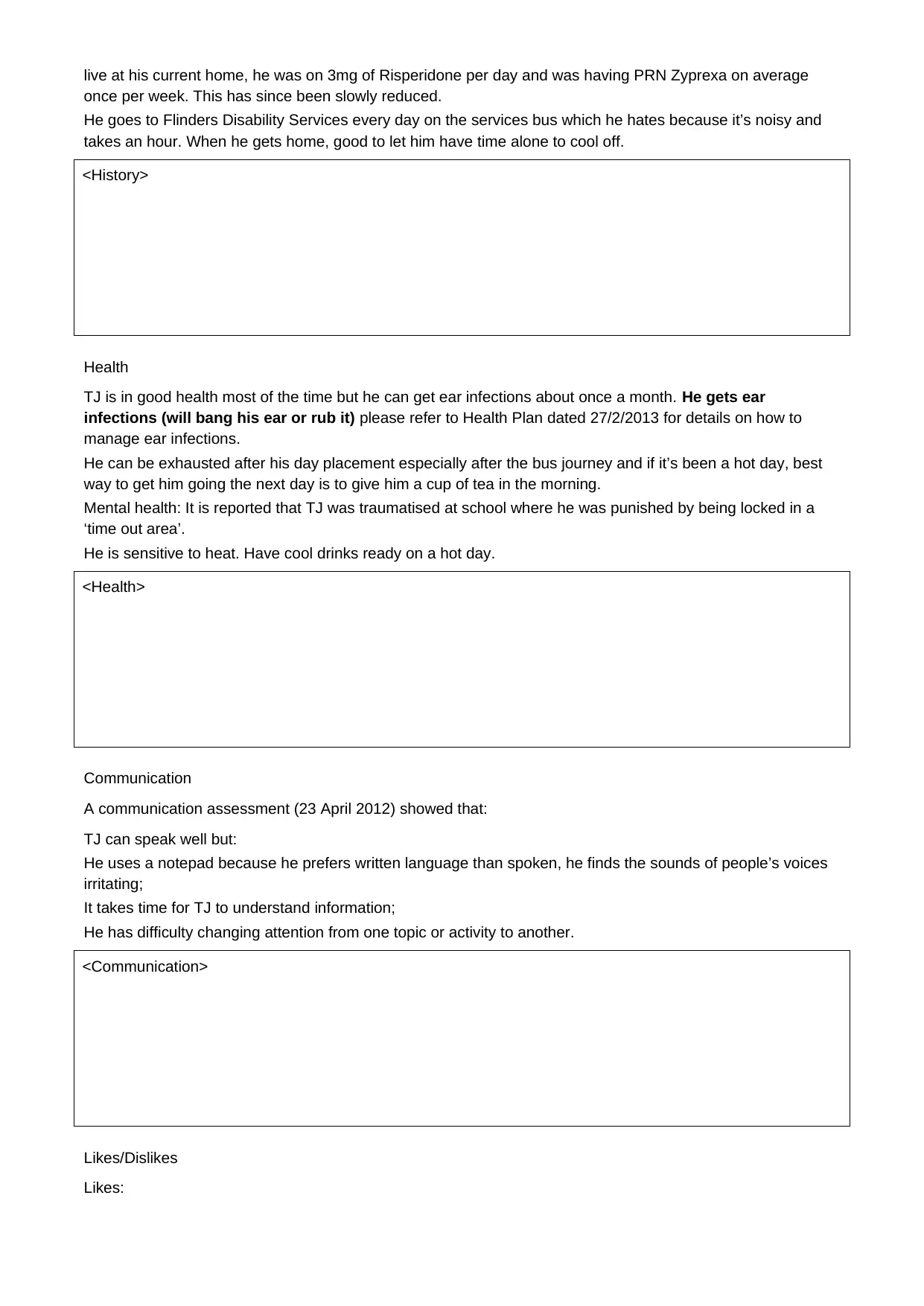
live at his current home, he was on 3mg of Risperidone per day and was having PRN Zyprexa on average
once per week. This has since been slowly reduced.
He goes to Flinders Disability Services every day on the services bus which he hates because it’s noisy and
takes an hour. When he gets home, good to let him have time alone to cool off.
<History>
Health
TJ is in good health most of the time but he can get ear infections about once a month. He gets ear
infections (will bang his ear or rub it) please refer to Health Plan dated 27/2/2013 for details on how to
manage ear infections.
He can be exhausted after his day placement especially after the bus journey and if it’s been a hot day, best
way to get him going the next day is to give him a cup of tea in the morning.
Mental health: It is reported that TJ was traumatised at school where he was punished by being locked in a
‘time out area’.
He is sensitive to heat. Have cool drinks ready on a hot day.
<Health>
Communication
A communication assessment (23 April 2012) showed that:
TJ can speak well but:
He uses a notepad because he prefers written language than spoken, he finds the sounds of people’s voices
irritating;
It takes time for TJ to understand information;
He has difficulty changing attention from one topic or activity to another.
<Communication>
Likes/Dislikes
Likes:
once per week. This has since been slowly reduced.
He goes to Flinders Disability Services every day on the services bus which he hates because it’s noisy and
takes an hour. When he gets home, good to let him have time alone to cool off.
<History>
Health
TJ is in good health most of the time but he can get ear infections about once a month. He gets ear
infections (will bang his ear or rub it) please refer to Health Plan dated 27/2/2013 for details on how to
manage ear infections.
He can be exhausted after his day placement especially after the bus journey and if it’s been a hot day, best
way to get him going the next day is to give him a cup of tea in the morning.
Mental health: It is reported that TJ was traumatised at school where he was punished by being locked in a
‘time out area’.
He is sensitive to heat. Have cool drinks ready on a hot day.
<Health>
Communication
A communication assessment (23 April 2012) showed that:
TJ can speak well but:
He uses a notepad because he prefers written language than spoken, he finds the sounds of people’s voices
irritating;
It takes time for TJ to understand information;
He has difficulty changing attention from one topic or activity to another.
<Communication>
Likes/Dislikes
Likes:
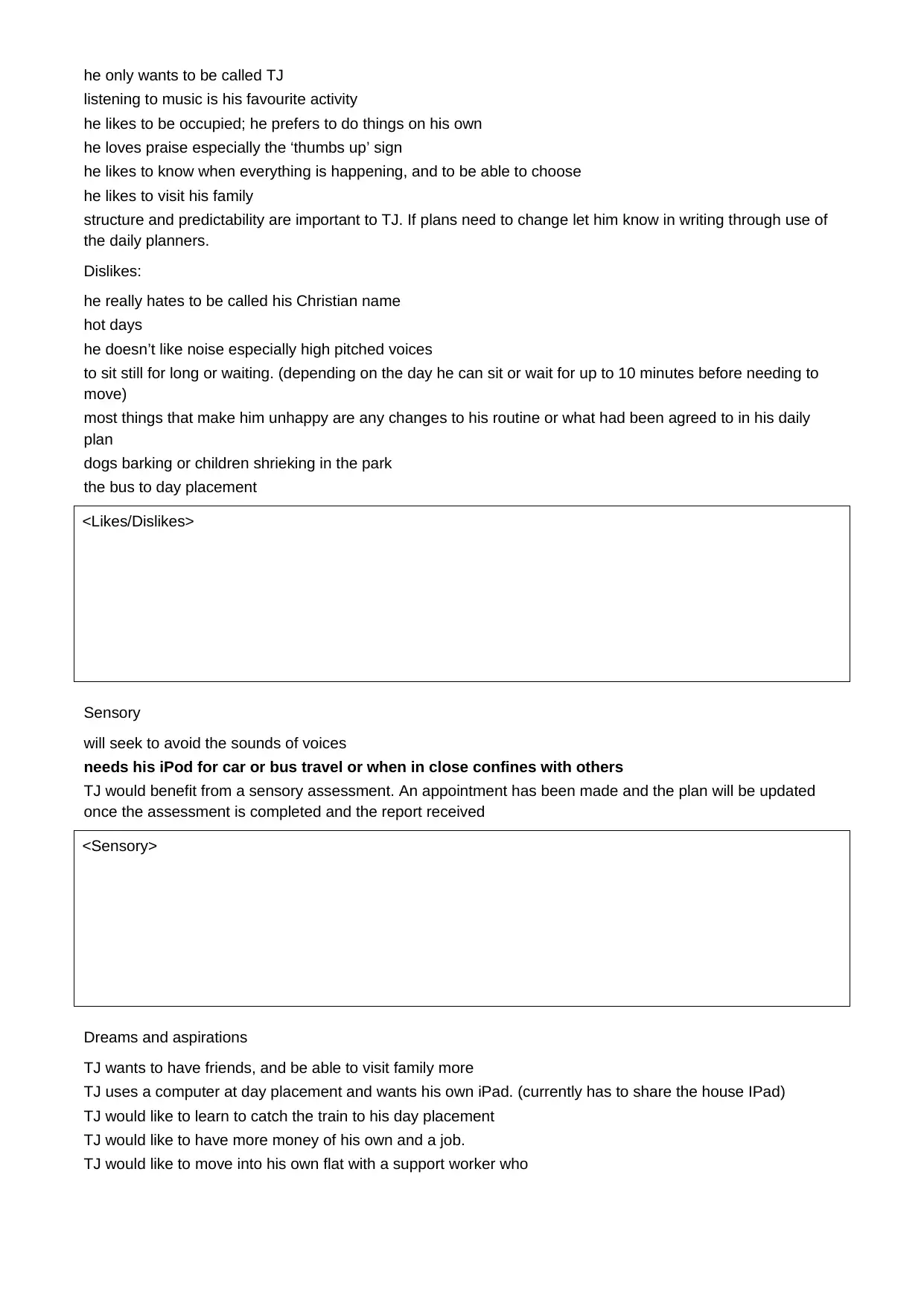
he only wants to be called TJ
listening to music is his favourite activity
he likes to be occupied; he prefers to do things on his own
he loves praise especially the ‘thumbs up’ sign
he likes to know when everything is happening, and to be able to choose
he likes to visit his family
structure and predictability are important to TJ. If plans need to change let him know in writing through use of
the daily planners.
Dislikes:
he really hates to be called his Christian name
hot days
he doesn’t like noise especially high pitched voices
to sit still for long or waiting. (depending on the day he can sit or wait for up to 10 minutes before needing to
move)
most things that make him unhappy are any changes to his routine or what had been agreed to in his daily
plan
dogs barking or children shrieking in the park
the bus to day placement
<Likes/Dislikes>
Sensory
will seek to avoid the sounds of voices
needs his iPod for car or bus travel or when in close confines with others
TJ would benefit from a sensory assessment. An appointment has been made and the plan will be updated
once the assessment is completed and the report received
<Sensory>
Dreams and aspirations
TJ wants to have friends, and be able to visit family more
TJ uses a computer at day placement and wants his own iPad. (currently has to share the house IPad)
TJ would like to learn to catch the train to his day placement
TJ would like to have more money of his own and a job.
TJ would like to move into his own flat with a support worker who
listening to music is his favourite activity
he likes to be occupied; he prefers to do things on his own
he loves praise especially the ‘thumbs up’ sign
he likes to know when everything is happening, and to be able to choose
he likes to visit his family
structure and predictability are important to TJ. If plans need to change let him know in writing through use of
the daily planners.
Dislikes:
he really hates to be called his Christian name
hot days
he doesn’t like noise especially high pitched voices
to sit still for long or waiting. (depending on the day he can sit or wait for up to 10 minutes before needing to
move)
most things that make him unhappy are any changes to his routine or what had been agreed to in his daily
plan
dogs barking or children shrieking in the park
the bus to day placement
<Likes/Dislikes>
Sensory
will seek to avoid the sounds of voices
needs his iPod for car or bus travel or when in close confines with others
TJ would benefit from a sensory assessment. An appointment has been made and the plan will be updated
once the assessment is completed and the report received
<Sensory>
Dreams and aspirations
TJ wants to have friends, and be able to visit family more
TJ uses a computer at day placement and wants his own iPad. (currently has to share the house IPad)
TJ would like to learn to catch the train to his day placement
TJ would like to have more money of his own and a job.
TJ would like to move into his own flat with a support worker who
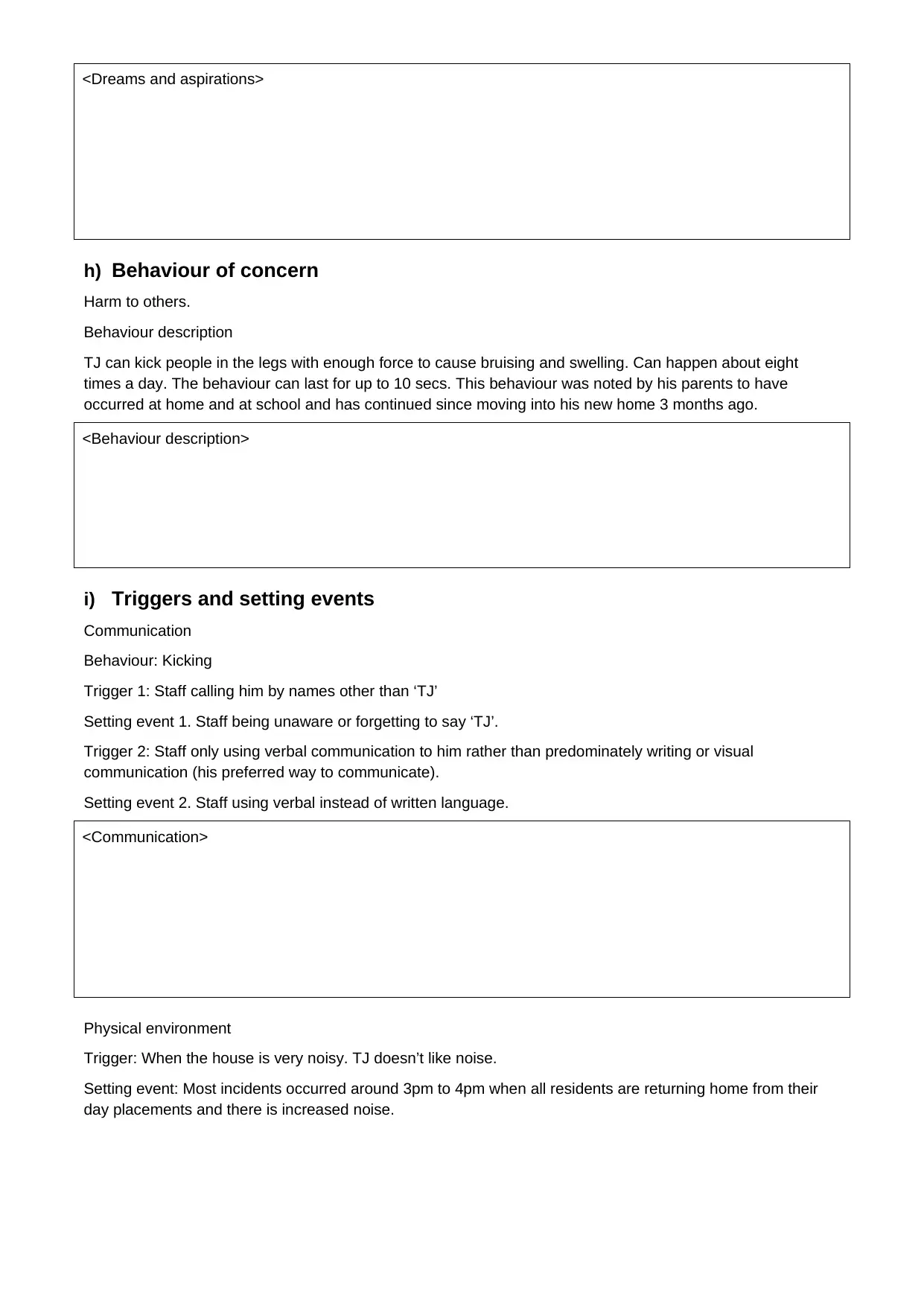
<Dreams and aspirations>
h) Behaviour of concern
Harm to others.
Behaviour description
TJ can kick people in the legs with enough force to cause bruising and swelling. Can happen about eight
times a day. The behaviour can last for up to 10 secs. This behaviour was noted by his parents to have
occurred at home and at school and has continued since moving into his new home 3 months ago.
<Behaviour description>
i) Triggers and setting events
Communication
Behaviour: Kicking
Trigger 1: Staff calling him by names other than ‘TJ’
Setting event 1. Staff being unaware or forgetting to say ‘TJ’.
Trigger 2: Staff only using verbal communication to him rather than predominately writing or visual
communication (his preferred way to communicate).
Setting event 2. Staff using verbal instead of written language.
<Communication>
Physical environment
Trigger: When the house is very noisy. TJ doesn’t like noise.
Setting event: Most incidents occurred around 3pm to 4pm when all residents are returning home from their
day placements and there is increased noise.
h) Behaviour of concern
Harm to others.
Behaviour description
TJ can kick people in the legs with enough force to cause bruising and swelling. Can happen about eight
times a day. The behaviour can last for up to 10 secs. This behaviour was noted by his parents to have
occurred at home and at school and has continued since moving into his new home 3 months ago.
<Behaviour description>
i) Triggers and setting events
Communication
Behaviour: Kicking
Trigger 1: Staff calling him by names other than ‘TJ’
Setting event 1. Staff being unaware or forgetting to say ‘TJ’.
Trigger 2: Staff only using verbal communication to him rather than predominately writing or visual
communication (his preferred way to communicate).
Setting event 2. Staff using verbal instead of written language.
<Communication>
Physical environment
Trigger: When the house is very noisy. TJ doesn’t like noise.
Setting event: Most incidents occurred around 3pm to 4pm when all residents are returning home from their
day placements and there is increased noise.
Paraphrase This Document
Need a fresh take? Get an instant paraphrase of this document with our AI Paraphraser
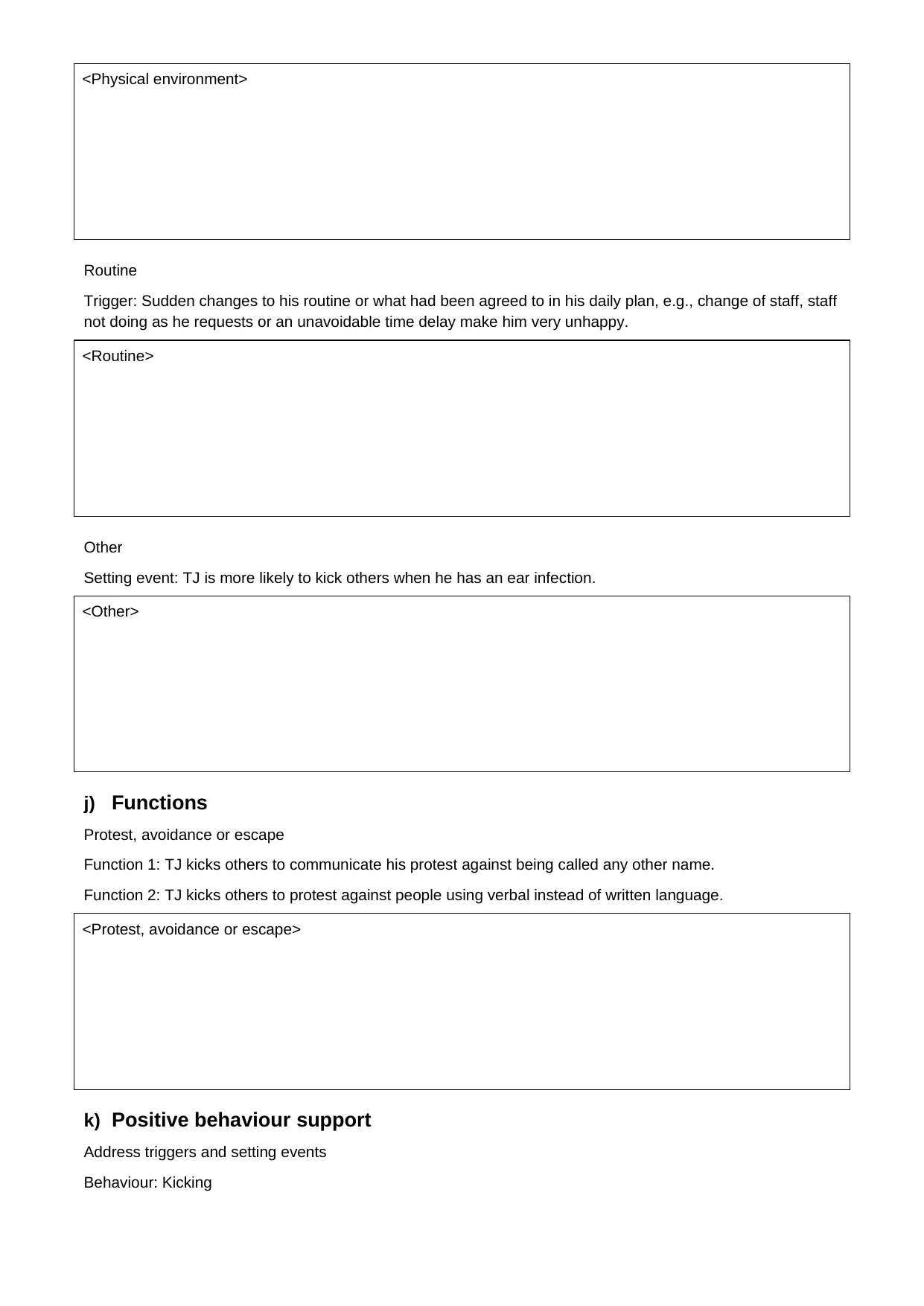
<Physical environment>
Routine
Trigger: Sudden changes to his routine or what had been agreed to in his daily plan, e.g., change of staff, staff
not doing as he requests or an unavoidable time delay make him very unhappy.
<Routine>
Other
Setting event: TJ is more likely to kick others when he has an ear infection.
<Other>
j) Functions
Protest, avoidance or escape
Function 1: TJ kicks others to communicate his protest against being called any other name.
Function 2: TJ kicks others to protest against people using verbal instead of written language.
<Protest, avoidance or escape>
k) Positive behaviour support
Address triggers and setting events
Behaviour: Kicking
Routine
Trigger: Sudden changes to his routine or what had been agreed to in his daily plan, e.g., change of staff, staff
not doing as he requests or an unavoidable time delay make him very unhappy.
<Routine>
Other
Setting event: TJ is more likely to kick others when he has an ear infection.
<Other>
j) Functions
Protest, avoidance or escape
Function 1: TJ kicks others to communicate his protest against being called any other name.
Function 2: TJ kicks others to protest against people using verbal instead of written language.
<Protest, avoidance or escape>
k) Positive behaviour support
Address triggers and setting events
Behaviour: Kicking
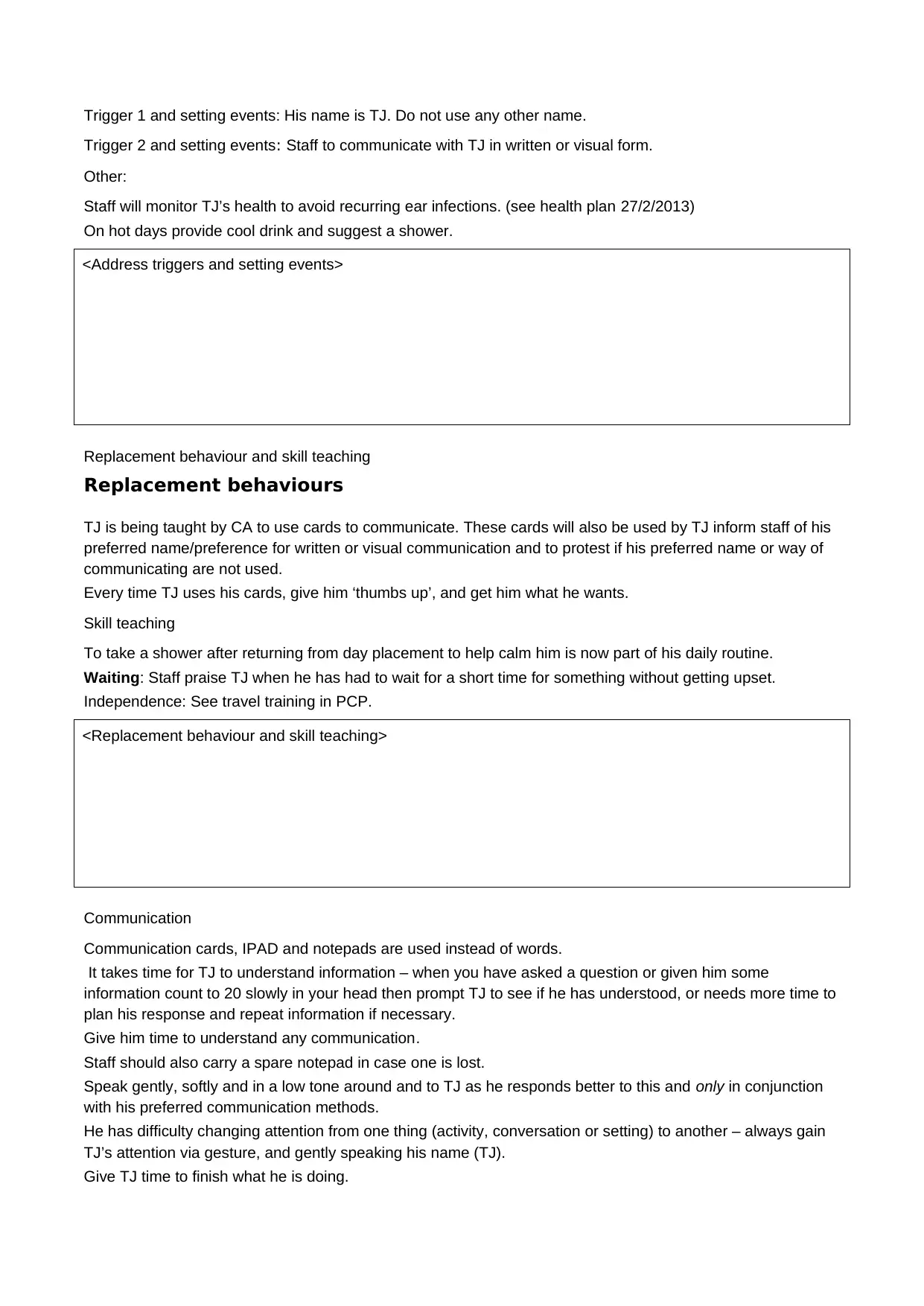
Trigger 1 and setting events: His name is TJ. Do not use any other name.
Trigger 2 and setting events: Staff to communicate with TJ in written or visual form.
Other:
Staff will monitor TJ’s health to avoid recurring ear infections. (see health plan 27/2/2013)
On hot days provide cool drink and suggest a shower.
<Address triggers and setting events>
Replacement behaviour and skill teaching
Replacement behaviours
TJ is being taught by CA to use cards to communicate. These cards will also be used by TJ inform staff of his
preferred name/preference for written or visual communication and to protest if his preferred name or way of
communicating are not used.
Every time TJ uses his cards, give him ‘thumbs up’, and get him what he wants.
Skill teaching
To take a shower after returning from day placement to help calm him is now part of his daily routine.
Waiting: Staff praise TJ when he has had to wait for a short time for something without getting upset.
Independence: See travel training in PCP.
<Replacement behaviour and skill teaching>
Communication
Communication cards, IPAD and notepads are used instead of words.
It takes time for TJ to understand information – when you have asked a question or given him some
information count to 20 slowly in your head then prompt TJ to see if he has understood, or needs more time to
plan his response and repeat information if necessary.
Give him time to understand any communication.
Staff should also carry a spare notepad in case one is lost.
Speak gently, softly and in a low tone around and to TJ as he responds better to this and only in conjunction
with his preferred communication methods.
He has difficulty changing attention from one thing (activity, conversation or setting) to another – always gain
TJ’s attention via gesture, and gently speaking his name (TJ).
Give TJ time to finish what he is doing.
Trigger 2 and setting events: Staff to communicate with TJ in written or visual form.
Other:
Staff will monitor TJ’s health to avoid recurring ear infections. (see health plan 27/2/2013)
On hot days provide cool drink and suggest a shower.
<Address triggers and setting events>
Replacement behaviour and skill teaching
Replacement behaviours
TJ is being taught by CA to use cards to communicate. These cards will also be used by TJ inform staff of his
preferred name/preference for written or visual communication and to protest if his preferred name or way of
communicating are not used.
Every time TJ uses his cards, give him ‘thumbs up’, and get him what he wants.
Skill teaching
To take a shower after returning from day placement to help calm him is now part of his daily routine.
Waiting: Staff praise TJ when he has had to wait for a short time for something without getting upset.
Independence: See travel training in PCP.
<Replacement behaviour and skill teaching>
Communication
Communication cards, IPAD and notepads are used instead of words.
It takes time for TJ to understand information – when you have asked a question or given him some
information count to 20 slowly in your head then prompt TJ to see if he has understood, or needs more time to
plan his response and repeat information if necessary.
Give him time to understand any communication.
Staff should also carry a spare notepad in case one is lost.
Speak gently, softly and in a low tone around and to TJ as he responds better to this and only in conjunction
with his preferred communication methods.
He has difficulty changing attention from one thing (activity, conversation or setting) to another – always gain
TJ’s attention via gesture, and gently speaking his name (TJ).
Give TJ time to finish what he is doing.
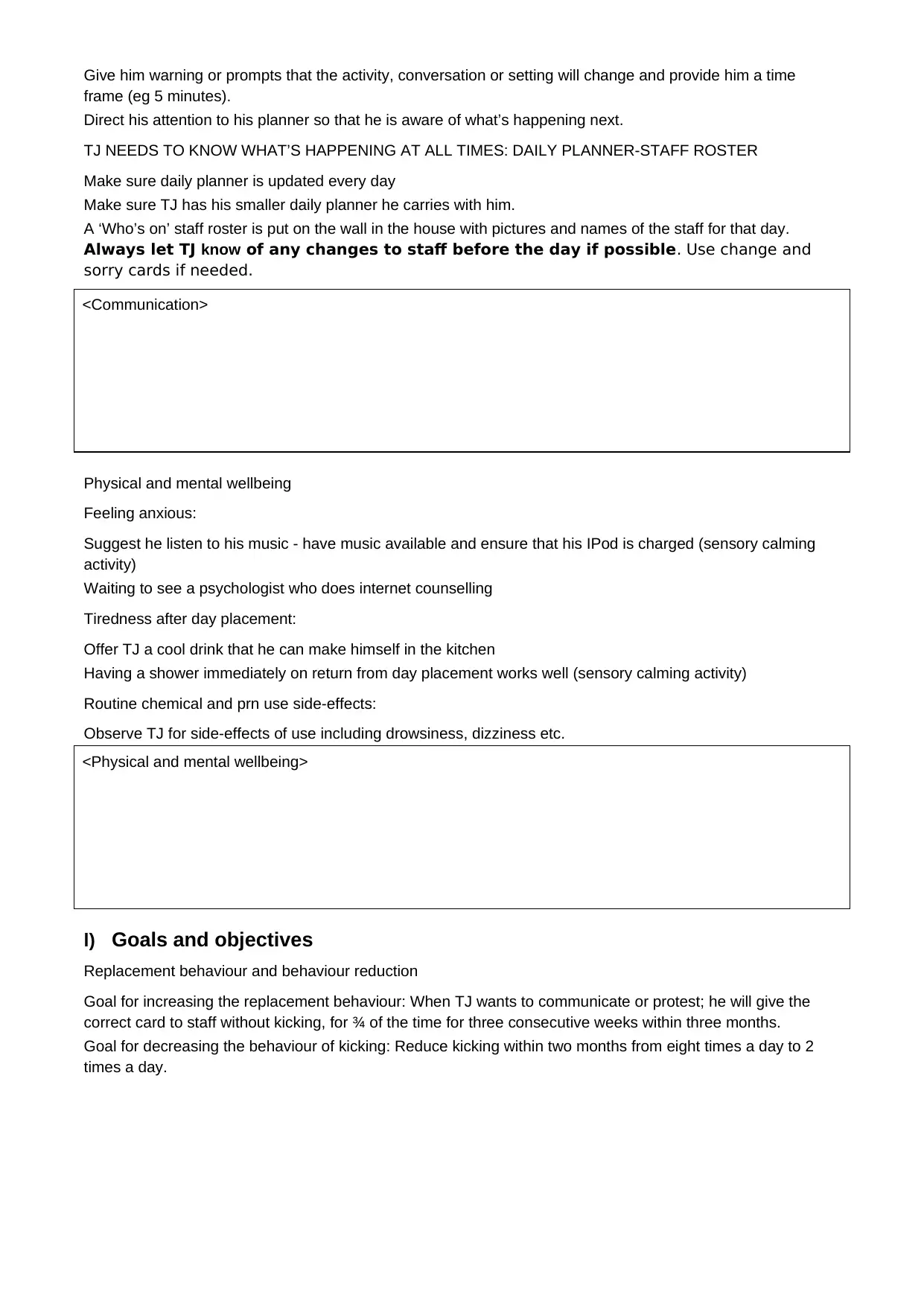
Give him warning or prompts that the activity, conversation or setting will change and provide him a time
frame (eg 5 minutes).
Direct his attention to his planner so that he is aware of what’s happening next.
TJ NEEDS TO KNOW WHAT’S HAPPENING AT ALL TIMES: DAILY PLANNER-STAFF ROSTER
Make sure daily planner is updated every day
Make sure TJ has his smaller daily planner he carries with him.
A ‘Who’s on’ staff roster is put on the wall in the house with pictures and names of the staff for that day.
Always let TJ know of any changes to staff before the day if possible. Use change and
sorry cards if needed.
<Communication>
Physical and mental wellbeing
Feeling anxious:
Suggest he listen to his music - have music available and ensure that his IPod is charged (sensory calming
activity)
Waiting to see a psychologist who does internet counselling
Tiredness after day placement:
Offer TJ a cool drink that he can make himself in the kitchen
Having a shower immediately on return from day placement works well (sensory calming activity)
Routine chemical and prn use side-effects:
Observe TJ for side-effects of use including drowsiness, dizziness etc.
<Physical and mental wellbeing>
l) Goals and objectives
Replacement behaviour and behaviour reduction
Goal for increasing the replacement behaviour: When TJ wants to communicate or protest; he will give the
correct card to staff without kicking, for ¾ of the time for three consecutive weeks within three months.
Goal for decreasing the behaviour of kicking: Reduce kicking within two months from eight times a day to 2
times a day.
frame (eg 5 minutes).
Direct his attention to his planner so that he is aware of what’s happening next.
TJ NEEDS TO KNOW WHAT’S HAPPENING AT ALL TIMES: DAILY PLANNER-STAFF ROSTER
Make sure daily planner is updated every day
Make sure TJ has his smaller daily planner he carries with him.
A ‘Who’s on’ staff roster is put on the wall in the house with pictures and names of the staff for that day.
Always let TJ know of any changes to staff before the day if possible. Use change and
sorry cards if needed.
<Communication>
Physical and mental wellbeing
Feeling anxious:
Suggest he listen to his music - have music available and ensure that his IPod is charged (sensory calming
activity)
Waiting to see a psychologist who does internet counselling
Tiredness after day placement:
Offer TJ a cool drink that he can make himself in the kitchen
Having a shower immediately on return from day placement works well (sensory calming activity)
Routine chemical and prn use side-effects:
Observe TJ for side-effects of use including drowsiness, dizziness etc.
<Physical and mental wellbeing>
l) Goals and objectives
Replacement behaviour and behaviour reduction
Goal for increasing the replacement behaviour: When TJ wants to communicate or protest; he will give the
correct card to staff without kicking, for ¾ of the time for three consecutive weeks within three months.
Goal for decreasing the behaviour of kicking: Reduce kicking within two months from eight times a day to 2
times a day.
Secure Best Marks with AI Grader
Need help grading? Try our AI Grader for instant feedback on your assignments.
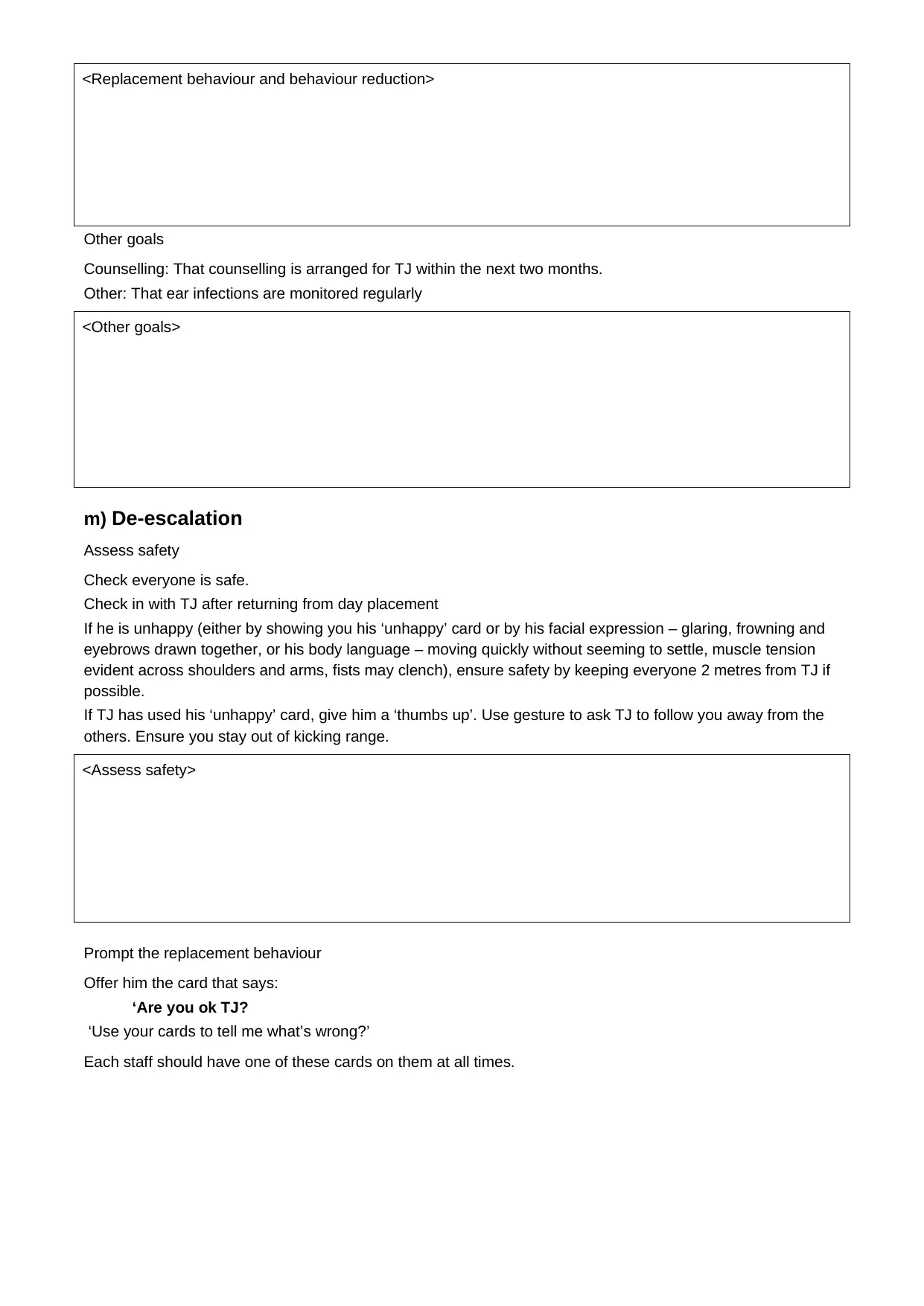
<Replacement behaviour and behaviour reduction>
Other goals
Counselling: That counselling is arranged for TJ within the next two months.
Other: That ear infections are monitored regularly
<Other goals>
m) De-escalation
Assess safety
Check everyone is safe.
Check in with TJ after returning from day placement
If he is unhappy (either by showing you his ‘unhappy’ card or by his facial expression – glaring, frowning and
eyebrows drawn together, or his body language – moving quickly without seeming to settle, muscle tension
evident across shoulders and arms, fists may clench), ensure safety by keeping everyone 2 metres from TJ if
possible.
If TJ has used his ‘unhappy’ card, give him a ‘thumbs up’. Use gesture to ask TJ to follow you away from the
others. Ensure you stay out of kicking range.
<Assess safety>
Prompt the replacement behaviour
Offer him the card that says:
‘Are you ok TJ?
‘Use your cards to tell me what’s wrong?’
Each staff should have one of these cards on them at all times.
Other goals
Counselling: That counselling is arranged for TJ within the next two months.
Other: That ear infections are monitored regularly
<Other goals>
m) De-escalation
Assess safety
Check everyone is safe.
Check in with TJ after returning from day placement
If he is unhappy (either by showing you his ‘unhappy’ card or by his facial expression – glaring, frowning and
eyebrows drawn together, or his body language – moving quickly without seeming to settle, muscle tension
evident across shoulders and arms, fists may clench), ensure safety by keeping everyone 2 metres from TJ if
possible.
If TJ has used his ‘unhappy’ card, give him a ‘thumbs up’. Use gesture to ask TJ to follow you away from the
others. Ensure you stay out of kicking range.
<Assess safety>
Prompt the replacement behaviour
Offer him the card that says:
‘Are you ok TJ?
‘Use your cards to tell me what’s wrong?’
Each staff should have one of these cards on them at all times.

<Prompt the replacement behaviour>
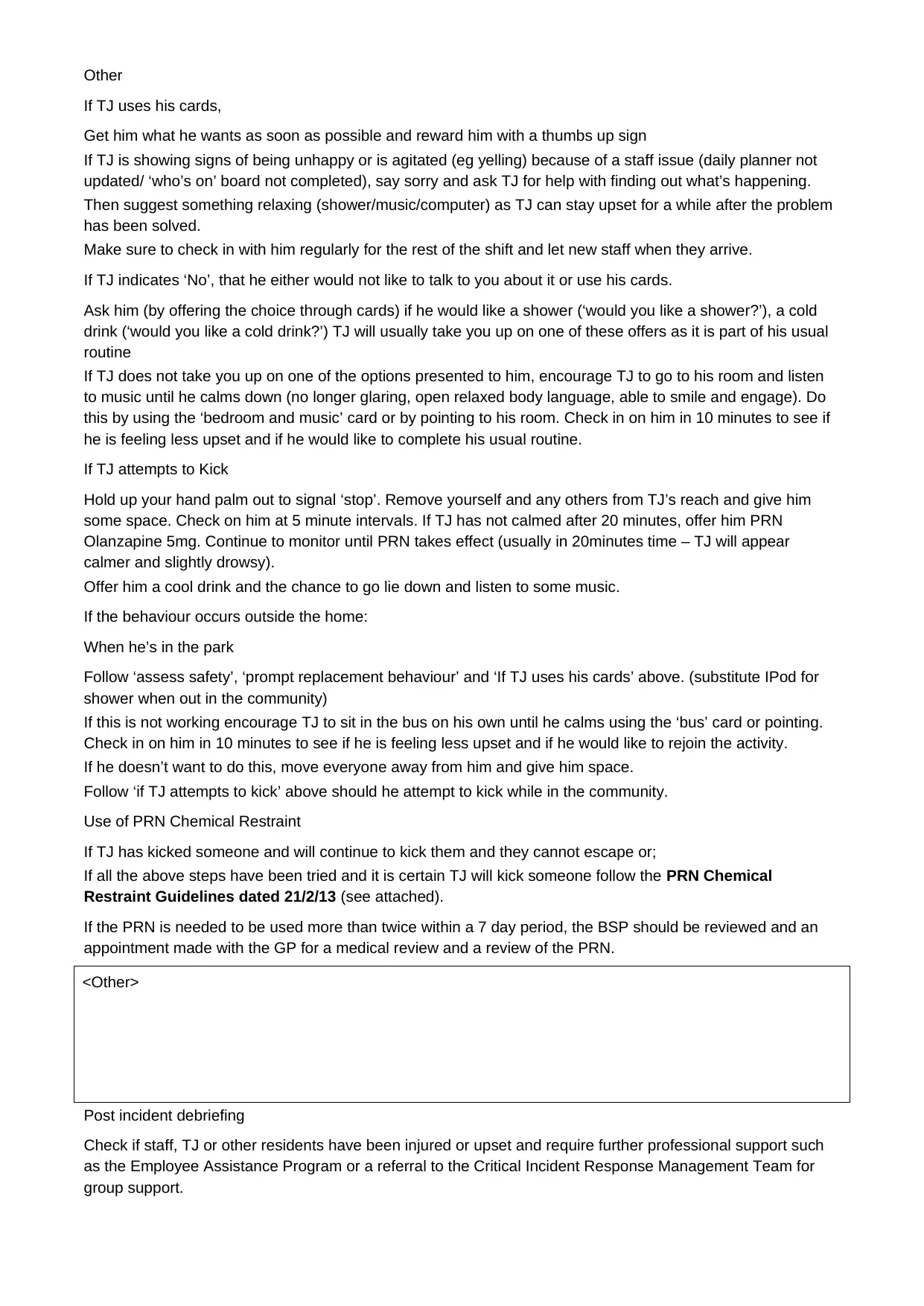
Other
If TJ uses his cards,
Get him what he wants as soon as possible and reward him with a thumbs up sign
If TJ is showing signs of being unhappy or is agitated (eg yelling) because of a staff issue (daily planner not
updated/ ‘who’s on’ board not completed), say sorry and ask TJ for help with finding out what’s happening.
Then suggest something relaxing (shower/music/computer) as TJ can stay upset for a while after the problem
has been solved.
Make sure to check in with him regularly for the rest of the shift and let new staff when they arrive.
If TJ indicates ‘No’, that he either would not like to talk to you about it or use his cards.
Ask him (by offering the choice through cards) if he would like a shower (‘would you like a shower?’), a cold
drink (‘would you like a cold drink?’) TJ will usually take you up on one of these offers as it is part of his usual
routine
If TJ does not take you up on one of the options presented to him, encourage TJ to go to his room and listen
to music until he calms down (no longer glaring, open relaxed body language, able to smile and engage). Do
this by using the ‘bedroom and music’ card or by pointing to his room. Check in on him in 10 minutes to see if
he is feeling less upset and if he would like to complete his usual routine.
If TJ attempts to Kick
Hold up your hand palm out to signal ‘stop’. Remove yourself and any others from TJ’s reach and give him
some space. Check on him at 5 minute intervals. If TJ has not calmed after 20 minutes, offer him PRN
Olanzapine 5mg. Continue to monitor until PRN takes effect (usually in 20minutes time – TJ will appear
calmer and slightly drowsy).
Offer him a cool drink and the chance to go lie down and listen to some music.
If the behaviour occurs outside the home:
When he’s in the park
Follow ‘assess safety’, ‘prompt replacement behaviour’ and ‘If TJ uses his cards’ above. (substitute IPod for
shower when out in the community)
If this is not working encourage TJ to sit in the bus on his own until he calms using the ‘bus’ card or pointing.
Check in on him in 10 minutes to see if he is feeling less upset and if he would like to rejoin the activity.
If he doesn’t want to do this, move everyone away from him and give him space.
Follow ‘if TJ attempts to kick’ above should he attempt to kick while in the community.
Use of PRN Chemical Restraint
If TJ has kicked someone and will continue to kick them and they cannot escape or;
If all the above steps have been tried and it is certain TJ will kick someone follow the PRN Chemical
Restraint Guidelines dated 21/2/13 (see attached).
If the PRN is needed to be used more than twice within a 7 day period, the BSP should be reviewed and an
appointment made with the GP for a medical review and a review of the PRN.
<Other>
Post incident debriefing
Check if staff, TJ or other residents have been injured or upset and require further professional support such
as the Employee Assistance Program or a referral to the Critical Incident Response Management Team for
group support.
If TJ uses his cards,
Get him what he wants as soon as possible and reward him with a thumbs up sign
If TJ is showing signs of being unhappy or is agitated (eg yelling) because of a staff issue (daily planner not
updated/ ‘who’s on’ board not completed), say sorry and ask TJ for help with finding out what’s happening.
Then suggest something relaxing (shower/music/computer) as TJ can stay upset for a while after the problem
has been solved.
Make sure to check in with him regularly for the rest of the shift and let new staff when they arrive.
If TJ indicates ‘No’, that he either would not like to talk to you about it or use his cards.
Ask him (by offering the choice through cards) if he would like a shower (‘would you like a shower?’), a cold
drink (‘would you like a cold drink?’) TJ will usually take you up on one of these offers as it is part of his usual
routine
If TJ does not take you up on one of the options presented to him, encourage TJ to go to his room and listen
to music until he calms down (no longer glaring, open relaxed body language, able to smile and engage). Do
this by using the ‘bedroom and music’ card or by pointing to his room. Check in on him in 10 minutes to see if
he is feeling less upset and if he would like to complete his usual routine.
If TJ attempts to Kick
Hold up your hand palm out to signal ‘stop’. Remove yourself and any others from TJ’s reach and give him
some space. Check on him at 5 minute intervals. If TJ has not calmed after 20 minutes, offer him PRN
Olanzapine 5mg. Continue to monitor until PRN takes effect (usually in 20minutes time – TJ will appear
calmer and slightly drowsy).
Offer him a cool drink and the chance to go lie down and listen to some music.
If the behaviour occurs outside the home:
When he’s in the park
Follow ‘assess safety’, ‘prompt replacement behaviour’ and ‘If TJ uses his cards’ above. (substitute IPod for
shower when out in the community)
If this is not working encourage TJ to sit in the bus on his own until he calms using the ‘bus’ card or pointing.
Check in on him in 10 minutes to see if he is feeling less upset and if he would like to rejoin the activity.
If he doesn’t want to do this, move everyone away from him and give him space.
Follow ‘if TJ attempts to kick’ above should he attempt to kick while in the community.
Use of PRN Chemical Restraint
If TJ has kicked someone and will continue to kick them and they cannot escape or;
If all the above steps have been tried and it is certain TJ will kick someone follow the PRN Chemical
Restraint Guidelines dated 21/2/13 (see attached).
If the PRN is needed to be used more than twice within a 7 day period, the BSP should be reviewed and an
appointment made with the GP for a medical review and a review of the PRN.
<Other>
Post incident debriefing
Check if staff, TJ or other residents have been injured or upset and require further professional support such
as the Employee Assistance Program or a referral to the Critical Incident Response Management Team for
group support.
Paraphrase This Document
Need a fresh take? Get an instant paraphrase of this document with our AI Paraphraser
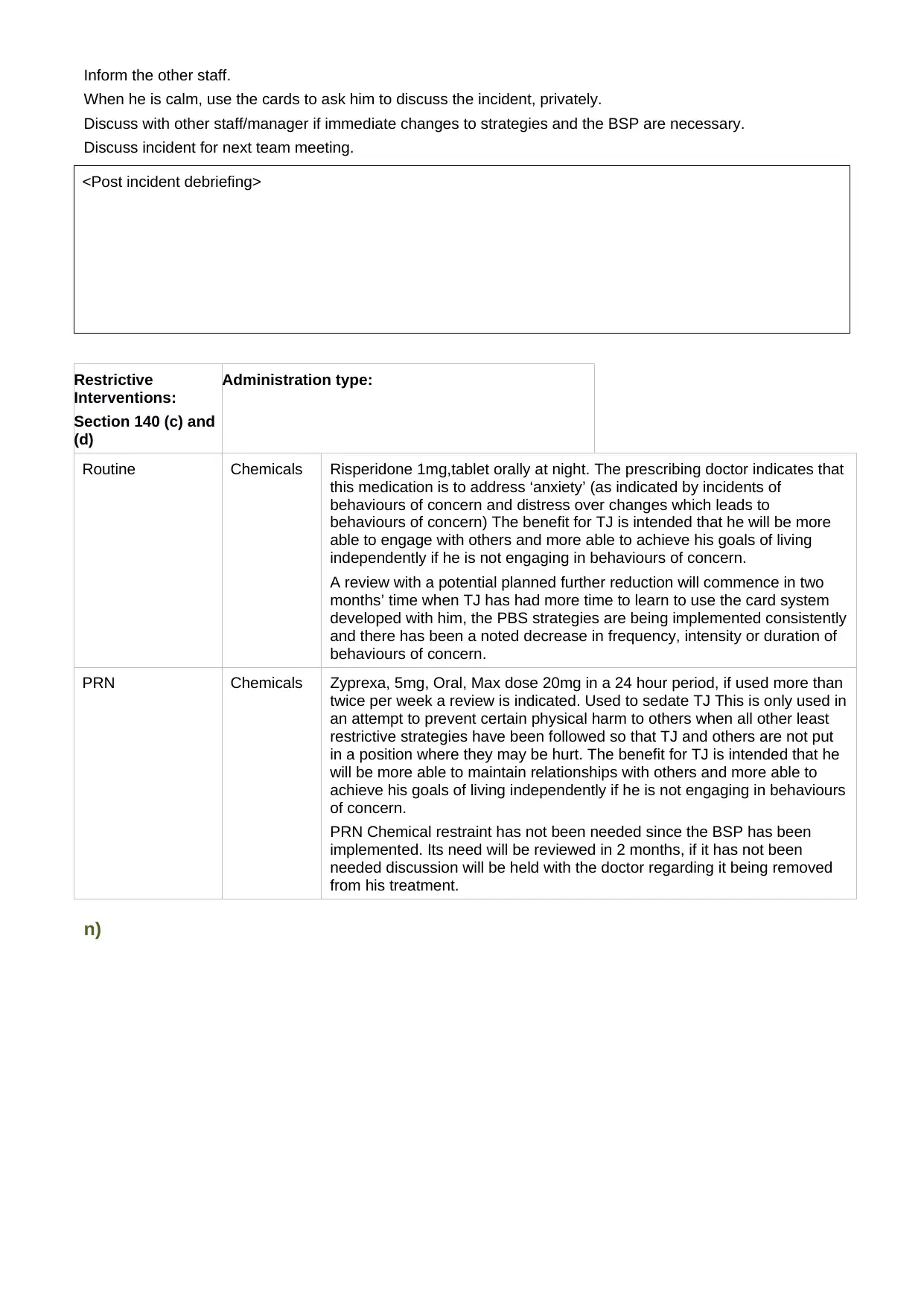
Inform the other staff.
When he is calm, use the cards to ask him to discuss the incident, privately.
Discuss with other staff/manager if immediate changes to strategies and the BSP are necessary.
Discuss incident for next team meeting.
<Post incident debriefing>
Restrictive
Interventions:
Section 140 (c) and
(d)
Administration type:
Routine Chemicals Risperidone 1mg,tablet orally at night. The prescribing doctor indicates that
this medication is to address ‘anxiety’ (as indicated by incidents of
behaviours of concern and distress over changes which leads to
behaviours of concern) The benefit for TJ is intended that he will be more
able to engage with others and more able to achieve his goals of living
independently if he is not engaging in behaviours of concern.
A review with a potential planned further reduction will commence in two
months’ time when TJ has had more time to learn to use the card system
developed with him, the PBS strategies are being implemented consistently
and there has been a noted decrease in frequency, intensity or duration of
behaviours of concern.
PRN Chemicals Zyprexa, 5mg, Oral, Max dose 20mg in a 24 hour period, if used more than
twice per week a review is indicated. Used to sedate TJ This is only used in
an attempt to prevent certain physical harm to others when all other least
restrictive strategies have been followed so that TJ and others are not put
in a position where they may be hurt. The benefit for TJ is intended that he
will be more able to maintain relationships with others and more able to
achieve his goals of living independently if he is not engaging in behaviours
of concern.
PRN Chemical restraint has not been needed since the BSP has been
implemented. Its need will be reviewed in 2 months, if it has not been
needed discussion will be held with the doctor regarding it being removed
from his treatment.
n)
When he is calm, use the cards to ask him to discuss the incident, privately.
Discuss with other staff/manager if immediate changes to strategies and the BSP are necessary.
Discuss incident for next team meeting.
<Post incident debriefing>
Restrictive
Interventions:
Section 140 (c) and
(d)
Administration type:
Routine Chemicals Risperidone 1mg,tablet orally at night. The prescribing doctor indicates that
this medication is to address ‘anxiety’ (as indicated by incidents of
behaviours of concern and distress over changes which leads to
behaviours of concern) The benefit for TJ is intended that he will be more
able to engage with others and more able to achieve his goals of living
independently if he is not engaging in behaviours of concern.
A review with a potential planned further reduction will commence in two
months’ time when TJ has had more time to learn to use the card system
developed with him, the PBS strategies are being implemented consistently
and there has been a noted decrease in frequency, intensity or duration of
behaviours of concern.
PRN Chemicals Zyprexa, 5mg, Oral, Max dose 20mg in a 24 hour period, if used more than
twice per week a review is indicated. Used to sedate TJ This is only used in
an attempt to prevent certain physical harm to others when all other least
restrictive strategies have been followed so that TJ and others are not put
in a position where they may be hurt. The benefit for TJ is intended that he
will be more able to maintain relationships with others and more able to
achieve his goals of living independently if he is not engaging in behaviours
of concern.
PRN Chemical restraint has not been needed since the BSP has been
implemented. Its need will be reviewed in 2 months, if it has not been
needed discussion will be held with the doctor regarding it being removed
from his treatment.
n)

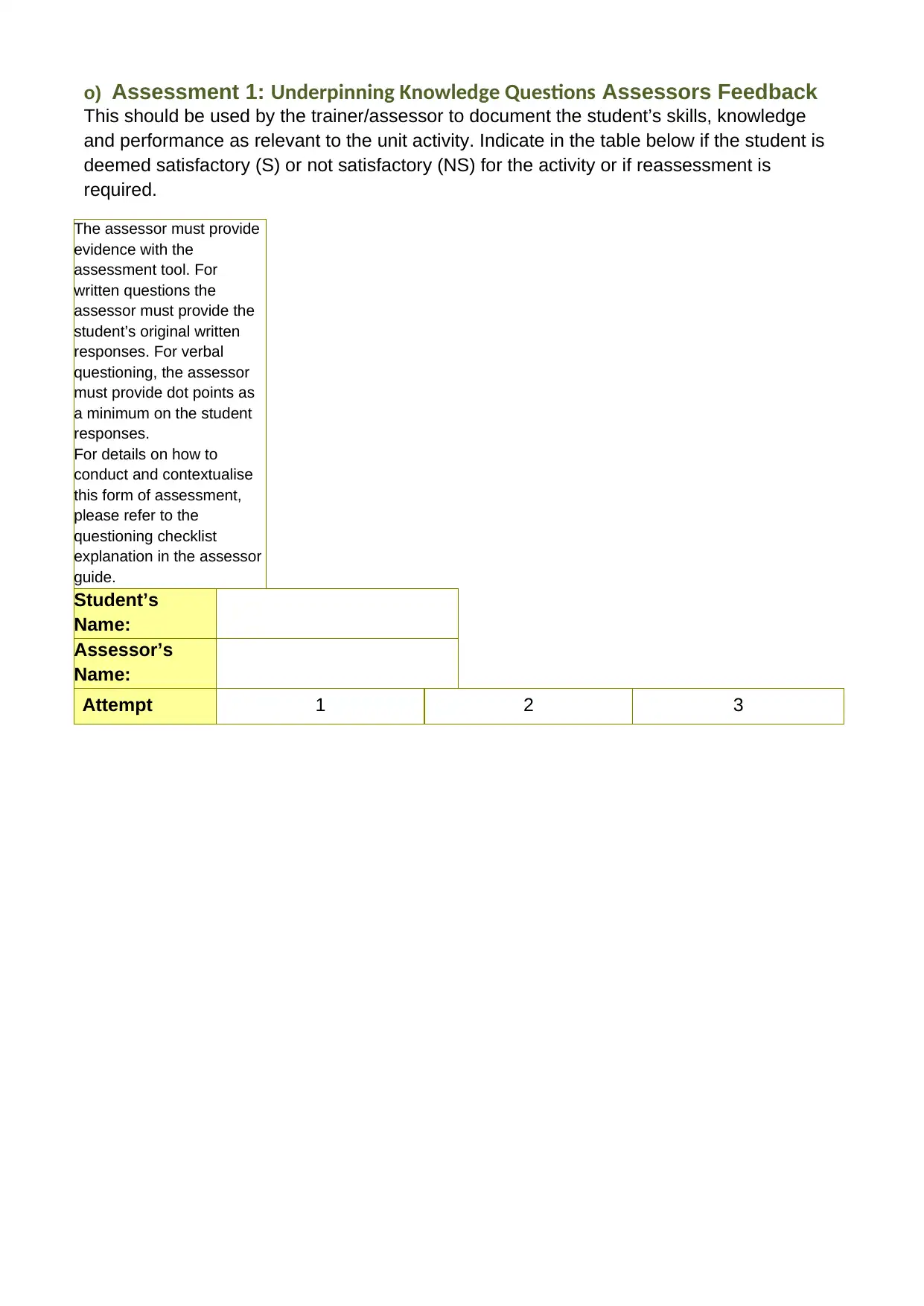
o) Assessment 1: Underpinning Knowledge Questions Assessors Feedback
This should be used by the trainer/assessor to document the student’s skills, knowledge
and performance as relevant to the unit activity. Indicate in the table below if the student is
deemed satisfactory (S) or not satisfactory (NS) for the activity or if reassessment is
required.
The assessor must provide
evidence with the
assessment tool. For
written questions the
assessor must provide the
student’s original written
responses. For verbal
questioning, the assessor
must provide dot points as
a minimum on the student
responses.
For details on how to
conduct and contextualise
this form of assessment,
please refer to the
questioning checklist
explanation in the assessor
guide.
Student’s
Name:
Assessor’s
Name:
Attempt 1 2 3
This should be used by the trainer/assessor to document the student’s skills, knowledge
and performance as relevant to the unit activity. Indicate in the table below if the student is
deemed satisfactory (S) or not satisfactory (NS) for the activity or if reassessment is
required.
The assessor must provide
evidence with the
assessment tool. For
written questions the
assessor must provide the
student’s original written
responses. For verbal
questioning, the assessor
must provide dot points as
a minimum on the student
responses.
For details on how to
conduct and contextualise
this form of assessment,
please refer to the
questioning checklist
explanation in the assessor
guide.
Student’s
Name:
Assessor’s
Name:
Attempt 1 2 3
Secure Best Marks with AI Grader
Need help grading? Try our AI Grader for instant feedback on your assignments.
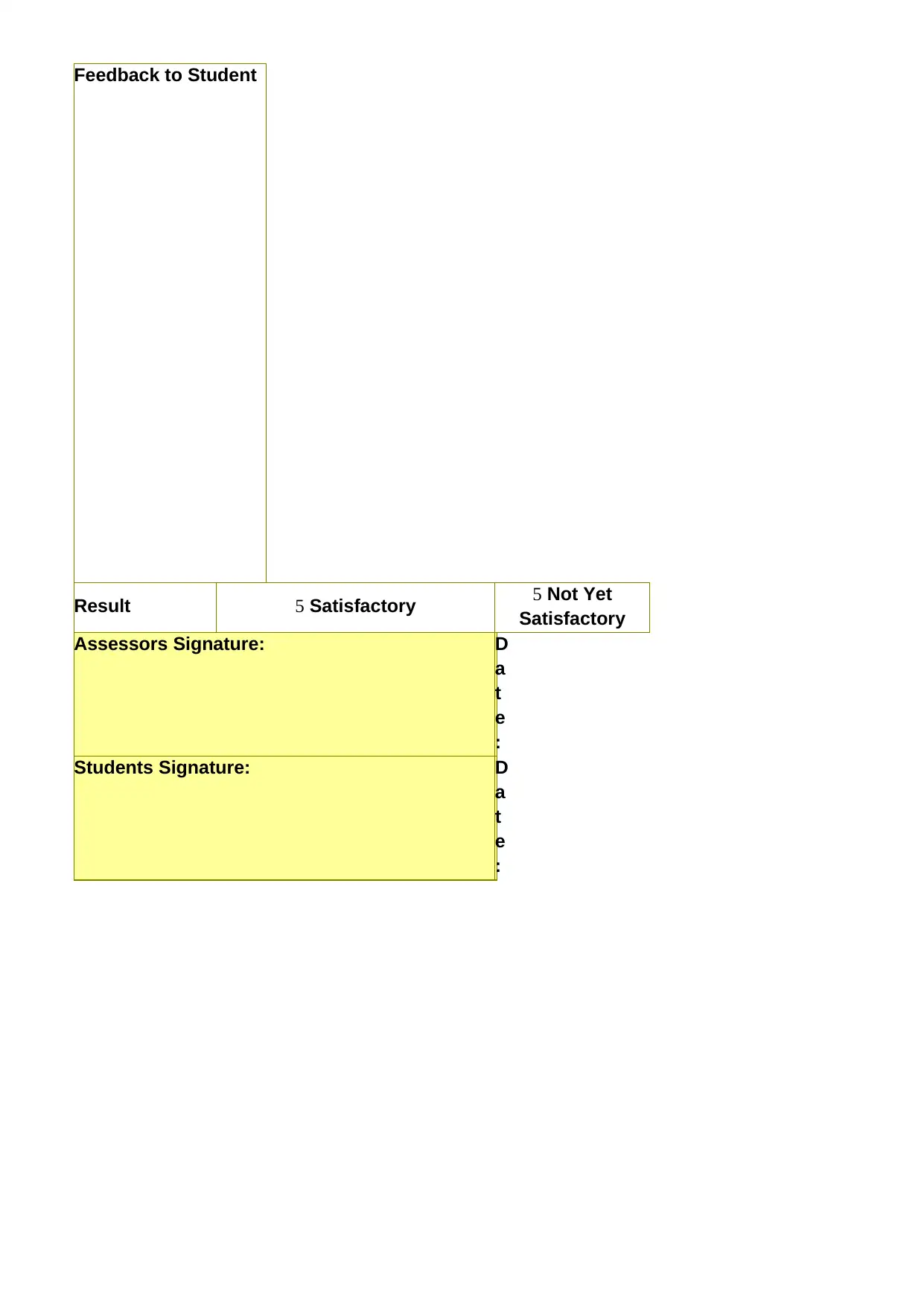
Feedback to Student
Result Satisfactory Not Yet
Satisfactory
Assessors Signature: D
a
t
e
:
Students Signature: D
a
t
e
:
Result Satisfactory Not Yet
Satisfactory
Assessors Signature: D
a
t
e
:
Students Signature: D
a
t
e
:

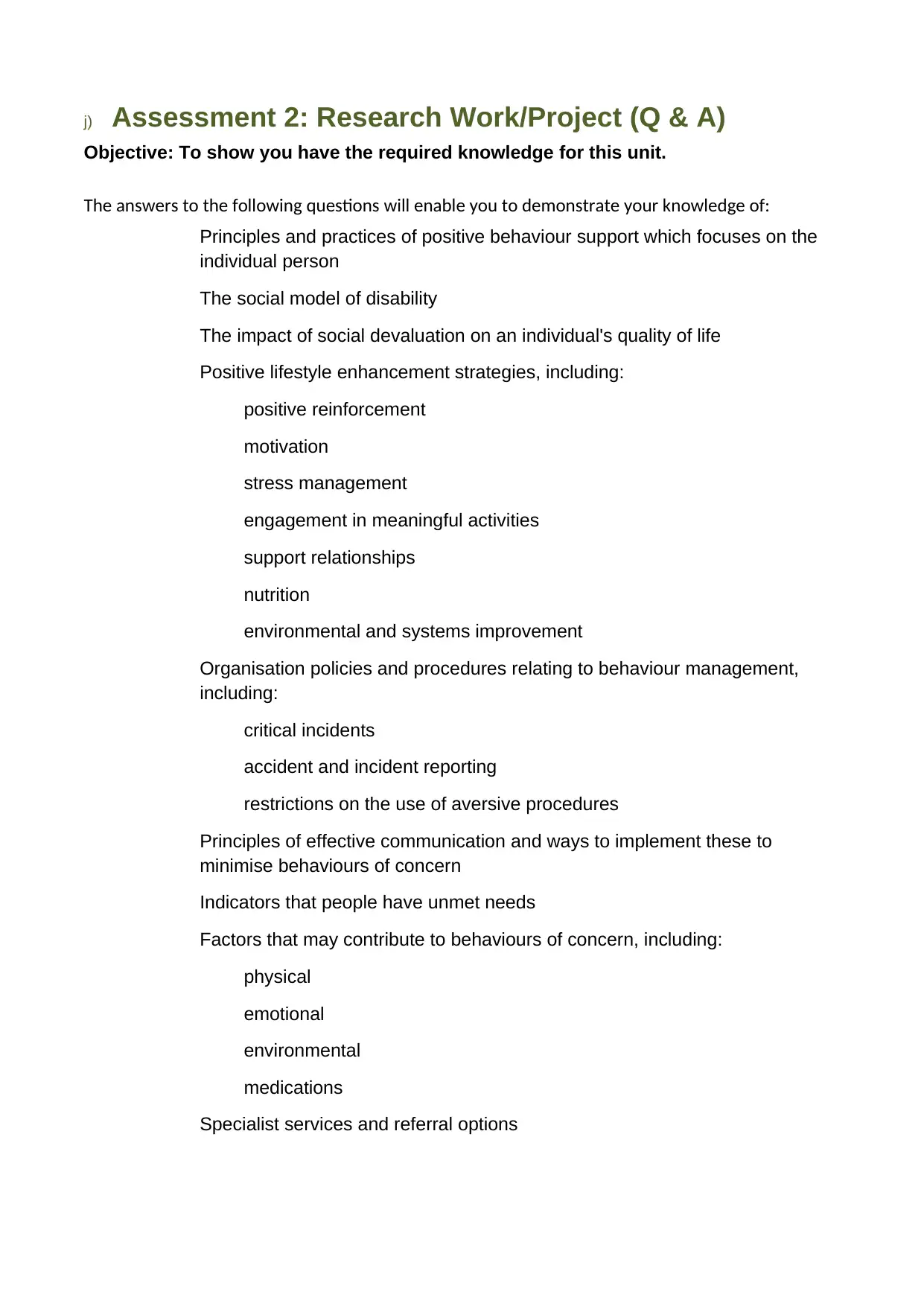
j) Assessment 2: Research Work/Project (Q & A)
Objective: To show you have the required knowledge for this unit.
The answers to the following questions will enable you to demonstrate your knowledge of:
Principles and practices of positive behaviour support which focuses on the
individual person
The social model of disability
The impact of social devaluation on an individual's quality of life
Positive lifestyle enhancement strategies, including:
positive reinforcement
motivation
stress management
engagement in meaningful activities
support relationships
nutrition
environmental and systems improvement
Organisation policies and procedures relating to behaviour management,
including:
critical incidents
accident and incident reporting
restrictions on the use of aversive procedures
Principles of effective communication and ways to implement these to
minimise behaviours of concern
Indicators that people have unmet needs
Factors that may contribute to behaviours of concern, including:
physical
emotional
environmental
medications
Specialist services and referral options
Objective: To show you have the required knowledge for this unit.
The answers to the following questions will enable you to demonstrate your knowledge of:
Principles and practices of positive behaviour support which focuses on the
individual person
The social model of disability
The impact of social devaluation on an individual's quality of life
Positive lifestyle enhancement strategies, including:
positive reinforcement
motivation
stress management
engagement in meaningful activities
support relationships
nutrition
environmental and systems improvement
Organisation policies and procedures relating to behaviour management,
including:
critical incidents
accident and incident reporting
restrictions on the use of aversive procedures
Principles of effective communication and ways to implement these to
minimise behaviours of concern
Indicators that people have unmet needs
Factors that may contribute to behaviours of concern, including:
physical
emotional
environmental
medications
Specialist services and referral options
Paraphrase This Document
Need a fresh take? Get an instant paraphrase of this document with our AI Paraphraser
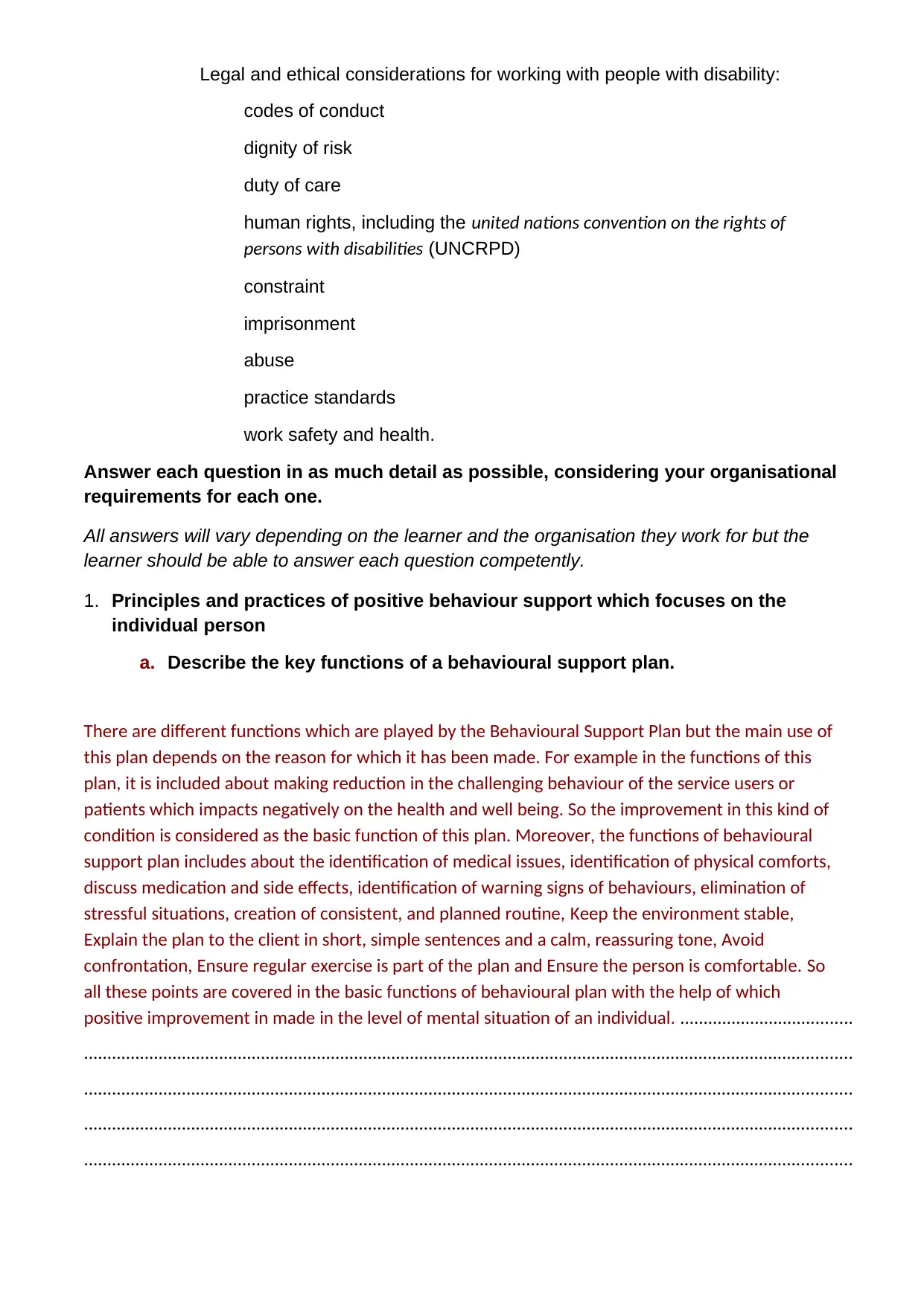
Legal and ethical considerations for working with people with disability:
codes of conduct
dignity of risk
duty of care
human rights, including the united nations convention on the rights of
persons with disabilities (UNCRPD)
constraint
imprisonment
abuse
practice standards
work safety and health.
Answer each question in as much detail as possible, considering your organisational
requirements for each one.
All answers will vary depending on the learner and the organisation they work for but the
learner should be able to answer each question competently.
1. Principles and practices of positive behaviour support which focuses on the
individual person
a. Describe the key functions of a behavioural support plan.
There are different functions which are played by the Behavioural Support Plan but the main use of
this plan depends on the reason for which it has been made. For example in the functions of this
plan, it is included about making reduction in the challenging behaviour of the service users or
patients which impacts negatively on the health and well being. So the improvement in this kind of
condition is considered as the basic function of this plan. Moreover, the functions of behavioural
support plan includes about the identification of medical issues, identification of physical comforts,
discuss medication and side effects, identification of warning signs of behaviours, elimination of
stressful situations, creation of consistent, and planned routine, Keep the environment stable,
Explain the plan to the client in short, simple sentences and a calm, reassuring tone, Avoid
confrontation, Ensure regular exercise is part of the plan and Ensure the person is comfortable. So
all these points are covered in the basic functions of behavioural plan with the help of which
positive improvement in made in the level of mental situation of an individual. .....................................
.....................................................................................................................................................................
.....................................................................................................................................................................
.....................................................................................................................................................................
.....................................................................................................................................................................
codes of conduct
dignity of risk
duty of care
human rights, including the united nations convention on the rights of
persons with disabilities (UNCRPD)
constraint
imprisonment
abuse
practice standards
work safety and health.
Answer each question in as much detail as possible, considering your organisational
requirements for each one.
All answers will vary depending on the learner and the organisation they work for but the
learner should be able to answer each question competently.
1. Principles and practices of positive behaviour support which focuses on the
individual person
a. Describe the key functions of a behavioural support plan.
There are different functions which are played by the Behavioural Support Plan but the main use of
this plan depends on the reason for which it has been made. For example in the functions of this
plan, it is included about making reduction in the challenging behaviour of the service users or
patients which impacts negatively on the health and well being. So the improvement in this kind of
condition is considered as the basic function of this plan. Moreover, the functions of behavioural
support plan includes about the identification of medical issues, identification of physical comforts,
discuss medication and side effects, identification of warning signs of behaviours, elimination of
stressful situations, creation of consistent, and planned routine, Keep the environment stable,
Explain the plan to the client in short, simple sentences and a calm, reassuring tone, Avoid
confrontation, Ensure regular exercise is part of the plan and Ensure the person is comfortable. So
all these points are covered in the basic functions of behavioural plan with the help of which
positive improvement in made in the level of mental situation of an individual. .....................................
.....................................................................................................................................................................
.....................................................................................................................................................................
.....................................................................................................................................................................
.....................................................................................................................................................................
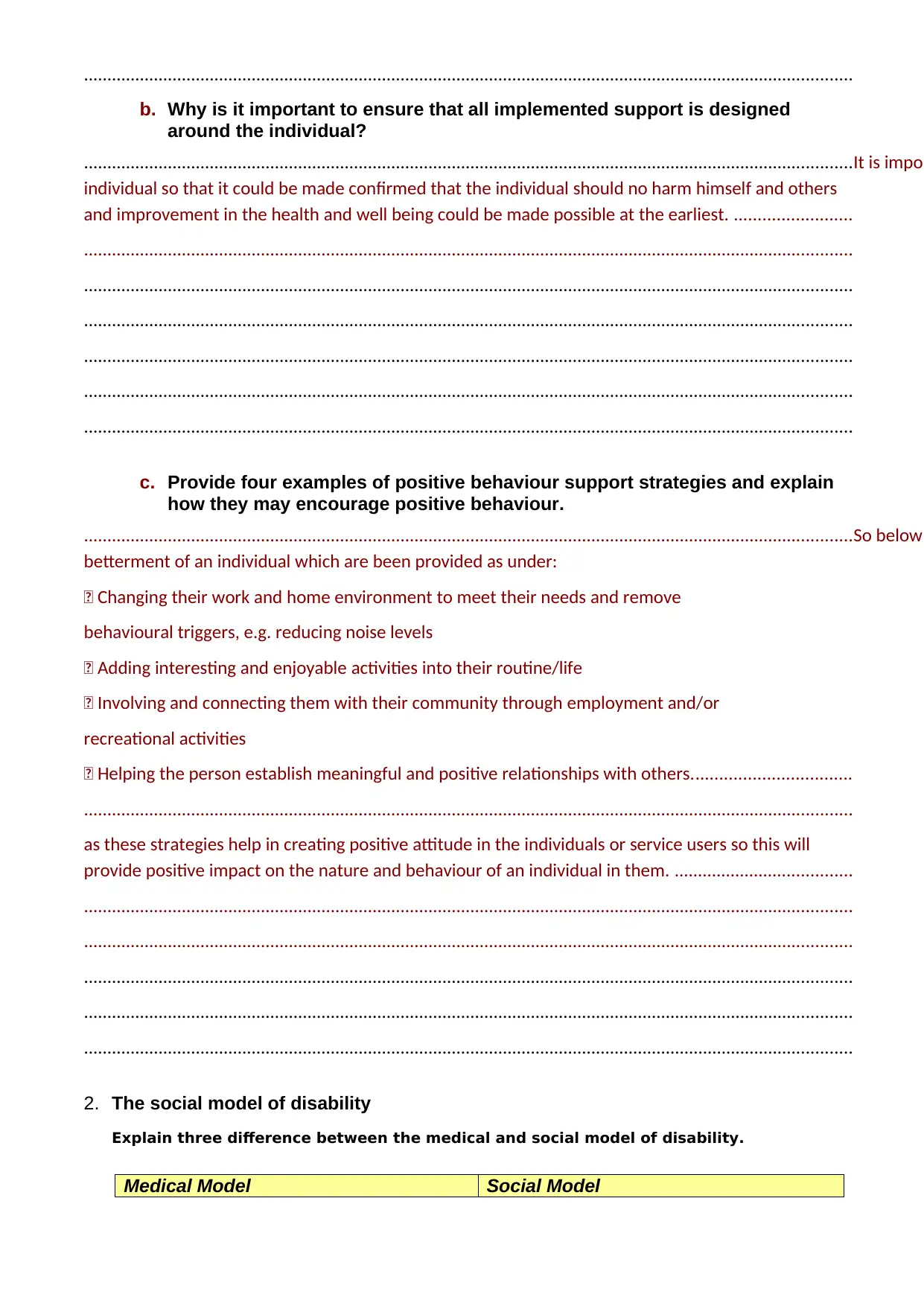
.....................................................................................................................................................................
b. Why is it important to ensure that all implemented support is designed
around the individual?
.....................................................................................................................................................................It is impor
individual so that it could be made confirmed that the individual should no harm himself and others
and improvement in the health and well being could be made possible at the earliest. .........................
.....................................................................................................................................................................
.....................................................................................................................................................................
.....................................................................................................................................................................
.....................................................................................................................................................................
.....................................................................................................................................................................
.....................................................................................................................................................................
c. Provide four examples of positive behaviour support strategies and explain
how they may encourage positive behaviour.
.....................................................................................................................................................................So below
betterment of an individual which are been provided as under:
Changing their work and home environment to meet their needs and remove
behavioural triggers, e.g. reducing noise levels
Adding interesting and enjoyable activities into their routine/life
Involving and connecting them with their community through employment and/or
recreational activities
Helping the person establish meaningful and positive relationships with others..................................
.....................................................................................................................................................................
as these strategies help in creating positive attitude in the individuals or service users so this will
provide positive impact on the nature and behaviour of an individual in them. ......................................
.....................................................................................................................................................................
.....................................................................................................................................................................
.....................................................................................................................................................................
.....................................................................................................................................................................
.....................................................................................................................................................................
2. The social model of disability
Explain three difference between the medical and social model of disability.
Medical Model Social Model
b. Why is it important to ensure that all implemented support is designed
around the individual?
.....................................................................................................................................................................It is impor
individual so that it could be made confirmed that the individual should no harm himself and others
and improvement in the health and well being could be made possible at the earliest. .........................
.....................................................................................................................................................................
.....................................................................................................................................................................
.....................................................................................................................................................................
.....................................................................................................................................................................
.....................................................................................................................................................................
.....................................................................................................................................................................
c. Provide four examples of positive behaviour support strategies and explain
how they may encourage positive behaviour.
.....................................................................................................................................................................So below
betterment of an individual which are been provided as under:
Changing their work and home environment to meet their needs and remove
behavioural triggers, e.g. reducing noise levels
Adding interesting and enjoyable activities into their routine/life
Involving and connecting them with their community through employment and/or
recreational activities
Helping the person establish meaningful and positive relationships with others..................................
.....................................................................................................................................................................
as these strategies help in creating positive attitude in the individuals or service users so this will
provide positive impact on the nature and behaviour of an individual in them. ......................................
.....................................................................................................................................................................
.....................................................................................................................................................................
.....................................................................................................................................................................
.....................................................................................................................................................................
.....................................................................................................................................................................
2. The social model of disability
Explain three difference between the medical and social model of disability.
Medical Model Social Model
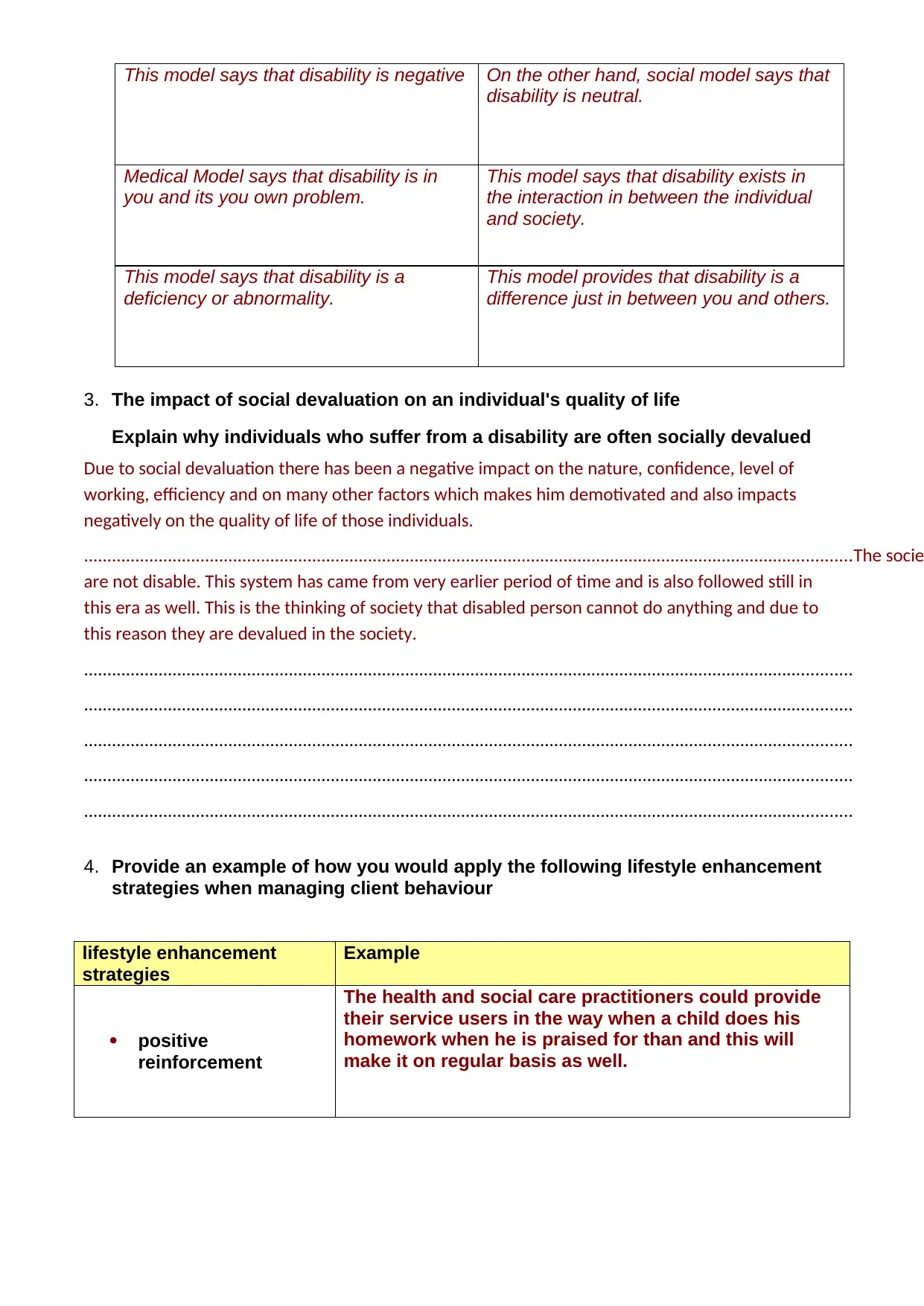
This model says that disability is negative On the other hand, social model says that
disability is neutral.
Medical Model says that disability is in
you and its you own problem.
This model says that disability exists in
the interaction in between the individual
and society.
This model says that disability is a
deficiency or abnormality.
This model provides that disability is a
difference just in between you and others.
3. The impact of social devaluation on an individual's quality of life
Explain why individuals who suffer from a disability are often socially devalued
Due to social devaluation there has been a negative impact on the nature, confidence, level of
working, efficiency and on many other factors which makes him demotivated and also impacts
negatively on the quality of life of those individuals.
.....................................................................................................................................................................The socie
are not disable. This system has came from very earlier period of time and is also followed still in
this era as well. This is the thinking of society that disabled person cannot do anything and due to
this reason they are devalued in the society.
.....................................................................................................................................................................
.....................................................................................................................................................................
.....................................................................................................................................................................
.....................................................................................................................................................................
.....................................................................................................................................................................
4. Provide an example of how you would apply the following lifestyle enhancement
strategies when managing client behaviour
lifestyle enhancement
strategies
Example
positive
reinforcement
The health and social care practitioners could provide
their service users in the way when a child does his
homework when he is praised for than and this will
make it on regular basis as well.
disability is neutral.
Medical Model says that disability is in
you and its you own problem.
This model says that disability exists in
the interaction in between the individual
and society.
This model says that disability is a
deficiency or abnormality.
This model provides that disability is a
difference just in between you and others.
3. The impact of social devaluation on an individual's quality of life
Explain why individuals who suffer from a disability are often socially devalued
Due to social devaluation there has been a negative impact on the nature, confidence, level of
working, efficiency and on many other factors which makes him demotivated and also impacts
negatively on the quality of life of those individuals.
.....................................................................................................................................................................The socie
are not disable. This system has came from very earlier period of time and is also followed still in
this era as well. This is the thinking of society that disabled person cannot do anything and due to
this reason they are devalued in the society.
.....................................................................................................................................................................
.....................................................................................................................................................................
.....................................................................................................................................................................
.....................................................................................................................................................................
.....................................................................................................................................................................
4. Provide an example of how you would apply the following lifestyle enhancement
strategies when managing client behaviour
lifestyle enhancement
strategies
Example
positive
reinforcement
The health and social care practitioners could provide
their service users in the way when a child does his
homework when he is praised for than and this will
make it on regular basis as well.
Secure Best Marks with AI Grader
Need help grading? Try our AI Grader for instant feedback on your assignments.
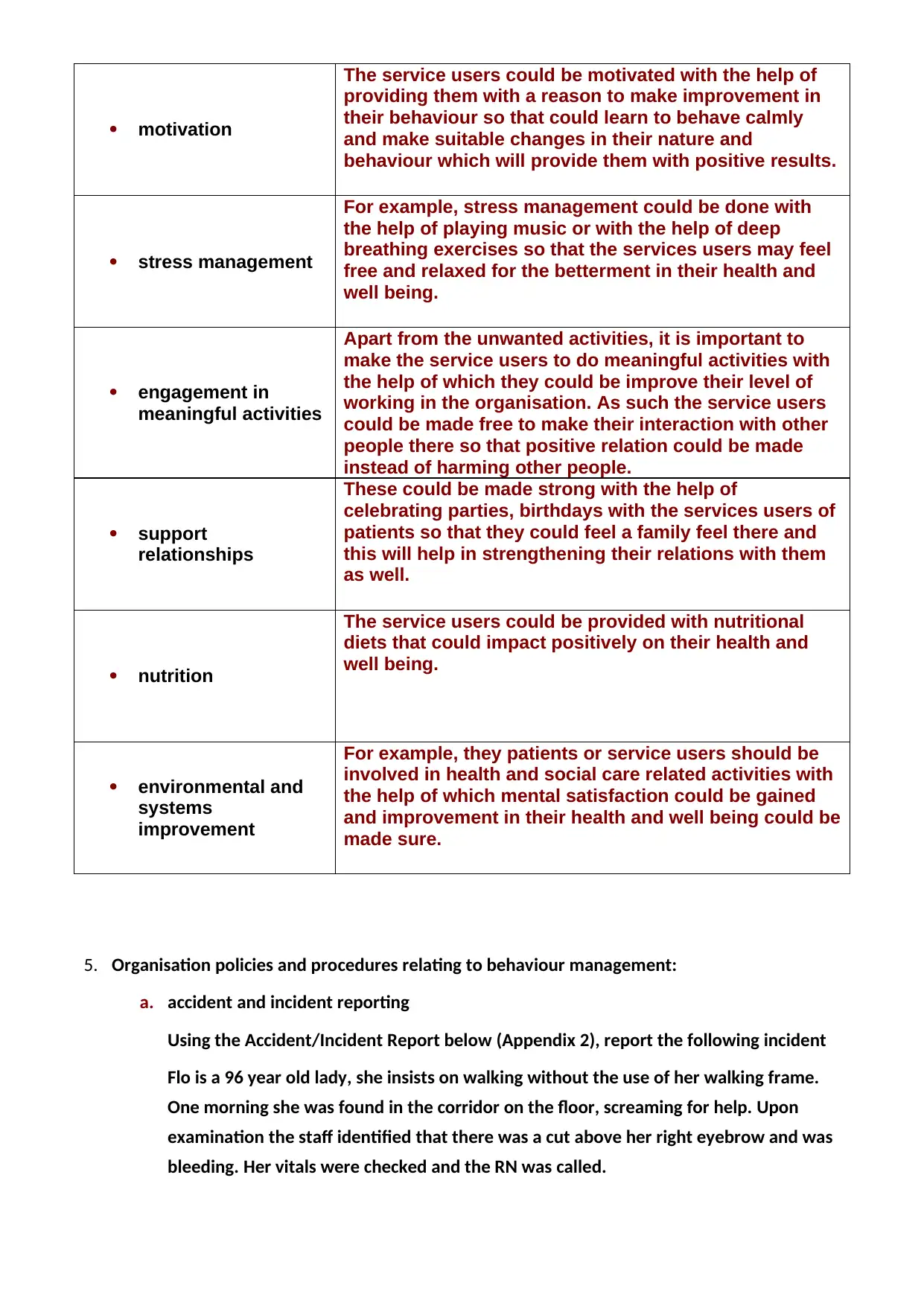
motivation
The service users could be motivated with the help of
providing them with a reason to make improvement in
their behaviour so that could learn to behave calmly
and make suitable changes in their nature and
behaviour which will provide them with positive results.
stress management
For example, stress management could be done with
the help of playing music or with the help of deep
breathing exercises so that the services users may feel
free and relaxed for the betterment in their health and
well being.
engagement in
meaningful activities
Apart from the unwanted activities, it is important to
make the service users to do meaningful activities with
the help of which they could be improve their level of
working in the organisation. As such the service users
could be made free to make their interaction with other
people there so that positive relation could be made
instead of harming other people.
support
relationships
These could be made strong with the help of
celebrating parties, birthdays with the services users of
patients so that they could feel a family feel there and
this will help in strengthening their relations with them
as well.
nutrition
The service users could be provided with nutritional
diets that could impact positively on their health and
well being.
environmental and
systems
improvement
For example, they patients or service users should be
involved in health and social care related activities with
the help of which mental satisfaction could be gained
and improvement in their health and well being could be
made sure.
5. Organisation policies and procedures relating to behaviour management:
a. accident and incident reporting
Using the Accident/Incident Report below (Appendix 2), report the following incident
Flo is a 96 year old lady, she insists on walking without the use of her walking frame.
One morning she was found in the corridor on the floor, screaming for help. Upon
examination the staff identified that there was a cut above her right eyebrow and was
bleeding. Her vitals were checked and the RN was called.
The service users could be motivated with the help of
providing them with a reason to make improvement in
their behaviour so that could learn to behave calmly
and make suitable changes in their nature and
behaviour which will provide them with positive results.
stress management
For example, stress management could be done with
the help of playing music or with the help of deep
breathing exercises so that the services users may feel
free and relaxed for the betterment in their health and
well being.
engagement in
meaningful activities
Apart from the unwanted activities, it is important to
make the service users to do meaningful activities with
the help of which they could be improve their level of
working in the organisation. As such the service users
could be made free to make their interaction with other
people there so that positive relation could be made
instead of harming other people.
support
relationships
These could be made strong with the help of
celebrating parties, birthdays with the services users of
patients so that they could feel a family feel there and
this will help in strengthening their relations with them
as well.
nutrition
The service users could be provided with nutritional
diets that could impact positively on their health and
well being.
environmental and
systems
improvement
For example, they patients or service users should be
involved in health and social care related activities with
the help of which mental satisfaction could be gained
and improvement in their health and well being could be
made sure.
5. Organisation policies and procedures relating to behaviour management:
a. accident and incident reporting
Using the Accident/Incident Report below (Appendix 2), report the following incident
Flo is a 96 year old lady, she insists on walking without the use of her walking frame.
One morning she was found in the corridor on the floor, screaming for help. Upon
examination the staff identified that there was a cut above her right eyebrow and was
bleeding. Her vitals were checked and the RN was called.
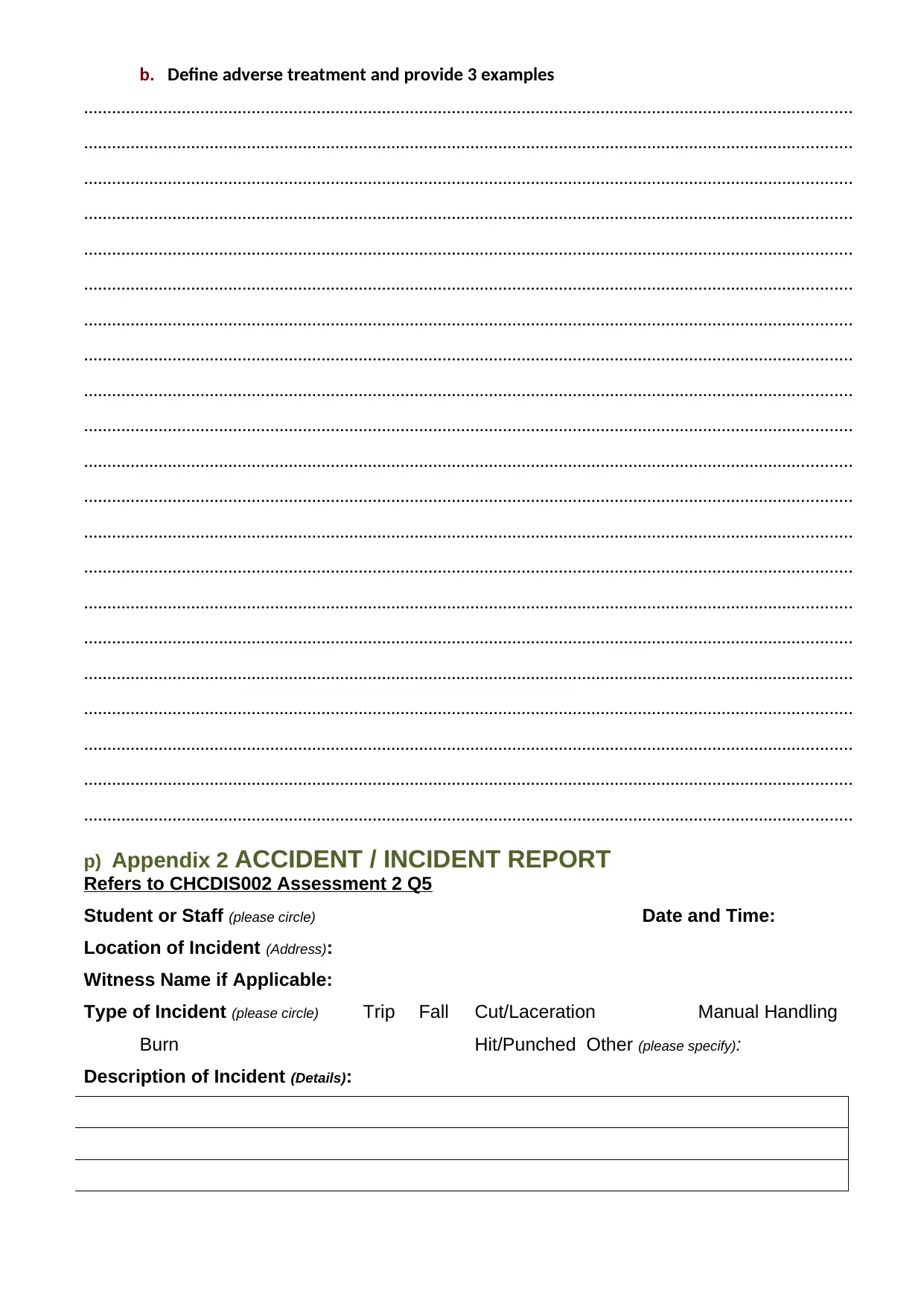
b. Define adverse treatment and provide 3 examples
.....................................................................................................................................................................
.....................................................................................................................................................................
.....................................................................................................................................................................
.....................................................................................................................................................................
.....................................................................................................................................................................
.....................................................................................................................................................................
.....................................................................................................................................................................
.....................................................................................................................................................................
.....................................................................................................................................................................
.....................................................................................................................................................................
.....................................................................................................................................................................
.....................................................................................................................................................................
.....................................................................................................................................................................
.....................................................................................................................................................................
.....................................................................................................................................................................
.....................................................................................................................................................................
.....................................................................................................................................................................
.....................................................................................................................................................................
.....................................................................................................................................................................
.....................................................................................................................................................................
.....................................................................................................................................................................
p) Appendix 2 ACCIDENT / INCIDENT REPORT
Refers to CHCDIS002 Assessment 2 Q5
Student or Staff (please circle) Date and Time:
Location of Incident (Address):
Witness Name if Applicable:
Type of Incident (please circle) Trip Fall Cut/Laceration Manual Handling
Burn Hit/Punched Other (please specify):
Description of Incident (Details):
.....................................................................................................................................................................
.....................................................................................................................................................................
.....................................................................................................................................................................
.....................................................................................................................................................................
.....................................................................................................................................................................
.....................................................................................................................................................................
.....................................................................................................................................................................
.....................................................................................................................................................................
.....................................................................................................................................................................
.....................................................................................................................................................................
.....................................................................................................................................................................
.....................................................................................................................................................................
.....................................................................................................................................................................
.....................................................................................................................................................................
.....................................................................................................................................................................
.....................................................................................................................................................................
.....................................................................................................................................................................
.....................................................................................................................................................................
.....................................................................................................................................................................
.....................................................................................................................................................................
.....................................................................................................................................................................
p) Appendix 2 ACCIDENT / INCIDENT REPORT
Refers to CHCDIS002 Assessment 2 Q5
Student or Staff (please circle) Date and Time:
Location of Incident (Address):
Witness Name if Applicable:
Type of Incident (please circle) Trip Fall Cut/Laceration Manual Handling
Burn Hit/Punched Other (please specify):
Description of Incident (Details):
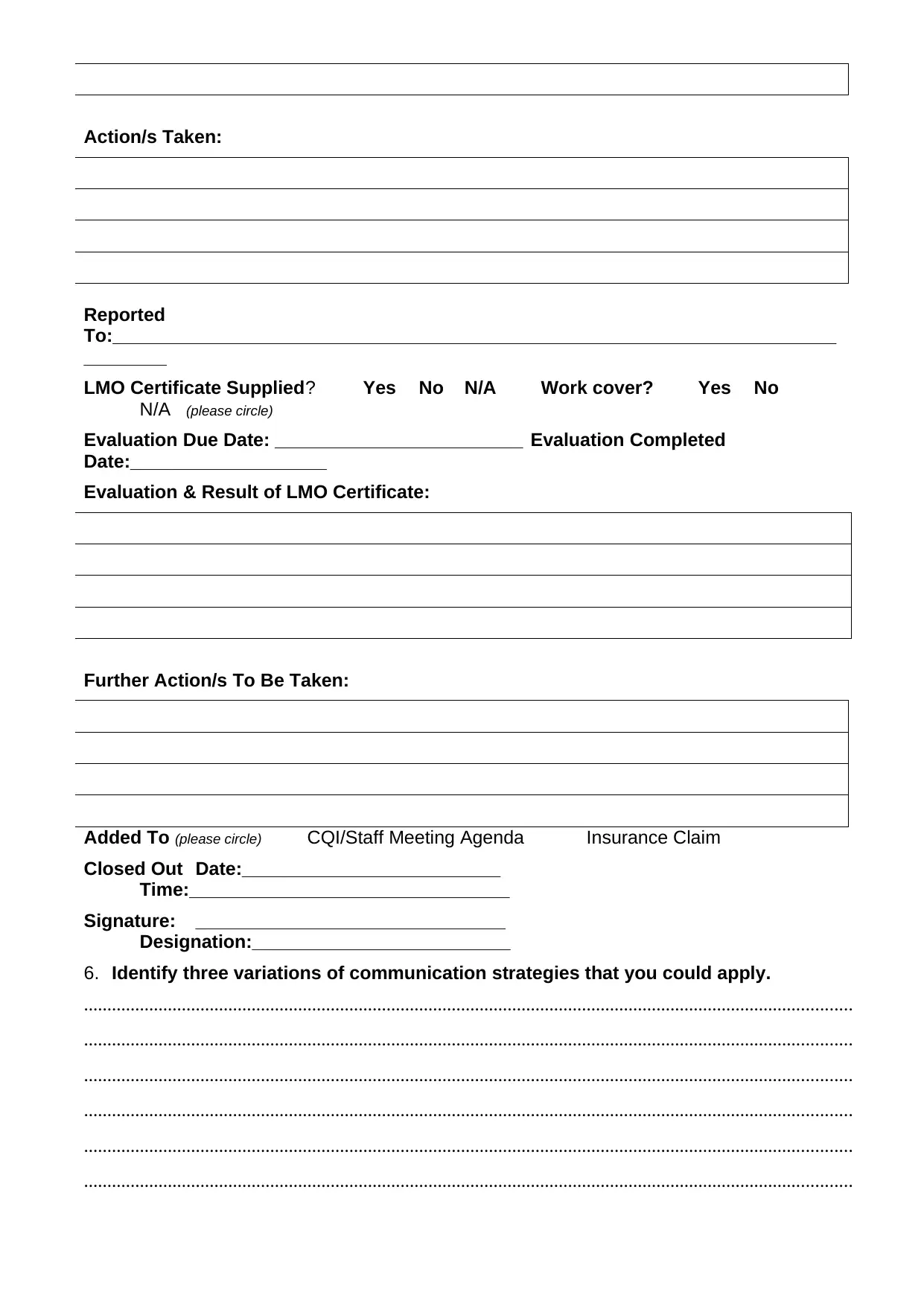
Action/s Taken:
Reported
To:______________________________________________________________________
________
LMO Certificate Supplied? Yes No N/A Work cover? Yes No
N/A (please circle)
Evaluation Due Date: ________________________ Evaluation Completed
Date:___________________
Evaluation & Result of LMO Certificate:
Further Action/s To Be Taken:
Added To (please circle) CQI/Staff Meeting Agenda Insurance Claim
Closed Out Date:_________________________
Time:_______________________________
Signature: ______________________________
Designation:_________________________
6. Identify three variations of communication strategies that you could apply.
.....................................................................................................................................................................
.....................................................................................................................................................................
.....................................................................................................................................................................
.....................................................................................................................................................................
.....................................................................................................................................................................
.....................................................................................................................................................................
Reported
To:______________________________________________________________________
________
LMO Certificate Supplied? Yes No N/A Work cover? Yes No
N/A (please circle)
Evaluation Due Date: ________________________ Evaluation Completed
Date:___________________
Evaluation & Result of LMO Certificate:
Further Action/s To Be Taken:
Added To (please circle) CQI/Staff Meeting Agenda Insurance Claim
Closed Out Date:_________________________
Time:_______________________________
Signature: ______________________________
Designation:_________________________
6. Identify three variations of communication strategies that you could apply.
.....................................................................................................................................................................
.....................................................................................................................................................................
.....................................................................................................................................................................
.....................................................................................................................................................................
.....................................................................................................................................................................
.....................................................................................................................................................................
Paraphrase This Document
Need a fresh take? Get an instant paraphrase of this document with our AI Paraphraser
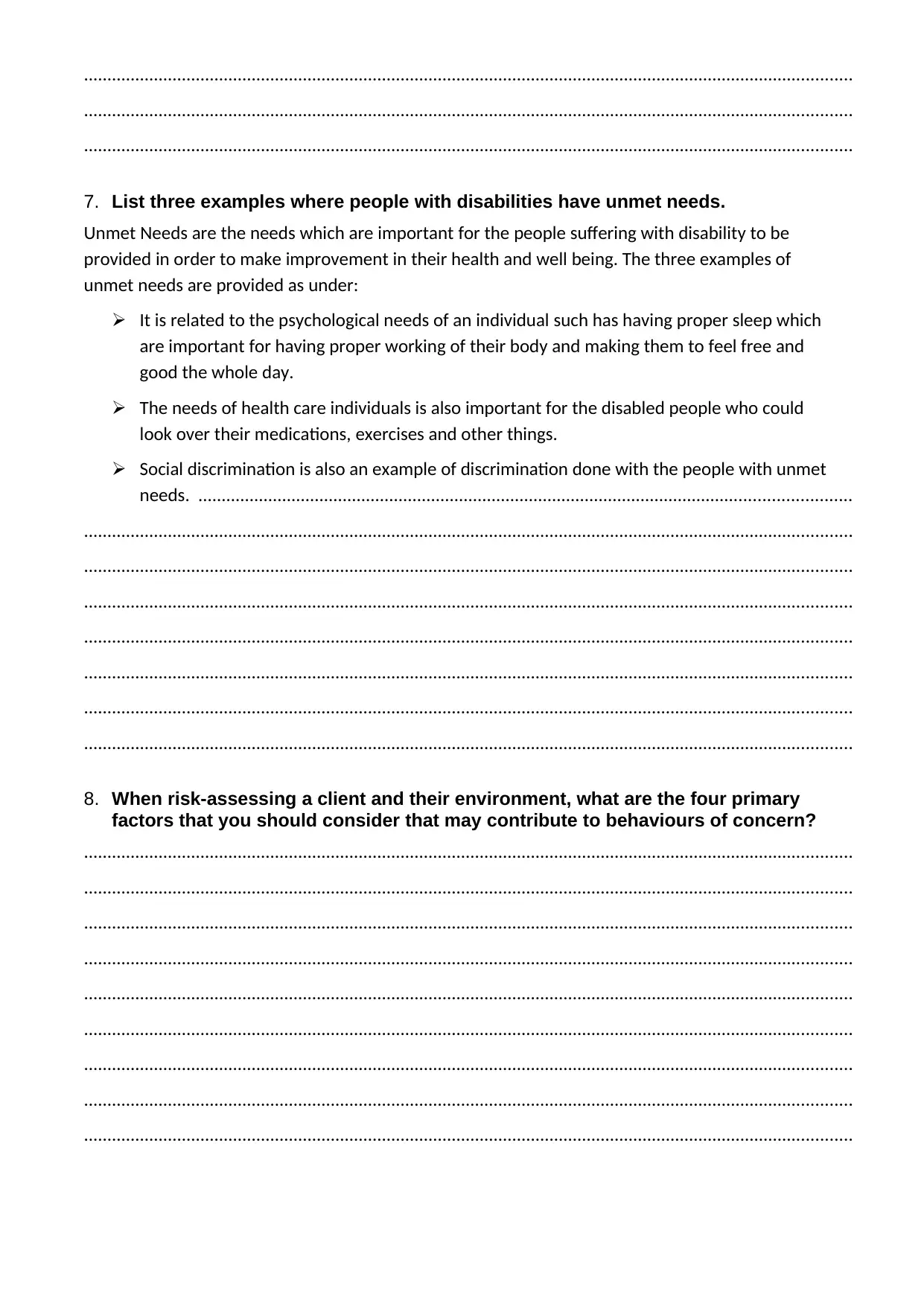
.....................................................................................................................................................................
.....................................................................................................................................................................
.....................................................................................................................................................................
7. List three examples where people with disabilities have unmet needs.
Unmet Needs are the needs which are important for the people suffering with disability to be
provided in order to make improvement in their health and well being. The three examples of
unmet needs are provided as under:
It is related to the psychological needs of an individual such has having proper sleep which
are important for having proper working of their body and making them to feel free and
good the whole day.
The needs of health care individuals is also important for the disabled people who could
look over their medications, exercises and other things.
Social discrimination is also an example of discrimination done with the people with unmet
needs. ............................................................................................................................................
.....................................................................................................................................................................
.....................................................................................................................................................................
.....................................................................................................................................................................
.....................................................................................................................................................................
.....................................................................................................................................................................
.....................................................................................................................................................................
.....................................................................................................................................................................
8. When risk-assessing a client and their environment, what are the four primary
factors that you should consider that may contribute to behaviours of concern?
.....................................................................................................................................................................
.....................................................................................................................................................................
.....................................................................................................................................................................
.....................................................................................................................................................................
.....................................................................................................................................................................
.....................................................................................................................................................................
.....................................................................................................................................................................
.....................................................................................................................................................................
.....................................................................................................................................................................
.....................................................................................................................................................................
.....................................................................................................................................................................
7. List three examples where people with disabilities have unmet needs.
Unmet Needs are the needs which are important for the people suffering with disability to be
provided in order to make improvement in their health and well being. The three examples of
unmet needs are provided as under:
It is related to the psychological needs of an individual such has having proper sleep which
are important for having proper working of their body and making them to feel free and
good the whole day.
The needs of health care individuals is also important for the disabled people who could
look over their medications, exercises and other things.
Social discrimination is also an example of discrimination done with the people with unmet
needs. ............................................................................................................................................
.....................................................................................................................................................................
.....................................................................................................................................................................
.....................................................................................................................................................................
.....................................................................................................................................................................
.....................................................................................................................................................................
.....................................................................................................................................................................
.....................................................................................................................................................................
8. When risk-assessing a client and their environment, what are the four primary
factors that you should consider that may contribute to behaviours of concern?
.....................................................................................................................................................................
.....................................................................................................................................................................
.....................................................................................................................................................................
.....................................................................................................................................................................
.....................................................................................................................................................................
.....................................................................................................................................................................
.....................................................................................................................................................................
.....................................................................................................................................................................
.....................................................................................................................................................................
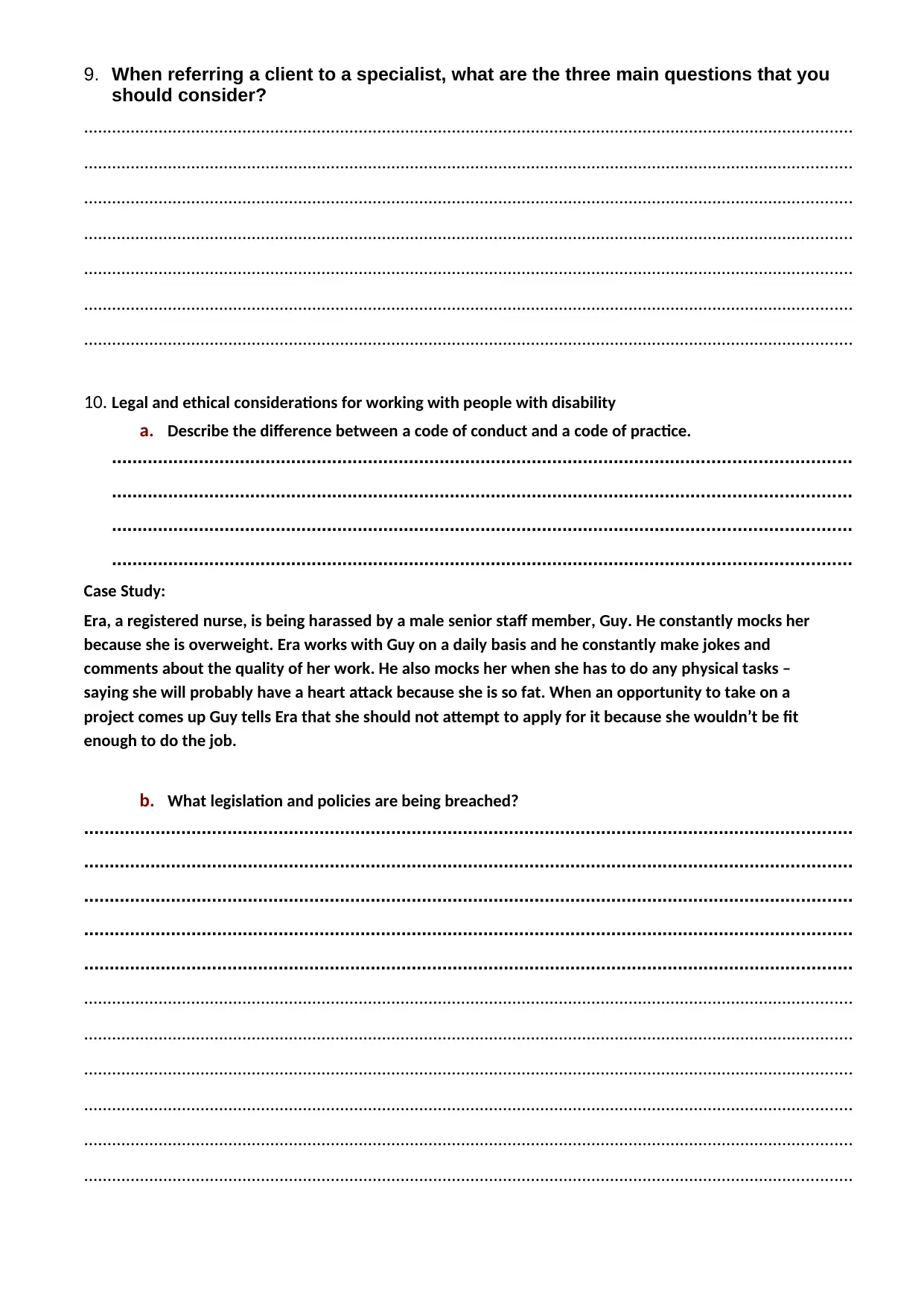
9. When referring a client to a specialist, what are the three main questions that you
should consider?
.....................................................................................................................................................................
.....................................................................................................................................................................
.....................................................................................................................................................................
.....................................................................................................................................................................
.....................................................................................................................................................................
.....................................................................................................................................................................
.....................................................................................................................................................................
10. Legal and ethical considerations for working with people with disability
a. Describe the difference between a code of conduct and a code of practice.
................................................................................................................................................
................................................................................................................................................
................................................................................................................................................
................................................................................................................................................
Case Study:
Era, a registered nurse, is being harassed by a male senior staff member, Guy. He constantly mocks her
because she is overweight. Era works with Guy on a daily basis and he constantly make jokes and
comments about the quality of her work. He also mocks her when she has to do any physical tasks –
saying she will probably have a heart attack because she is so fat. When an opportunity to take on a
project comes up Guy tells Era that she should not attempt to apply for it because she wouldn’t be fit
enough to do the job.
b. What legislation and policies are being breached?
......................................................................................................................................................
......................................................................................................................................................
......................................................................................................................................................
......................................................................................................................................................
......................................................................................................................................................
.....................................................................................................................................................................
.....................................................................................................................................................................
.....................................................................................................................................................................
.....................................................................................................................................................................
.....................................................................................................................................................................
.....................................................................................................................................................................
should consider?
.....................................................................................................................................................................
.....................................................................................................................................................................
.....................................................................................................................................................................
.....................................................................................................................................................................
.....................................................................................................................................................................
.....................................................................................................................................................................
.....................................................................................................................................................................
10. Legal and ethical considerations for working with people with disability
a. Describe the difference between a code of conduct and a code of practice.
................................................................................................................................................
................................................................................................................................................
................................................................................................................................................
................................................................................................................................................
Case Study:
Era, a registered nurse, is being harassed by a male senior staff member, Guy. He constantly mocks her
because she is overweight. Era works with Guy on a daily basis and he constantly make jokes and
comments about the quality of her work. He also mocks her when she has to do any physical tasks –
saying she will probably have a heart attack because she is so fat. When an opportunity to take on a
project comes up Guy tells Era that she should not attempt to apply for it because she wouldn’t be fit
enough to do the job.
b. What legislation and policies are being breached?
......................................................................................................................................................
......................................................................................................................................................
......................................................................................................................................................
......................................................................................................................................................
......................................................................................................................................................
.....................................................................................................................................................................
.....................................................................................................................................................................
.....................................................................................................................................................................
.....................................................................................................................................................................
.....................................................................................................................................................................
.....................................................................................................................................................................
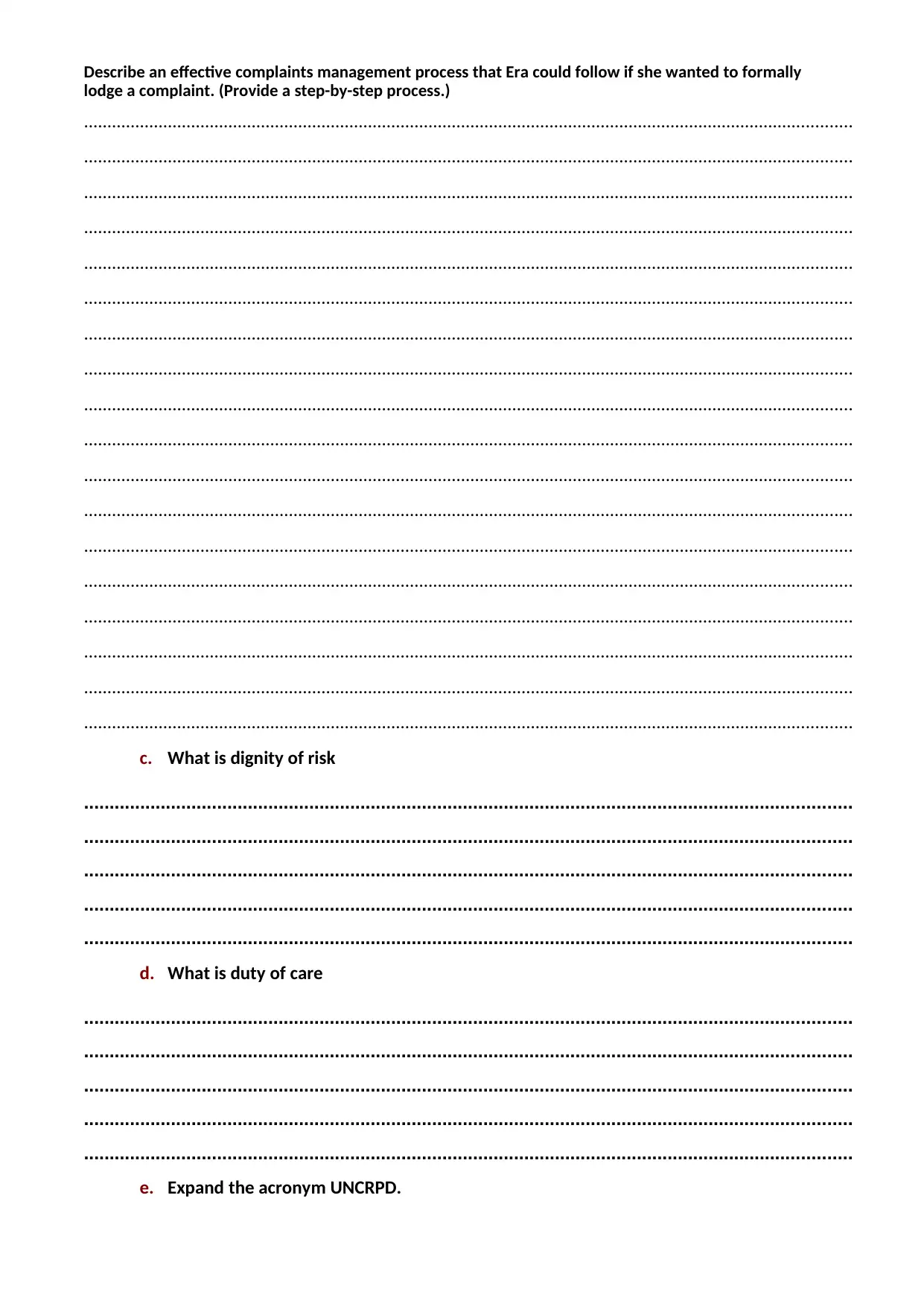
Describe an effective complaints management process that Era could follow if she wanted to formally
lodge a complaint. (Provide a step-by-step process.)
.....................................................................................................................................................................
.....................................................................................................................................................................
.....................................................................................................................................................................
.....................................................................................................................................................................
.....................................................................................................................................................................
.....................................................................................................................................................................
.....................................................................................................................................................................
.....................................................................................................................................................................
.....................................................................................................................................................................
.....................................................................................................................................................................
.....................................................................................................................................................................
.....................................................................................................................................................................
.....................................................................................................................................................................
.....................................................................................................................................................................
.....................................................................................................................................................................
.....................................................................................................................................................................
.....................................................................................................................................................................
.....................................................................................................................................................................
c. What is dignity of risk
......................................................................................................................................................
......................................................................................................................................................
......................................................................................................................................................
......................................................................................................................................................
......................................................................................................................................................
d. What is duty of care
......................................................................................................................................................
......................................................................................................................................................
......................................................................................................................................................
......................................................................................................................................................
......................................................................................................................................................
e. Expand the acronym UNCRPD.
lodge a complaint. (Provide a step-by-step process.)
.....................................................................................................................................................................
.....................................................................................................................................................................
.....................................................................................................................................................................
.....................................................................................................................................................................
.....................................................................................................................................................................
.....................................................................................................................................................................
.....................................................................................................................................................................
.....................................................................................................................................................................
.....................................................................................................................................................................
.....................................................................................................................................................................
.....................................................................................................................................................................
.....................................................................................................................................................................
.....................................................................................................................................................................
.....................................................................................................................................................................
.....................................................................................................................................................................
.....................................................................................................................................................................
.....................................................................................................................................................................
.....................................................................................................................................................................
c. What is dignity of risk
......................................................................................................................................................
......................................................................................................................................................
......................................................................................................................................................
......................................................................................................................................................
......................................................................................................................................................
d. What is duty of care
......................................................................................................................................................
......................................................................................................................................................
......................................................................................................................................................
......................................................................................................................................................
......................................................................................................................................................
e. Expand the acronym UNCRPD.
Secure Best Marks with AI Grader
Need help grading? Try our AI Grader for instant feedback on your assignments.
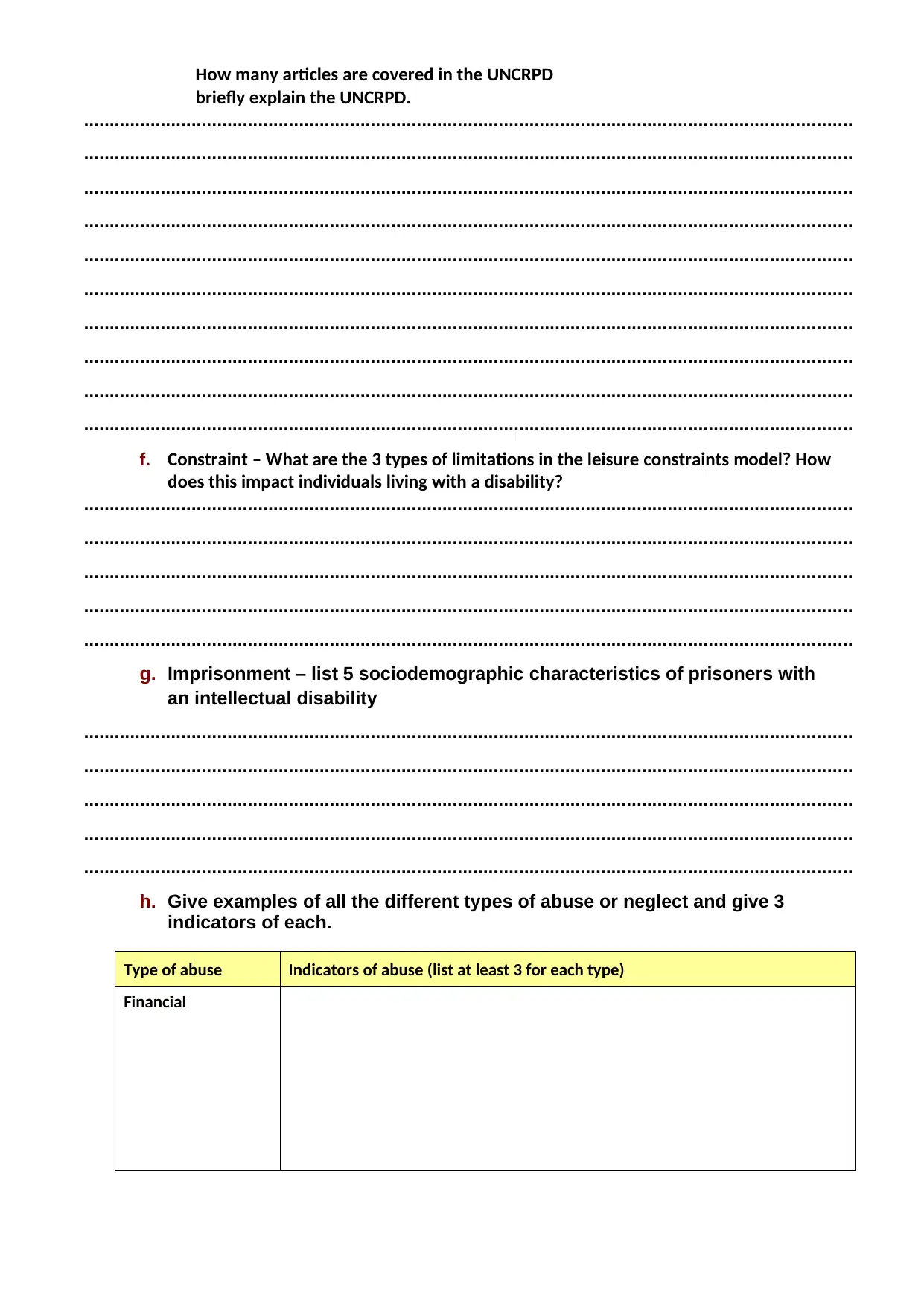
How many articles are covered in the UNCRPD
briefly explain the UNCRPD.
......................................................................................................................................................
......................................................................................................................................................
......................................................................................................................................................
......................................................................................................................................................
......................................................................................................................................................
......................................................................................................................................................
......................................................................................................................................................
......................................................................................................................................................
......................................................................................................................................................
......................................................................................................................................................
f. Constraint – What are the 3 types of limitations in the leisure constraints model? How
does this impact individuals living with a disability?
......................................................................................................................................................
......................................................................................................................................................
......................................................................................................................................................
......................................................................................................................................................
......................................................................................................................................................
g. Imprisonment – list 5 sociodemographic characteristics of prisoners with
an intellectual disability
......................................................................................................................................................
......................................................................................................................................................
......................................................................................................................................................
......................................................................................................................................................
......................................................................................................................................................
h. Give examples of all the different types of abuse or neglect and give 3
indicators of each.
Type of abuse Indicators of abuse (list at least 3 for each type)
Financial
briefly explain the UNCRPD.
......................................................................................................................................................
......................................................................................................................................................
......................................................................................................................................................
......................................................................................................................................................
......................................................................................................................................................
......................................................................................................................................................
......................................................................................................................................................
......................................................................................................................................................
......................................................................................................................................................
......................................................................................................................................................
f. Constraint – What are the 3 types of limitations in the leisure constraints model? How
does this impact individuals living with a disability?
......................................................................................................................................................
......................................................................................................................................................
......................................................................................................................................................
......................................................................................................................................................
......................................................................................................................................................
g. Imprisonment – list 5 sociodemographic characteristics of prisoners with
an intellectual disability
......................................................................................................................................................
......................................................................................................................................................
......................................................................................................................................................
......................................................................................................................................................
......................................................................................................................................................
h. Give examples of all the different types of abuse or neglect and give 3
indicators of each.
Type of abuse Indicators of abuse (list at least 3 for each type)
Financial
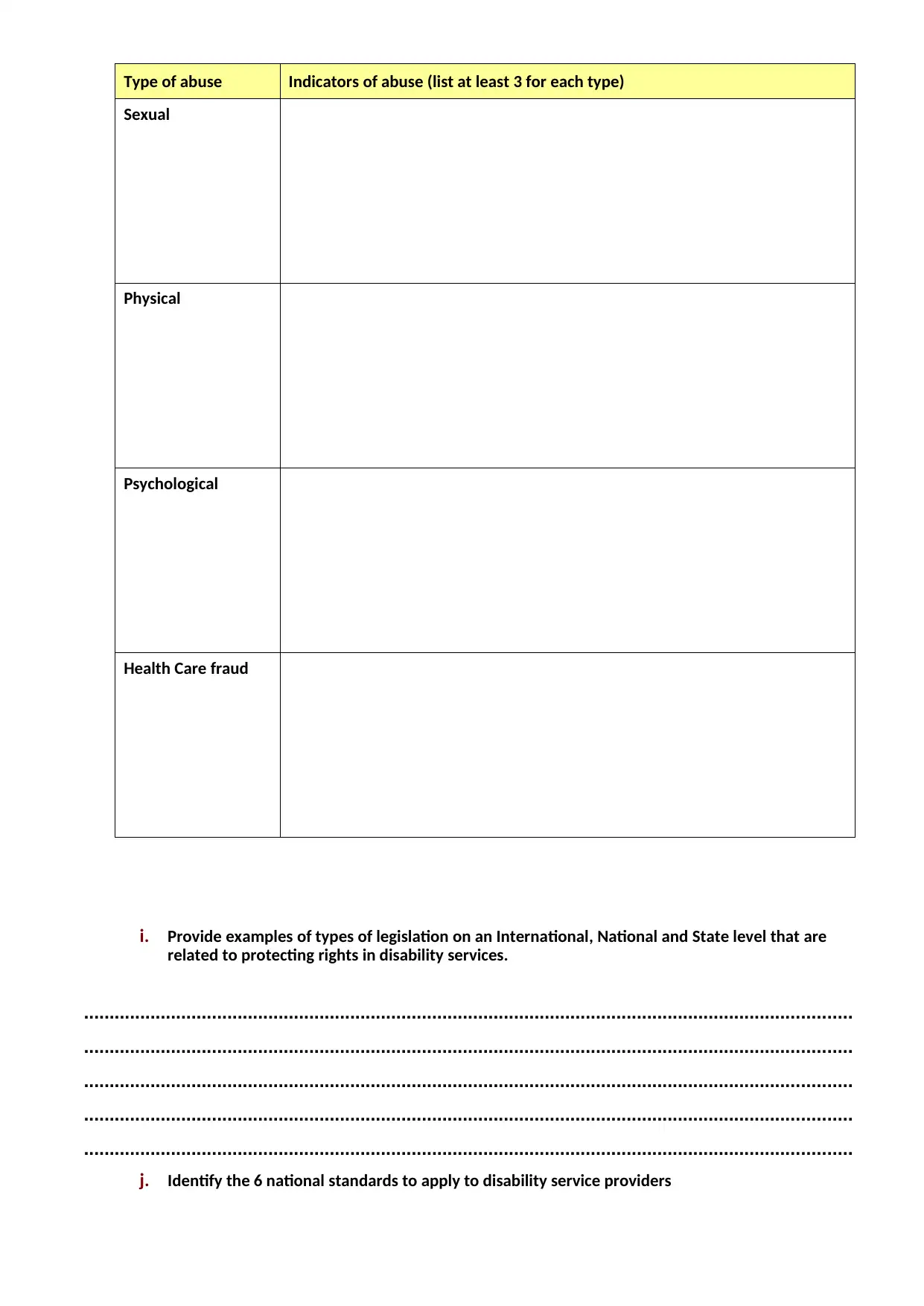
Type of abuse Indicators of abuse (list at least 3 for each type)
Sexual
Physical
Psychological
Health Care fraud
i. Provide examples of types of legislation on an International, National and State level that are
related to protecting rights in disability services.
......................................................................................................................................................
......................................................................................................................................................
......................................................................................................................................................
......................................................................................................................................................
......................................................................................................................................................
j. Identify the 6 national standards to apply to disability service providers
Sexual
Physical
Psychological
Health Care fraud
i. Provide examples of types of legislation on an International, National and State level that are
related to protecting rights in disability services.
......................................................................................................................................................
......................................................................................................................................................
......................................................................................................................................................
......................................................................................................................................................
......................................................................................................................................................
j. Identify the 6 national standards to apply to disability service providers
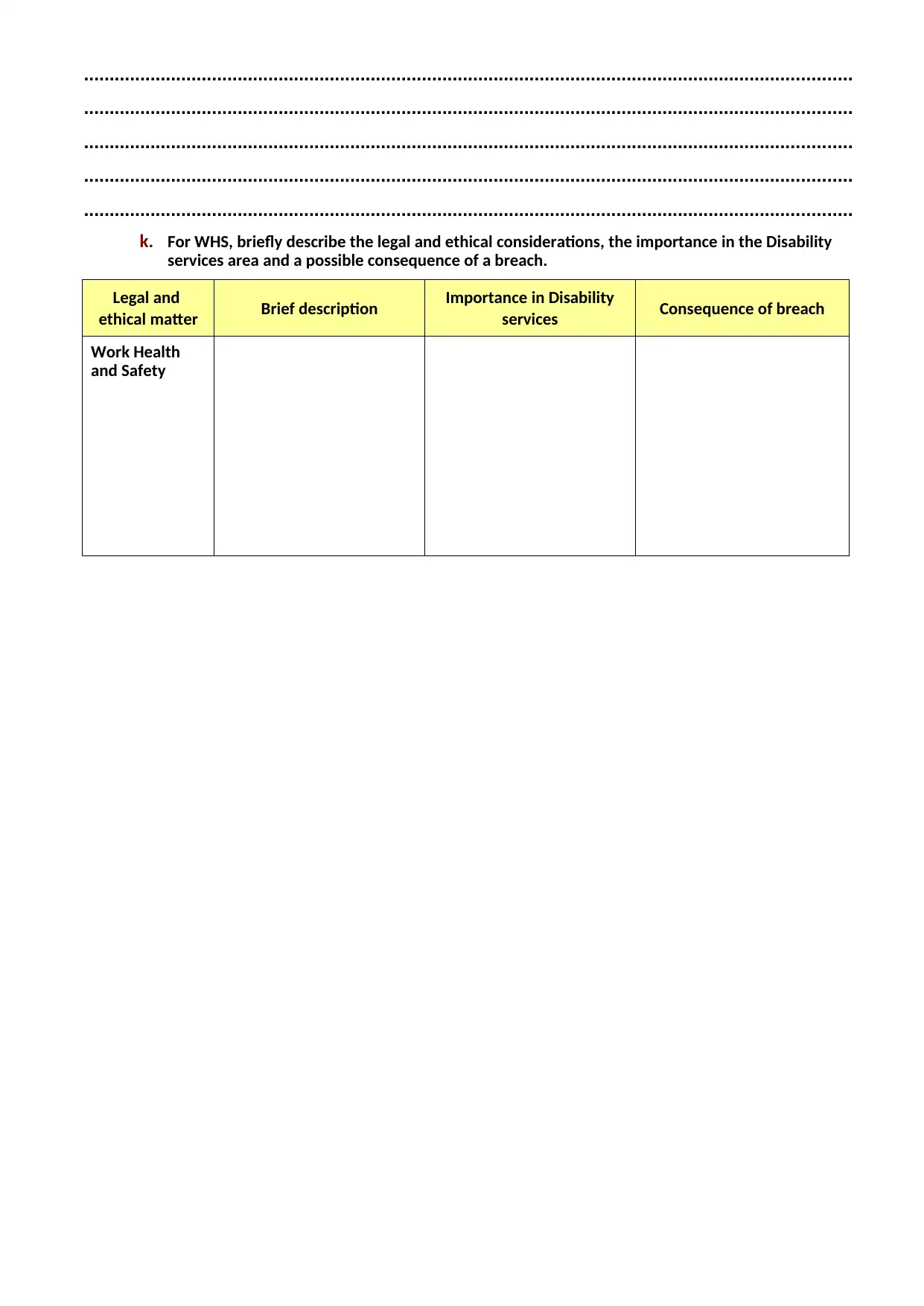
......................................................................................................................................................
......................................................................................................................................................
......................................................................................................................................................
......................................................................................................................................................
......................................................................................................................................................
k. For WHS, briefly describe the legal and ethical considerations, the importance in the Disability
services area and a possible consequence of a breach.
Legal and
ethical matter Brief description Importance in Disability
services Consequence of breach
Work Health
and Safety
......................................................................................................................................................
......................................................................................................................................................
......................................................................................................................................................
......................................................................................................................................................
k. For WHS, briefly describe the legal and ethical considerations, the importance in the Disability
services area and a possible consequence of a breach.
Legal and
ethical matter Brief description Importance in Disability
services Consequence of breach
Work Health
and Safety
Paraphrase This Document
Need a fresh take? Get an instant paraphrase of this document with our AI Paraphraser
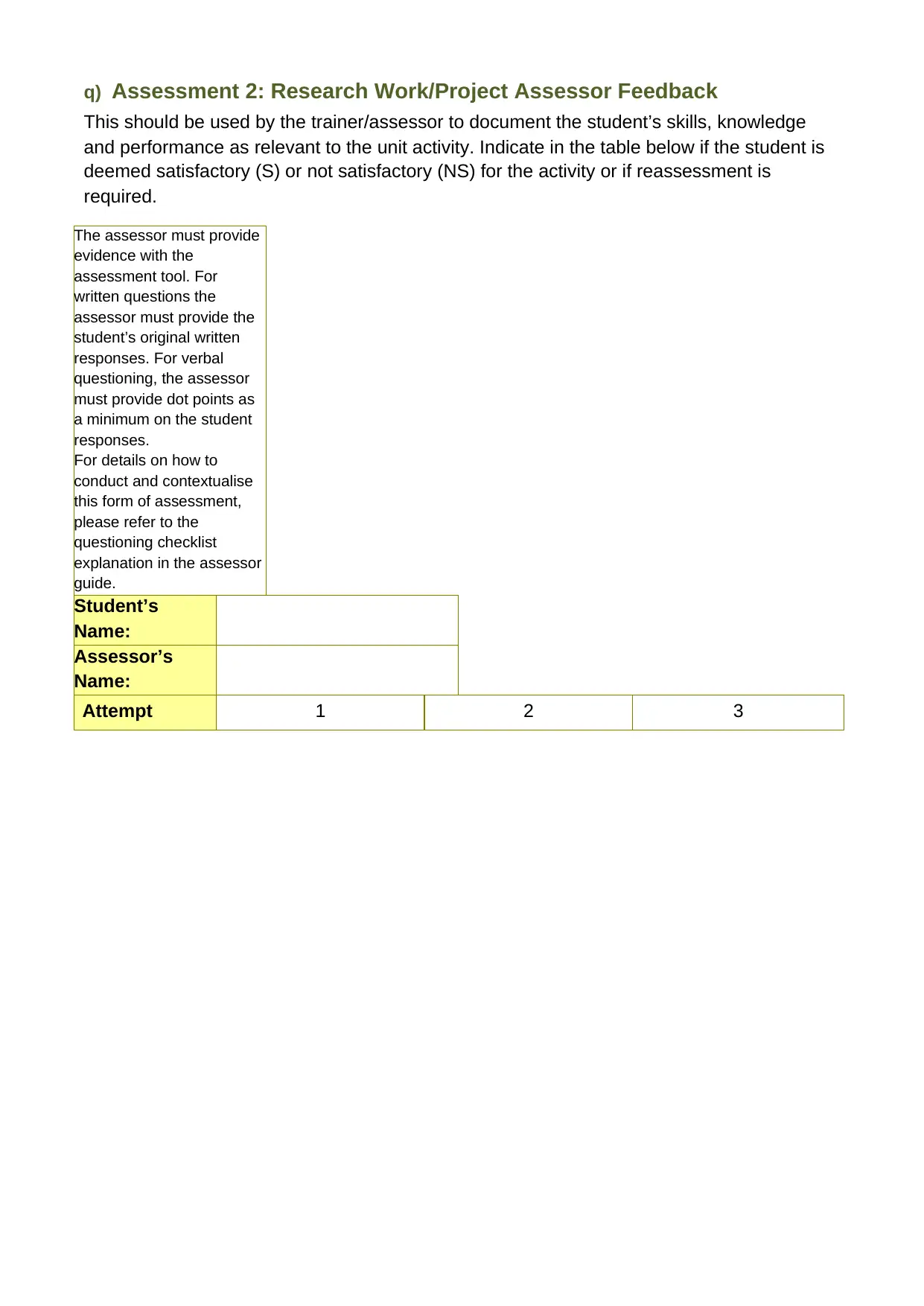
q) Assessment 2: Research Work/Project Assessor Feedback
This should be used by the trainer/assessor to document the student’s skills, knowledge
and performance as relevant to the unit activity. Indicate in the table below if the student is
deemed satisfactory (S) or not satisfactory (NS) for the activity or if reassessment is
required.
The assessor must provide
evidence with the
assessment tool. For
written questions the
assessor must provide the
student’s original written
responses. For verbal
questioning, the assessor
must provide dot points as
a minimum on the student
responses.
For details on how to
conduct and contextualise
this form of assessment,
please refer to the
questioning checklist
explanation in the assessor
guide.
Student’s
Name:
Assessor’s
Name:
Attempt 1 2 3
This should be used by the trainer/assessor to document the student’s skills, knowledge
and performance as relevant to the unit activity. Indicate in the table below if the student is
deemed satisfactory (S) or not satisfactory (NS) for the activity or if reassessment is
required.
The assessor must provide
evidence with the
assessment tool. For
written questions the
assessor must provide the
student’s original written
responses. For verbal
questioning, the assessor
must provide dot points as
a minimum on the student
responses.
For details on how to
conduct and contextualise
this form of assessment,
please refer to the
questioning checklist
explanation in the assessor
guide.
Student’s
Name:
Assessor’s
Name:
Attempt 1 2 3
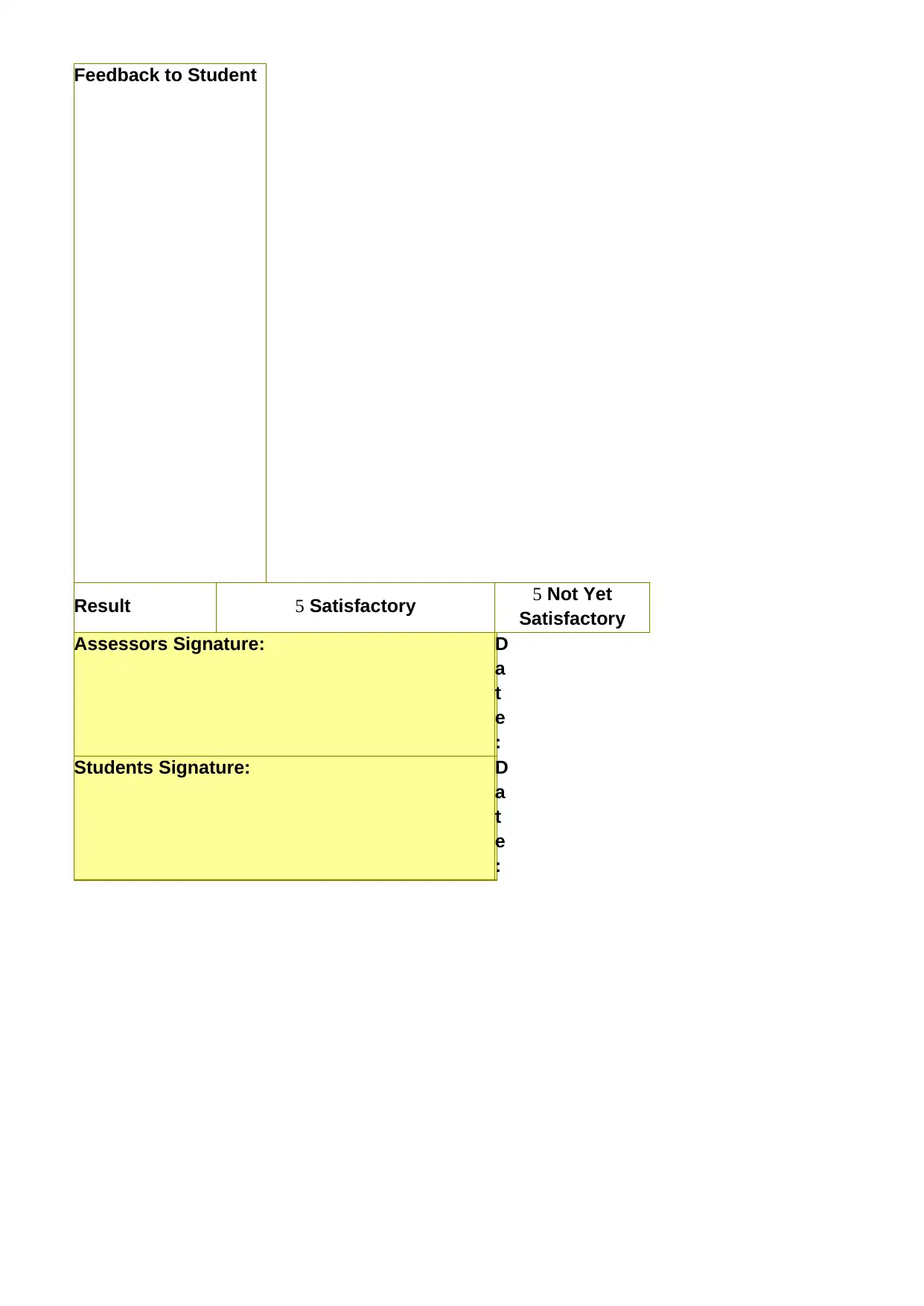
Feedback to Student
Result Satisfactory Not Yet
Satisfactory
Assessors Signature: D
a
t
e
:
Students Signature: D
a
t
e
:
Result Satisfactory Not Yet
Satisfactory
Assessors Signature: D
a
t
e
:
Students Signature: D
a
t
e
:
1 out of 57
Your All-in-One AI-Powered Toolkit for Academic Success.
+13062052269
info@desklib.com
Available 24*7 on WhatsApp / Email
![[object Object]](/_next/static/media/star-bottom.7253800d.svg)
Unlock your academic potential
© 2024 | Zucol Services PVT LTD | All rights reserved.



